|
History menu >
Malvern schools then and now
Since the middle of the nineteenth century Malvern has
been well known as a centre of education, and it is amazing just how many
schools there have been in the town over the years.
Our story about past and present schools in Malvern,
Worcestershire, England, started when we investigated the history of two small plaques in St Mary's Church, Guarlford,
dedicated to the
memory of former pupils of Southlea School, a small preparatory school for
boys
which closed in the 1930s.
After considerable work we were relating our
findings to an acquaintance who said 'Oh I went there'. And so it is that
this page has continued to evolve as we delve into Trade
Directories and people tell us about their school days in Malvern. You may
find some entries rather long, as we have included interesting information
about staff and pupils of those particular schools.
You can use the list
of schools below to jump to any school that has special interest for you, by
clinking on the link. The contents list is in the order we have written
about the schools, not alphabetic; so you may find searching for your school
easier using the Find on page feature of your web browser.
Kelly's Trade Directories of Worcestershire and others
such as Littleburys (copies of
which are held in the Reference section of Great Malvern Library) provide a
unique insight into bygone Malvern, which is how we discovered the many schools
there have been in Malvern, most small, a few relatively large. Even though
we have researched a large number, still more appear and not all are
mentioned here, but it is hoped you find this glimpse into the past
interesting. If you are new to Malvern and looking for a school, we hope you find the list at the end helpful.
We still have information to add, but please do get in
touch if you have photos or stories which could be added to this page.
 Contents Contents
Background
Closed Independent schools
> Southlea School
>> Origins of Southlea
>> More about Southlea and past pupils
> Fairfield
> St Cuthbert's
> Holly Mount
> The Link School
> Lawnside
> The Mount
> Ivydene
> Montpellier
> Hatley St George
> Croftdown
> The Priory
> Cherbourg
> Gratton House
> Fonthill College
> Abbotshill
> Wellington House
> Elmsdale and Malvernbury
> Ellerslie
> The Abbey
> Thorn Bank
> Seaford Court
> Hillside, Malvern Link
> Hillside, West Malvern
> Hillstone
> The Hill
> Langland House
> Douglas House
> Evendine Court
> Fairseat
> Hazel Bank and Amestrey
> Mowbray
> Felthorpe
> The Birches
> The Hollies
> Thomas Essex's academy
in Malvern Wells
> Wells House
> Cambridge House
> The Manse
> Stuart Lodge
> St Hugh's
> Cleeve Court
> Queen Anne's
> St Richard's
> Lindfield
> Clarendon
> St Nicholas
> Wychcrest
> Malvernhurst
> Connellan College
> Other schools
Closed Church and State schools
> Lansdowne
> Newland
> The Lyttelton
> Guarlford
> North Malvern
> Poolbrook
Schools still open in 2012
> Church schools
> State schools
> Independent schools
Photographs
References
Private schools and tutors have provided an education for
the gentry for hundreds of years. It seems that in the early days of the
nineteenth century you needed no formal
qualifications to set up a small private day school, just sufficient financial
backing to lease a large house and buy some desks.
Additionally if you were setting up a school for
boarders you would have required further accommodation, beds, kitchen staff and one or more
matrons. From a prep school, pupils might go on to a senior school, and
for boys possibly to a university. English Universities prior to about 1870 were
mostly restricted to rich men, who had to be members of the Church of England. These universities mainly taught
religion and the arts, and it was not until about 1900 that new universities
started to come into being, offering tuition in science and engineering
modelled on German lines. In Victorian times private boarding schools expanded to
meet the needs of merchants, engineers and
military officers serving abroad in the British Empire, who either wanted or
needed their children (mostly boys) to be educated at home in Britain. In
those days, education of girls was not of high priority, so poor girls
were destined to a life of servitude and hard work, whether married or not,
whilst rich girls hoped to marry someone who would look after them and keep
them in the manner to which they had been accustomed. Schools for young
ladies taught them the skills they would need in married life. WWI
changed that when women were required to take on the jobs of men away at the
front, and afterwards there was a shortage of young men to marry, so
thousands of young women of all classes suddenly found it necessary to pursue careers.
The contraction of the British Empire after WWII together
with the inability of many British parents to afford the fees has led to
pressure on schools in the private sector, despite overseas students being sought to fill the gaps.
The reduction in the number of parents willing and able to afford private
school fees was particularly apparent in the late 1980s when many schools
were forced to either amalgamate or close. Compare this with the situation of Church and state
schools:-
The Industrial Revolution resulted in more skills being needed in the workplace,
requiring for example the ability to read and write, add up, and for some a
basic understanding of engineering and chemical processes.
The passing of the Elementary Education Act in 1870 required the compulsory
universal education of all children between 5 and 10 years.
National
Schools were founded in the 1800s by the 'National Society for Promoting
Religious Education'. These schools provided elementary education, in
accordance with the teaching of the Church of England, to the children of
the poor (ref 1).
Church and state schools grew and adapted to meet the needs of an expanding population, immigration,
movement in centres of population and the changing skills needed in the
workforce.
The discussion about what should be taught and how continues even now to be a
subject of fierce debate as, for example, with the Conservative/Liberal
Democrat Coalition government
of 2010 positioning to take state schools outside Local Education Authority
control in order to give schools and governing bodies that seek it greater
independence and hopefully increasing the quality of education. A very early Malvern school for the poor was called 'The School of
Ancient Industry' for spinning wool, flax, hemp etc. This was in Longridge
Road for some 30 females of
the poorer classes of the parish. The school, which
taught spinning and needlework, was established by Lady Apphia Lyttelton about 1815 and
closed in the 1840s after her death (ref 2).
It was funded by charity. Lady Lyttelton first lived at a black and white cottage
named Peckham Grove in Poolbrook Road (later occupied by Polly Cartland, the
mother of novelist Barbara Cartland). The house was renamed Littlewood House
which is now largely hidden behind a fence and shrubbery, across the road from the 'Three
Horseshoes' (see photo below).
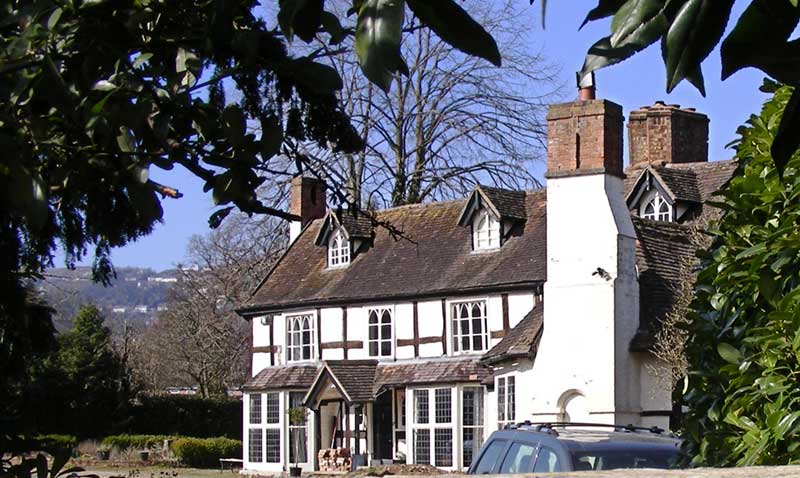
Peckham Grove now Littlewood House
Circa 1821 Lady Lyttelton had a new house built on the east side of Poolbrook Road
which she named Peachfield House. Peachfield
House still stands and has been divided into two houses which can be
found in Hayes Bank Road, just south of St Andrew's church (see white house
in photo below). 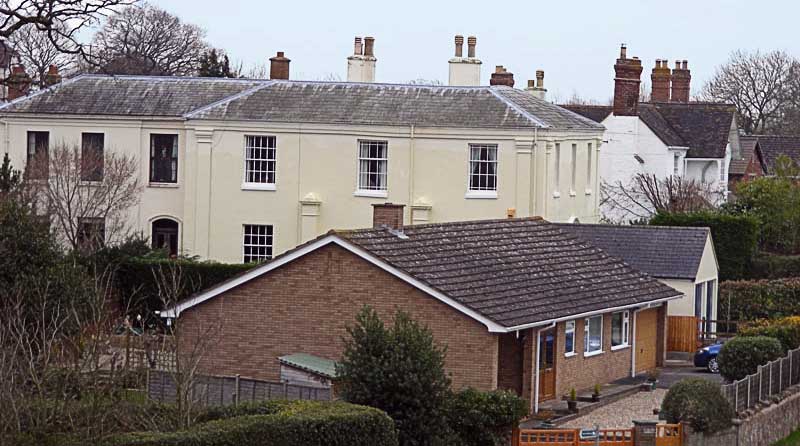
Peachfield House
Education for poorer families in Malvern, up until the
end of the Second World War, would have been mainly provided by Church
Schools.
From 1870 the school leaving age was 10, being raised to
12 by 1899. In 1918 the school leaving age went up to 14; and in 1947 it was
raised again to 15 years. So during this period Church Schools would have
had pupils mostly in the age range 5 to 14 years, with only a very few who
were bright enough, and whose parents could afford it, going on to Grammar
School, for example at Hanley Castle.
About 1902 Local Education Authorities (LEA) had been tasked
with organising and funding state education. The first Council funded
schools in Malvern were Somers Park in 1909 and Great Malvern, on the edge
of Barnards Green, in 1916, augmenting the Church Schools, which by now were
largely funded by the state.
It was not until 1953 that 'The Chase', the first
Council School providing Secondary Education in Malvern, was opened,
followed in 1958 by 'Dyson Perrins'. Before then the majority of pupils
would have left school by age 15 to take up employment.
The Labour Government pursued the introduction of the
'Comprehensive' system of education in the 1970s, when the school leaving
age went up to 16, whilst more recently the Conservative Party has been
encouraging publicly funded schools to become Academy Trusts outside LEA
control, and teenagers to remain in some sort of education until age 18, as
jobs become more skilled.
On the examination front, in the 1970s, there had been a
move towards modules and continuous assessment which some say enabled a
larger percentage of students to achieve high grades. The pendulum now seems
to be swinging the other way, with the Conservative Government of 2015
seeking 'A' levels to be examined at the end of the course, no doubt hoping
for a better spread of marks that might better distinguish between different levels of academic ability.
The COVID-19 pandemic swept the world in 2020 and the
population of the UK isolated in order to protect the NHS and the elderly
while vaccines were developed. Schools were closed for many months, exams
cancelled and grades awarded by teachers.
So it is that the educational system continues to evolve
pragmatically!
Back to top
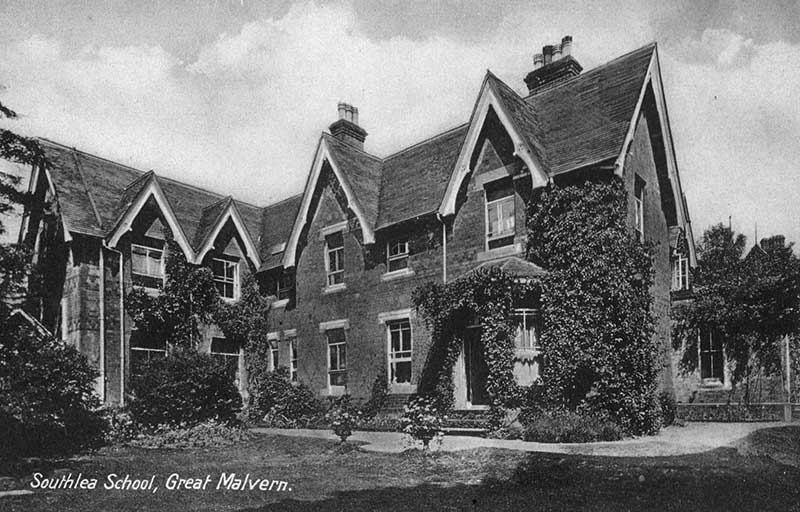
Southlea School, Albert Road 1917 - source: Peter Gibbs
Two small plaques in St Mary's Church, Guarlford, are
dedicated to the memory of former pupils of Southlea school.
One inscription reads,
AMDG In memory of James Hamilton Symonds who fell asleep 16 October 1918 from Southlea fellows and friends.
(AMDG is an abbreviation for the Latin - Ad Maiorem Dei Gloriam which
translated means 'To the greater glory of God')
James Hamilton Symonds (died age 12 years) was the son of Dr George Henry
Hamilton Symonds. James' elder brother Rowland Charles Symonds of Hereford
went on to become a Brigadier in the Royal Artillery and married into the
Peerage.
The second inscription reads,
In memory of Philip Nicholls who fell asleep St Matthias Day 1918 from Southlea School fellows and friends.
The plaque relates to a pupil of the school who died at a
nursing home in Priory Road on 18th February 1918 aged only 11 years and is
buried at Wolverley parish church. He was the son of Francis Welcome
Nicholls and Hannah Street. Francis was a fruit merchant and farmer of
Brookfield, Wolverley near Kidderminster, who had died in 1913. (Sadly Hannah
died shortly after Philip thus leaving her seven other children orphans. Philip's
elder brother Francis had to be the executor of his little brother's estate;
he went on to develop a large and successful wholesale fruit and vegetable
business).
Southlea, which was a private preparatory school in Albert Road, Great
Malvern, in Worcestershire, had
strong links with Guarlford Church, as the Rector, Reverend Frederick Newson, taught there
for many years and was held in great esteem by staff and pupils, some of
whom regularly attended Guarlford Church.
No physical trace of the school remains except for the car park opposite
the Splash Leisure Centre, built on the school playing fields, being named Southlea car park.
The playing fields at the rear of Southlea extended in an L shape
across the back of two other houses all the way to Clarence road.
The main entrance to Southlea car park is in Priory Road,
but map M113 of Great Malvern dated 1904
(stored in Malvern Library) shows that the house itself fronted on to Albert Road, which is now named Albert Road South.
It must have been quite an important building as few of the other houses on the map were
named.
The
building, Southlea, stood where the Automatic Malvern Telephone
Exchange was built, next to an old house which used to be called 'The Lynches' (see photo
below); a strange
name but possibly of Anglo Saxon origin, 'Linc' referring to a ridge or sloping
ground.
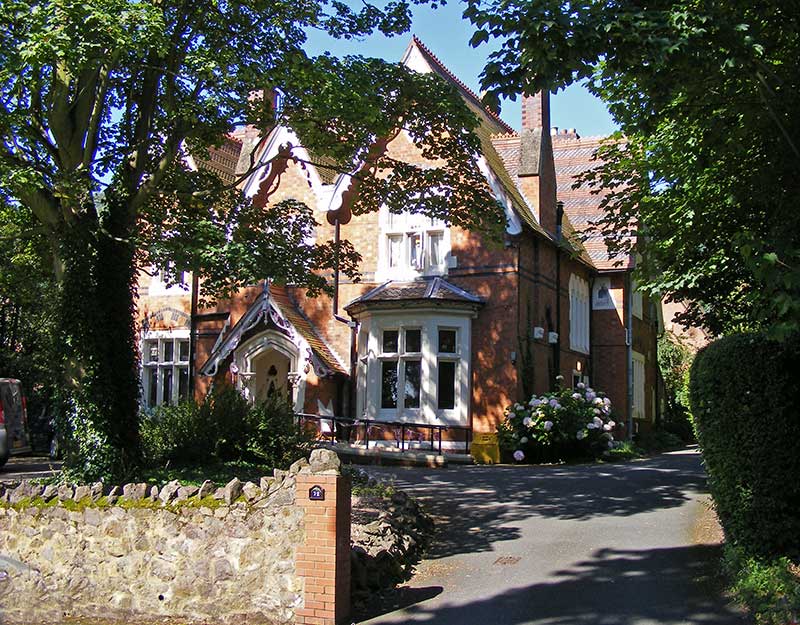
The Lynches
The Lynches had typically been owned by retired doctors and surgeons.
Great
Malvern was then a town for retired gentry with members of other classes
mostly living
in North Malvern and Malvern Link.
Revd John Francis Cooksey born 1851 and ordained 1874 was the son of J A
Cooksey MRCP of The Lynches. A later owner was
Francis William
Romney, a cricketer and
solicitor, born 1873 who was educated at Malvern College and St Mary Hall
Oxford. He was a partner in Romney, Fraser and Odly of the Abbey Gate House,
Malvern.
During WWII The Lynches, like Southlea, was probably taken over as a hostel
for radar boffins as there was a patent application of 1943 about
'Improvements in or relating to Pulse Signal Selecting and Indicating
Systems', by
Frederick
Calland Williams, of 1, The Lynches, Albert Road South, Great Malvern,
Worcestershire, and others including Doreen Blumlein, who was representing
her late husband, the scientist
Alan
Dower Blumlein.
 Alan Blumlein was the lead engineer on the wartime H2S
Radar Project and was sadly killed when his Halifax trials aircraft crashed near Goodrich
Castle. Alan Blumlein was the lead engineer on the wartime H2S
Radar Project and was sadly killed when his Halifax trials aircraft crashed near Goodrich
Castle.
The Lynches is now a
care home for those
with sensory impairments.
Living next door but one to Southlea school, at Stoberry, in 1901 was
Lawrence Sidney Milward, a mathematics teacher at Malvern College and editor
of the Malvern Register. His youngest son David Henry Milward (1907 - 1944)
was a civil engineer; during WWII he was Corporal 13006110 Royal
Engineers and his death 27th April 1944 is recorded on his parents'
headstone in Guarlford churchyard. David's elder brother Frederick Alexander
Milward served in the machine gun corps and tank corps towards the end of
WWI (and survived).
Back to top
Southlea school was started by Edward Roger Cooper Hays,
the son of a solicitor, about 1861 and
it probably closed in the late 1930s. At the time of closure the school had about 26 pupils and the
headmaster was a Mr Girling. During
WWII we think the buildings were used to provide accommodation for radar boffins from
TRE.
Later in the 1950s or 1960s the former school buildings were demolished to make way for
Southlea car park and the Automatic Telephone Exchange, which replaced the
manual exchange in Church Street.
An advertisement for the school appeared in Stevens'
Directory and Gazetteer of 1901.
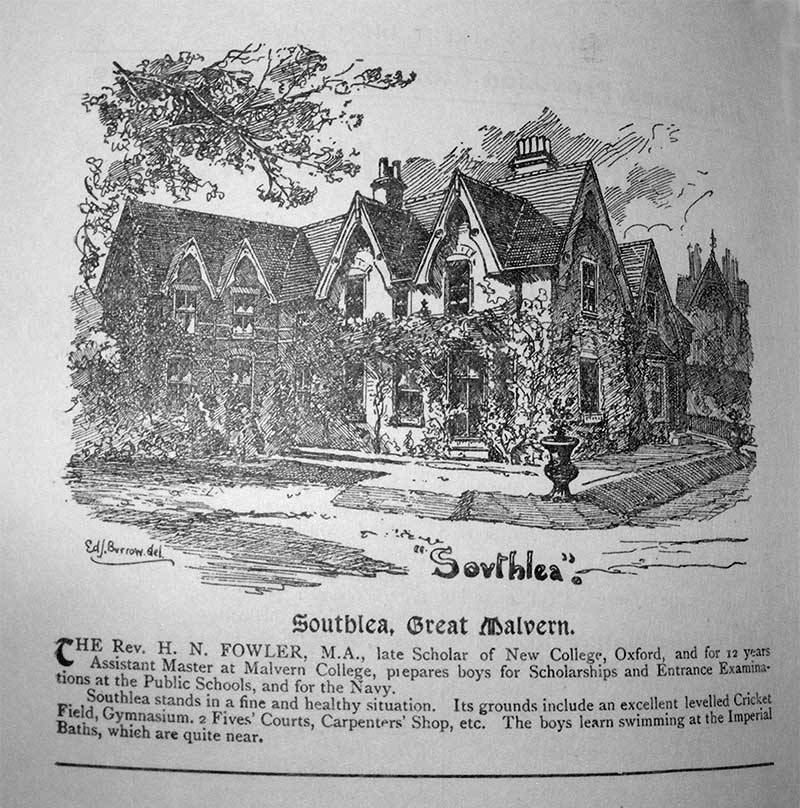
Advertisement for Southlea in 1901
The text of the advertisement reads:
Southlea, Great Malvern
The Rev HN Fowler, MA, late Scholar of New College,
Oxford, and for 17 years Assistant Master at Malvern College, prepares boys
for Scholarships and Entrance Examinations at the Public Schools, and for
the Navy.
Southlea stands in a fine and healthy situation. Its
grounds include an excellent levelled Cricket Field, Gymnasium, 2 Fives
Courts, Carpenters' Shop etc. The boys learn swimming at the Imperial Baths,
which are quite near.
In the bottom left corner of the drawing of the school is
the signature 'Ed J Burrow'. This is followed by the initials 'del' which
simply means
he was the person who drew the picture. We think it quite likely this was
Edward John Burrow, who ran a publishing enterprise in Cheltenham and was
the nephew of the proprietor of the Malvern Advertiser newspaper, from 1867
to 1900, John
Sloggett Jenkins.
The Southlea Charity
On 6th July 1883 Edward Roger Cooper Hays, who founded
the school, by deed gave £160 Midland Railway
2½ per cent. stock, the annual dividends, amounting to £4, to be applied
towards the education at the Lyttelton Grammar School of a boy chosen from
Mill Lane (now called Malvern Parish in Manby Road), Wyche or St Ann's National
schools, under the title of the
Southlea Charity - ref: 'Parishes: Great
Malvern with Newland', A History of the County of Worcester: volume 4
(1924). These were all church schools.
Despite Lyttelton Grammar School closing about 1946, the Southlea
Charity remained in existence until 1981 when a letter from the Charity
Commission to the County Education Officer, dated 11th March 1981, confirmed
that The Southlea Charity would be merged with the Blanchard Scholarship
(created 25th July 1891) to form the Southlea and Blanchard Charity, under
the trustee-ship of Dyson Perrins Church of England School.
Aim - to promote the education, including social and
physical training, of boys attending the said school and in need of
financial assistance.
(We have not been able to identify St Ann's school - do you know
where it was?)
Back to top
We are very fortunate to have been sent some photos of
Southlea by Peter Gibbs whose father Jeffrey was at Southlea school circa 1917
- 1919
(ref 22).
Jeffrey's Aunt Mildred Mary nee
Gibbs was the wife of the headmaster, and his Aunt Florence Beatrice Gibbs was the matron
and music teacher.
Mildred Mary Gibbs had married schoolmaster Hugh Edmund Wood,
the son of a clergyman at Newport in 1908. It was her second marriage, her
first husband Percival St Clair Williams having died of Tuberculosis only
two years after their wedding. The census records Mildred and Hugh at Southlea in 1911 and trade directories put them at the school until 1928.
The photo below shows the headmaster Hugh Edmund Wood
(centre) with staff
and pupils.
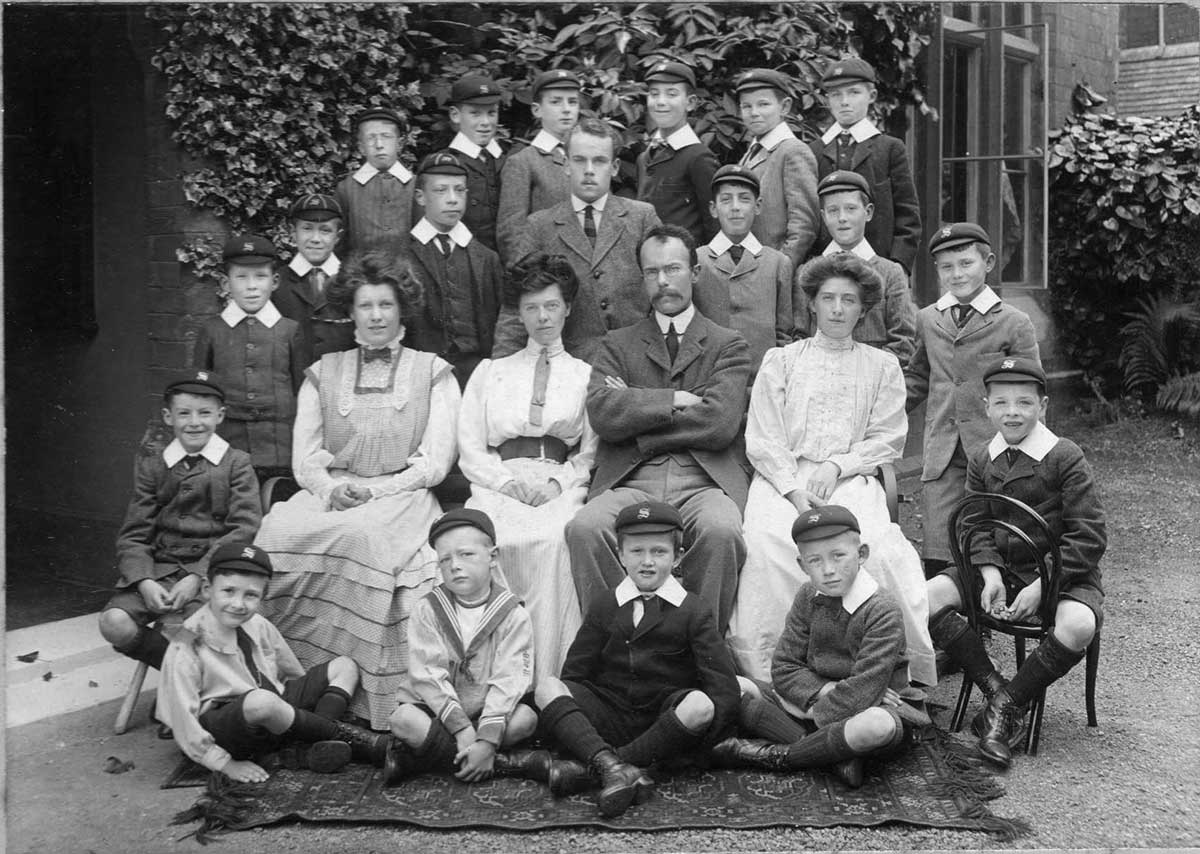
Southlea staff and pupils circa 1917 - source: Peter Gibbs
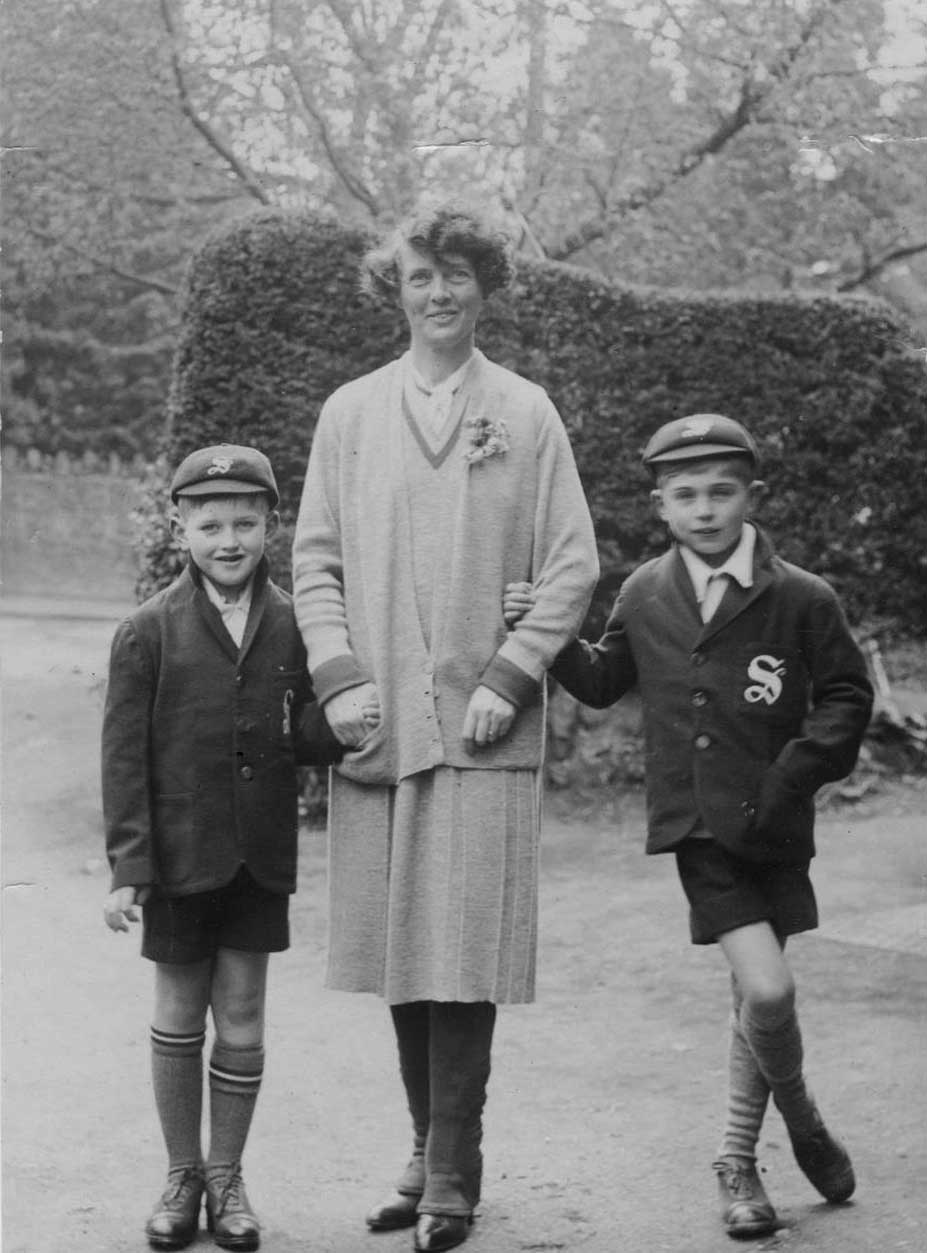 The
photo opposite shows Mildred, the wife of the headmaster, with two pupils. The
photo opposite shows Mildred, the wife of the headmaster, with two pupils.
Mildred looks very happy in the photograph but sadly her brother Private
Horace Boddington Gibbs of the Canadian infantry had been killed in action on
or about the 27th September 1916 aged 32 years. You can read more about
Horace on the
Malvern
Remembers website.
Jeffrey Gibbs (1907 - 1971) was in the Southlea cricket team pictured below (left, front row)
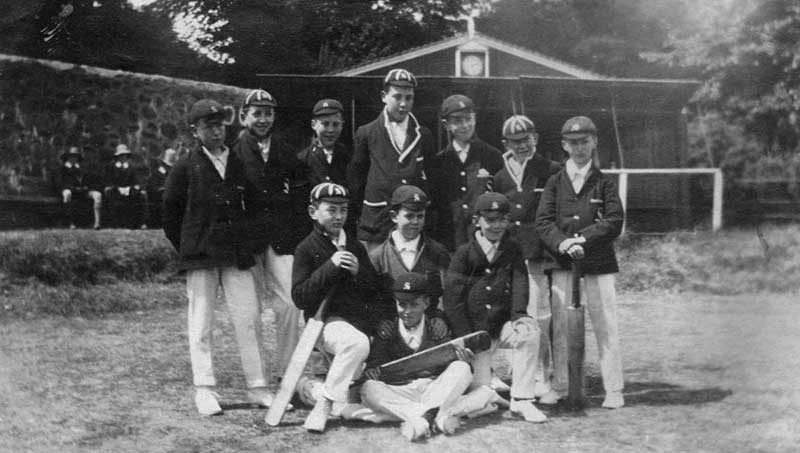
Southlea cricket team circa 1917 - source: Peter Gibbs
Jeffrey had been awarded a certificate for the 100yds on school sports
day instead of a cup.
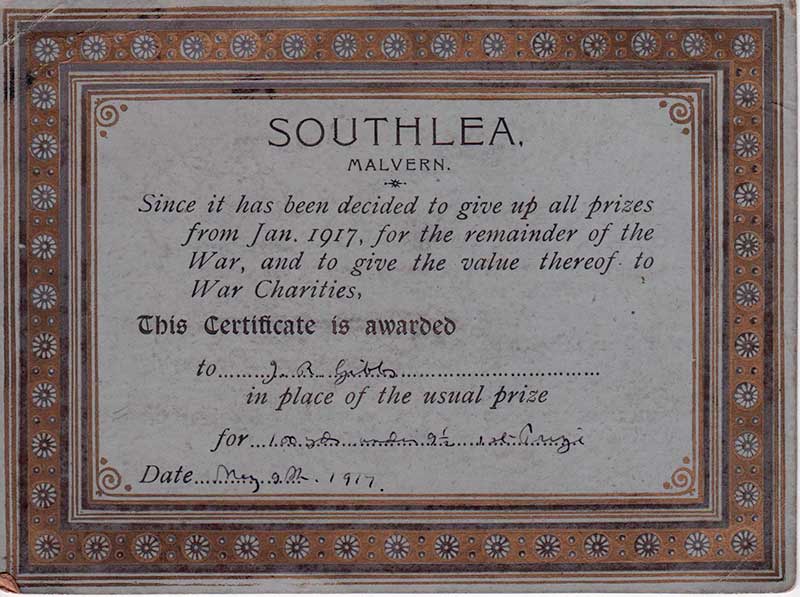
The certificate reads:
SOUTHLEA
Malvern
Since it has been decided to give up all prizes from Jan 1917, for the
remainder of the War, and the give the value thereof to War Charities,
This certificate is awarded
to J R Gibbs
in place of the usual prize
for 100 yds under 9 1/2 1st Prize
Date May 9th 1917
Other group photos relating to Jeffrey Gibbs' time at
Southlea are shown below. Please click the picture to obtain a larger image
and do let us know if you think you can put a name to any pupil in the
photographs.
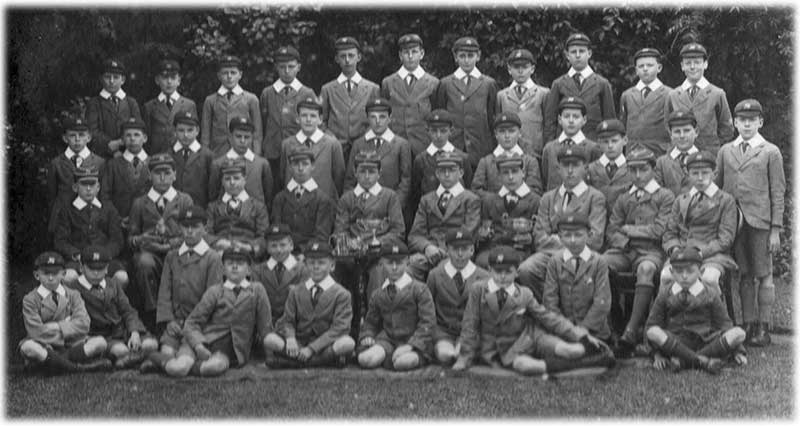
Southlea pupils about 1917 (Gibbs family album)
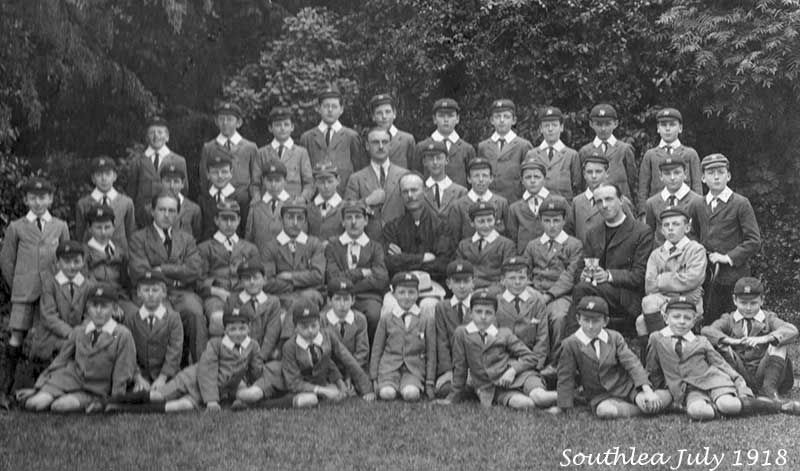
Southlea pupils about 1918 (Gibbs family album)
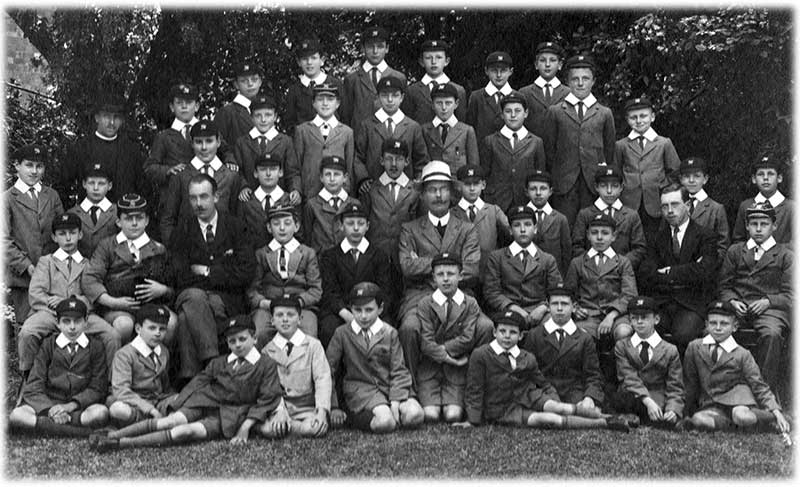
Southlea pupils about 1919 (Gibbs family album)
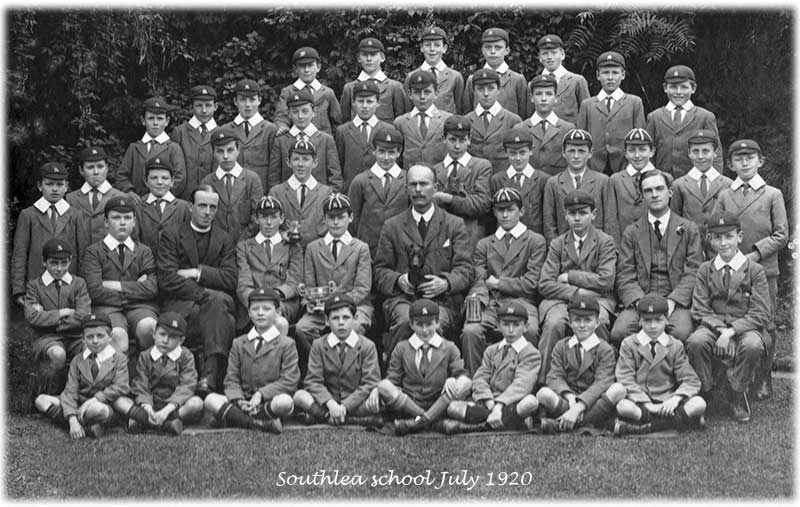
Southlea pupils about 1920 (Gibbs family album)
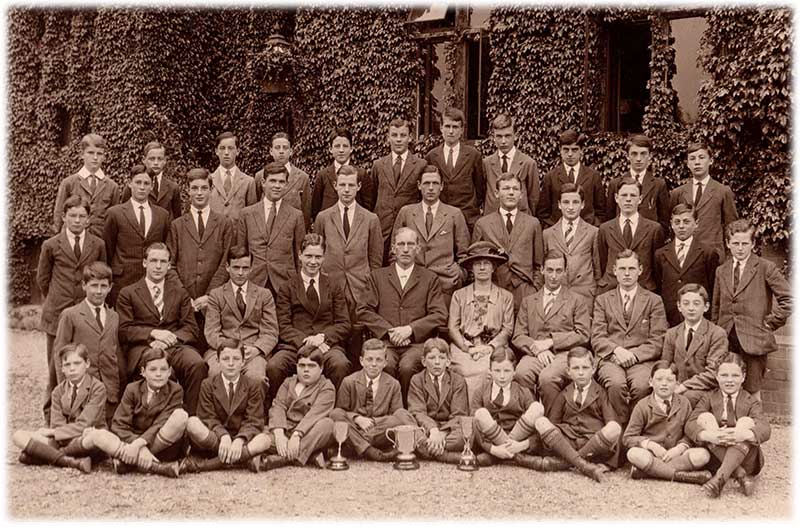
Southlea pupils about 1921 (Gibbs family album)
We think the clergyman in two of the photos above is Rev
Frederick Newson, who was Rector of St Mary Guarlford and had recently
returned from service as an army chaplain.
Some other past pupils at the school were:-
 Captain Robin
Tudor Barlow 52 Squadron RAF, who attended the school in 1901, and was killed
on 30th July 1918 aged 28 years. Captain Robin
Tudor Barlow 52 Squadron RAF, who attended the school in 1901, and was killed
on 30th July 1918 aged 28 years.
Douglas Phillips-Birt who became a naval architect.
Richard Bennett Spence, son of a doctor, born 1882
Staffordshire. He was educated Southlea, under Rev Samuel Latham,
Haileybury and
Cambridge and became an army officer. The London Gazette recorded him in
1919 as Major,
96th Berar Infantry, Indian Army; later to be Lieutenant Colonel, OBE.
The famous WWI General Henry
Sinclair Horne born 1861 attended Southlea prep school before
going on to Harrow. He was sketched circa 1922 by the American painter John
Singer Sargent who had also made a charcoal drawing of Lady Beauchamp of Madresfield Court
in 1911.
Air Commodore George Philip Chamberlain OBE (1905 - 1995)
also attended Southlea School, before going on to Denstone
College and the RAF College at Cranwell. During WWII Philip, then a Wing
Commander, was given the job of forming the
Fighter Interception Unit at
RAF
Tangmere, where trials were conducted of night fighters equipped with
airborne interception radar developed by
TRE Malvern. He wrote this touching letter to Mildred Wood on the death of her
husband Hugh, former headmaster of Southlea:
Tel Andover 2770
25 The Avenue, Andover, Hants
21st March 1954
Dear Mrs Wood,
I have heard with great regret that 'the boss' is no
longer with us; that is very sad for you, but it is also sad news for the
many nasty little boys he turned in to reasonably sensible ones - certainly
well mannered and well-informed ones - and started on their respective ways
as useful citizens.
I do hope you will be comforted just a little by the many
letters you will get. Please do not acknowledge this one.
I have often described H E Wood as the best schoolmaster
I have ever known. It would be an impertinence to list to you the qualities
that are required to comply with what I have described. He had them all,
and I am still very grateful to him and I shall always admire the support
you gave him. My father died a year ago, but my mother and Pat are still
going strong.
Yours sincerely, Philip Chamberlain.
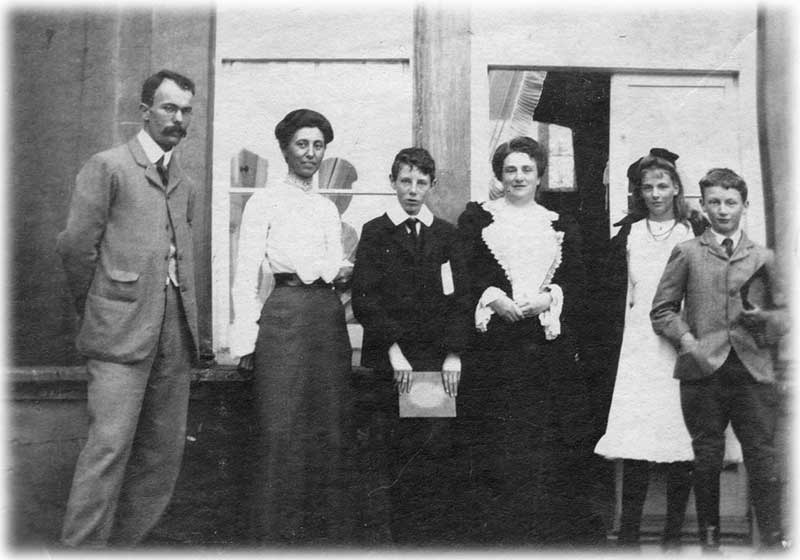
Hugh Wood in earlier times with staff and pupils (Gibbs family album)
Another letter written to Mildred Wood was from Edgar
Lawday, who we think was a painter and decorator who probably did work for the
school (ref 22). Part of the letter reads:
Malvern has not altered much since you resided here, but
your lovely old cricket pitch at 'Southlea' is a disgrace, being let to the
TRE people, full of rubbish and old fowl pens. As you know how nice it
always kept, it was one of Mr Woods 'Pride and Joy'.
I often see Mr and Mrs Keble, I also do work for them. I
am sure that they took a pattern from Mr Wood and yourself as they both
worked hard at 'Little Malvern' and left the school (St
Richard's) with a very good name.
Perhaps when you have a few minutes to spare I would very much like to hear
from you again and I will not be so long in replying.
With all good wishes,
Yours sincerely, Edgar Lawday
One of the last pupils at Southlea School was local resident
Toby Bruce Morgan, who served as a Councillor for many years.
Click here for more
information about Edward Hays, founder of Southlea school, a headmaster Rev
Arthur Sewell, and snapshots of the school
roll.
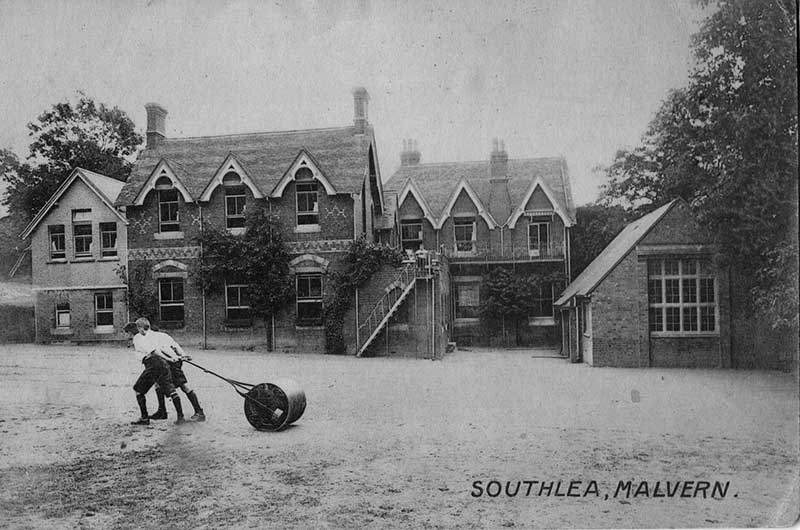
Rear of Southlea circa 1917 - source: Peter Gibbs
After being used to provide accommodation for TRE
scientists during WWII, Southlea was demolished in the 1960s to build the
Malvern automatic telephone exchange, and Priory Road car park was built on
the playing fields.
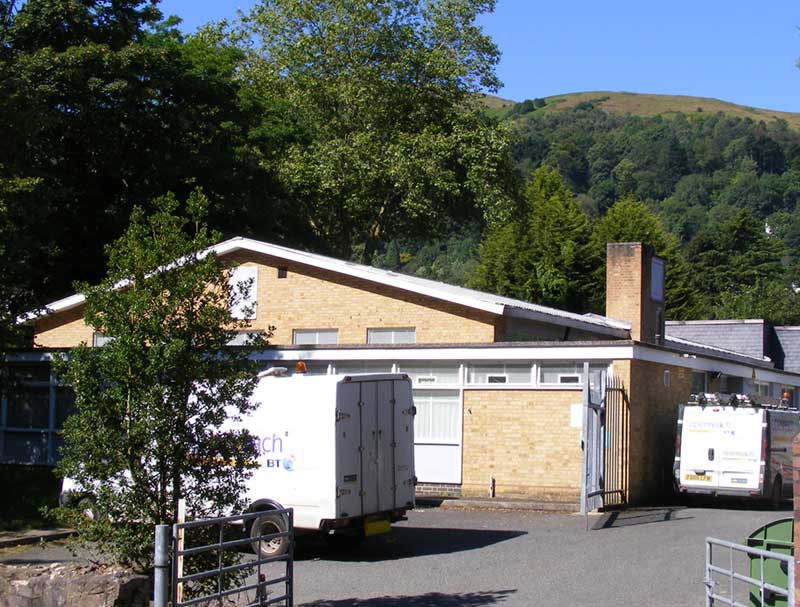
The telephone exchange buildings which replaced Southlea
Back to top
Fairfield boys' school was established by the Rev John
Duncan Clement Wallace between 1884 and 1888 in premises allegedly specially built for the school on
the Worcester
Road in Malvern Link. Rev Wallace was born in India about 1851, the son
of an Indian Army officer, and educated at Worcester College Oxford. He did
not last long and was followed by two further headmasters before being
succeeded by Edward Capel Smith who is listed at Fairfield in the 1902 National Telephone Company directory.
Jim Appleton sent us a postcard mentioning the school
dated 1911.
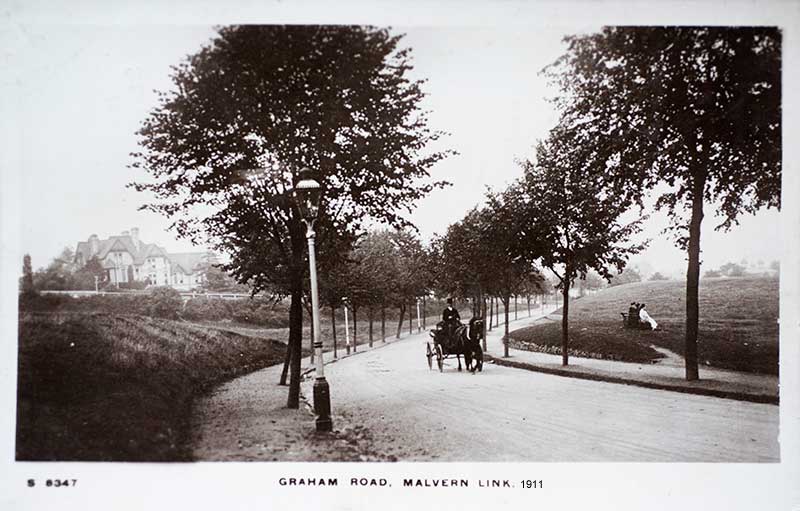
Postcard of Graham Road looking towards Fairfield and
the Worcester Road
credit: Jim Appleton
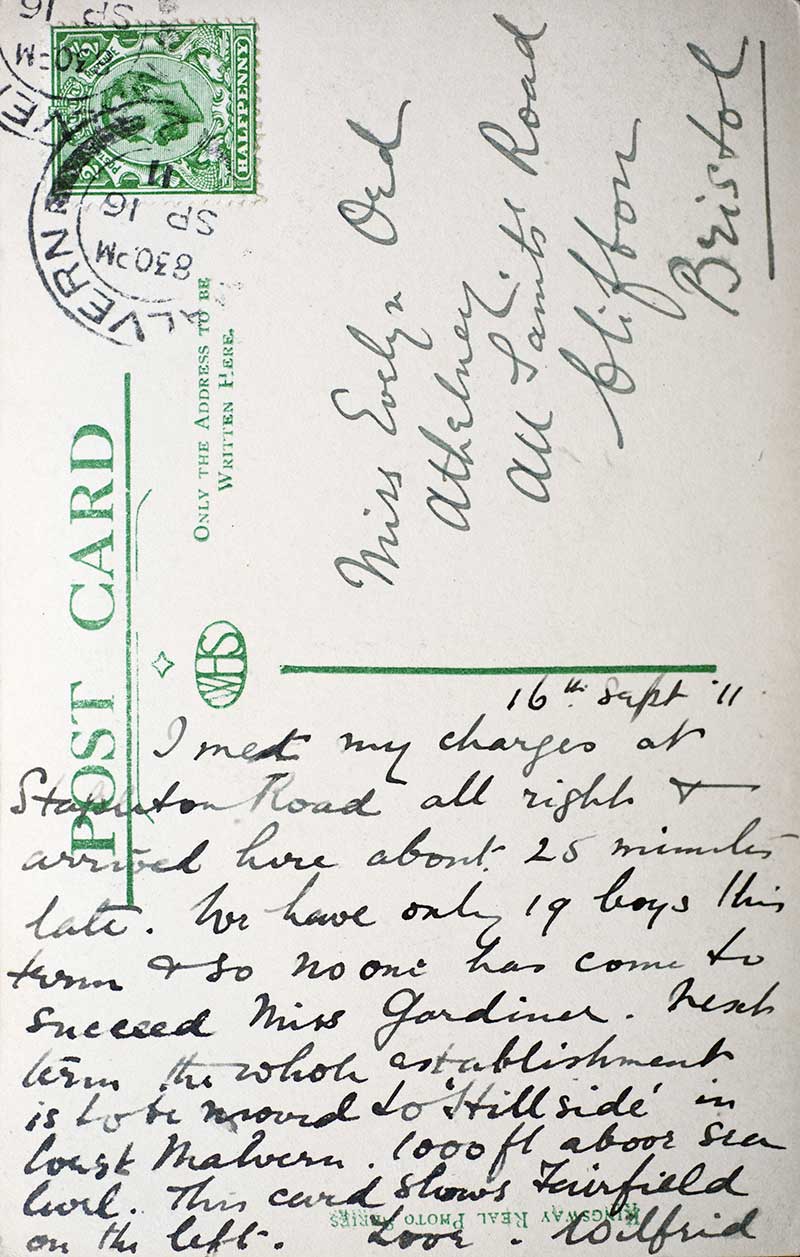 The
postcard dated 16th September 1911 was written by Wilfrid Ord to his sister
Evelyn in Bristol and reads: The
postcard dated 16th September 1911 was written by Wilfrid Ord to his sister
Evelyn in Bristol and reads:
I met my charges at Stapleton Road all right and arrived
here about 25 minutes late. We have only 29 boys this term and so no-one has
come to succeed Miss Gardiner. Next term the whole establishment is to be
moved to Hillside in West Malvern. 1000 ft above sea level. This card shows
Fairfield on the left. Love Wilfrid.
The 1911 census reveals Wilfrid Ord born Heidelberg was a
Tutor at Fairfield; his father was a lecturer at Bristol University.
The postcard suggests that possibly Fairfield school was
either to close or merge with Hillside in West Malvern with effect from
January 1912.
Further investigation reveals that Hillside was put up
for sale in 1910 and by 1911 its headmaster William Salter had left West
Malvern. Edward Capel Smith is then listed in Trade Directories as the
principal of Hillside school West Malvern
from 1912 to 1921.
It would appear Edward Capel Smith continued to live at
Fairfield where he died in 1923 aged 66 years. During his tenure, during
WWI, Fairfield became a Red Cross Auxiliary Hospital offering 61 beds.
In 1938 Fairfield was sold to the Birmingham Hospital Saturday Fund and
renamed the Hugh Sumner convalescent home for children from Birmingham
hospitals. In 1965 it became a home for the deaf.
Local historian Paul Ferris sent us photos of Fairfield as it was
then, and is
now.
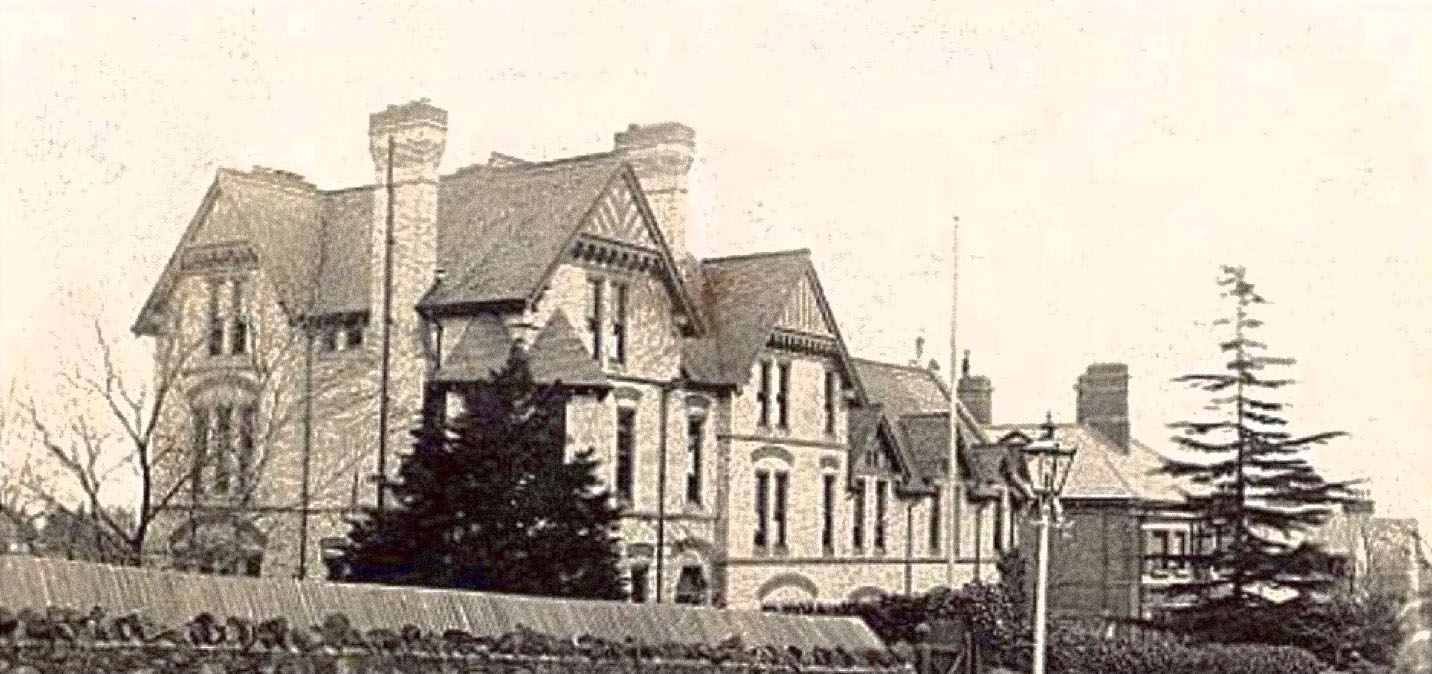
Fairfield, credit Paul Ferris
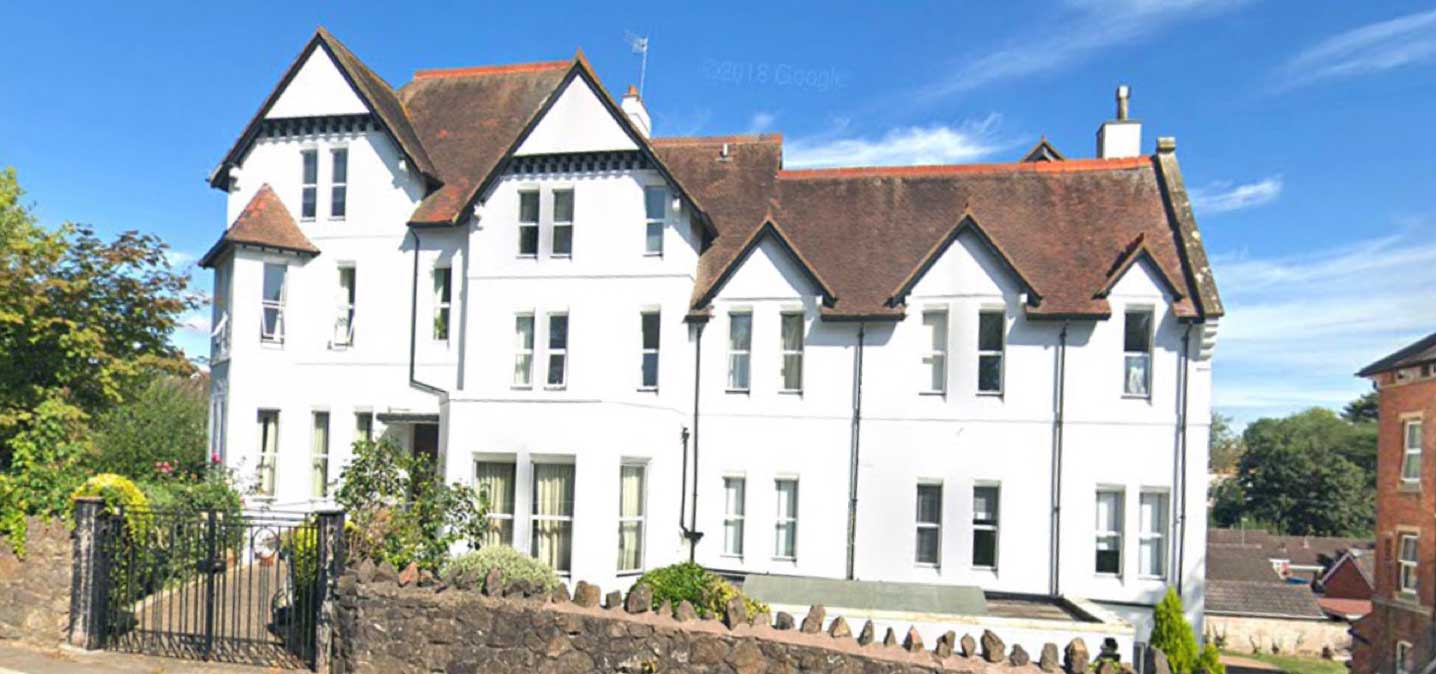
Fairfield as it is today, credit Paul Ferris
The charming photo below shows the approach from Graham
Road to the Worcester Road taken from the same spot as the 1911 postcard
shown above. Fairfield is now obscured by trees, but the bench on the right
still appears to be in the same spot one hundred and ten years later!
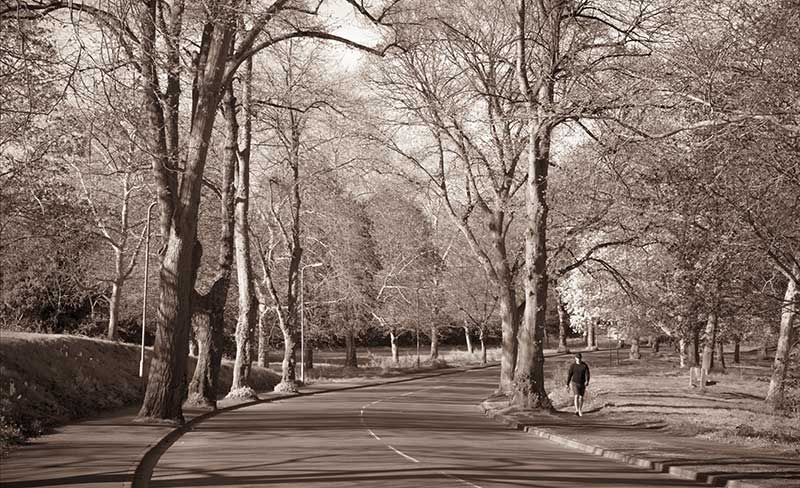
Graham road, Malvern Link, today, © Jim Appleton
Kelly's Trade Directory of 1940 lists St Cuthbert's prep
school for boys, (Christopher Watson BA and Rev BT Vaughan Johnson
principals); the school was in a large three storey villa on the Worcester
Road in Malvern Link. By the end of WWII the school must have closed as
roughly between 1947 and 1959 St Cuthbert's became a convalescent home annexed to
Birmingham Childrens' Hospital.
Earlier in 1901 the property was named Barassie House;
once the home of Rev Frederick Peel, Vicar of Cowleigh and Little Malvern.
Circa 1961 St Cuthbert's was acquired by
Hillside prep school; perhaps Hillside got into
financial difficulty as subsequently the property was demolished by
McCarthy and Stone in order to build sheltered housing known as Morgan Court
comprising about 60 one and two bedroom leasehold flats, which opened in
1988.
This event marked the demise of many prep schools and a
swing to businesses building homes, and caring for, the increasing elderly
population.
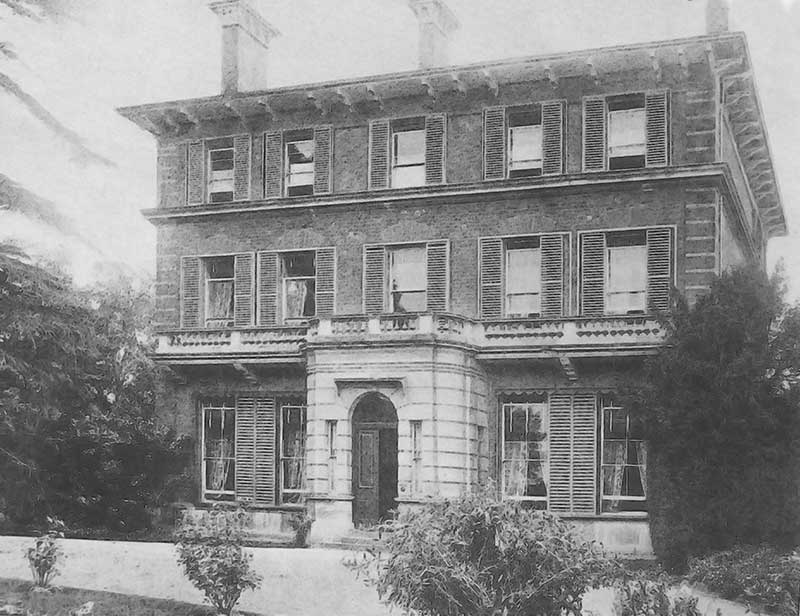
St Cuthbert's, replaced in 1988 by Morgan Court
In 1873 St Cuthbert's had been a school for ladies run by
Miss L Finigan (ref 28). The boys' school is said to have been started by
John Healey about 1904 (ref 30). At some point he acquired
Hazel Bank next door which still stands at 179 Worcester Road.
Among former pupils were said to be Stuart Dyson Perrins, Admiral
of the fleet Sir John Cunningham (1885 - 1962), General
Sir Alan Gordon Cunningham (1887 - 1983) and Flag
Captain Charles Henry Lawrence Woodhouse who was Captain of HMS Ajax at
the Battle of the River Plate.
Arnold Capel Batho (1891 - 1916) was an
assistant schoolmaster at St Cuthbert’s School. He is said to have been
deeply interested in the Scouting movement and threw himself into the roll
of Scoutmaster of the 3rd (St Cuthbert's) Malvern Link Troop while also on
return to the family home in Twickenham, during holidays, assisted with the
local troop.
 Sadly schoolmaster 2nd Lt Arnold Capel Batho, The
Middlesex Regiment, was killed in action at Leuze Wood on 15th September
1916, aged only 25 years. His name is recorded on the Roll of the Fallen at
Holy Trinity, North Malvern, and on the Malvern Remembers web site. Sadly schoolmaster 2nd Lt Arnold Capel Batho, The
Middlesex Regiment, was killed in action at Leuze Wood on 15th September
1916, aged only 25 years. His name is recorded on the Roll of the Fallen at
Holy Trinity, North Malvern, and on the Malvern Remembers web site.
Caroline Cooper moved her 'school for young ladies' from
Elmsdale in Abbey Road to Holly
Mount Mansion above the Worcester Road in the 1860s. The Mansion had
been put up for sale in 1863 following the death of its owner, widow Harriet
Woodyatt.
By 1871, Holly Mount had changed hands again and Trade
directories of 1872 and 1873 record Henry Wilson BA (classics) St
Catherine's Cambridge running a boarding school for young gentlemen.
According to Daphne Drake (ref 5) he had taken over the coaching business of
WHK Kingston, author of 'Peter the Whaler', moving to Holly Mount in 1868.
The 1871 census recorded Henry Wilson BA born 1831
Crowthorne, Yorkshire living at Holly Mount with his wife Sarah, son Henry
Inchcape; an assistant master Robert H Dockray, a nurse, cook, two
house-maids, kitchen-maid and a page; plus seventeen pupils aged between 9
and 16 years.
Henry Wilson was the eldest son of Thomas Wilson BA
Catherine Hall Cambridge who in 1851 was auditor and comptroller of the
Aire and Calder Navigation Company. In 1863 at Finchley Henry had
married Sarah Susannah Mary Bullivant Custard whose parents had run a school
near Yeovil. They had two children Henry Inchbald Wilson (1865 - 1932) and
Edith Vaux Wilson.
By 1881 Henry Wilson had moved from Holly Mount to the
larger Link School (see below).
About 1904 Henry Wilson edited a publication - The parish
registers of Farnborough in the county of Kent, from 1338 to 1812. His death
not many years after was reported in the Times on 12th Jan 1907:
Wilson - on the 8th January 1907, suddenly, the result of
an accident, Henry Wilson MA FSA of Farnborough Lodge, Farnborough, Kent in
his 76th year. Funeral at (St Giles) Farnborough today, at 3.
Henry's son solicitor Harold Inchbald Wilson (1865 -
1932) CBE, OBE, worked for the Ministry of Munitions during WWI.
 Very sadly Henry's only grandson Neville Inchbald Wilson
(1892 - 1918) educated at Malvern College, Lieutenant 3rd Battalion Royal
Welsh Fusiliers, MC, was killed in action on 6th April aged only 25 years. Very sadly Henry's only grandson Neville Inchbald Wilson
(1892 - 1918) educated at Malvern College, Lieutenant 3rd Battalion Royal
Welsh Fusiliers, MC, was killed in action on 6th April aged only 25 years.
The London Gazette reported the award of his Military
Cross on 22nd April 1918:
Lt Neville Inchbald Wilson, Royal Welsh Fusiliers Special
Reserve. For conspicuous gallantry and devotion to duty. Thanks to his
dauntless courage, splendid leadership and perseverance, a position captured
by another battalion was successfully consolidated by the company under
his command, despite intense machine-gun and rifle fire. His contempt of
danger, splendid personal example, and devotion to duty inspired his men
with the greatest confidence, and enabled them to fulfill their task under
the most trying and adverse conditions.
The Link School
The 1881 census recorded Henry Wilson at Malvern Link
School. According to Daphne Drake (ref 5) Henry Wilson had purchased the
grandiose Station Hotel in Malvern Link in 1873 and converted it into a
boys' preparatory school, often referred to as 'The School' or 'Link School'.
No trace exists now of the school which closed in 1965 and was
demolished in 1968 to build the flats known as Aspen Court.
In 1881 living at the school were Henry Wilson,
Schoolmaster, MA Cambridge, his wife Sarah, and daughter Edith aged 9 years;
William W Hickins, assistant master; Thomas J Ogden, assistant master BA
Canterbury; 14 pupils aged between 12 and 16 years; a cook and 3
house-maids.
By 1891 the school's complement was much increased and
unmarried schoolmaster William Douglas had taken over. The census records:
The School, Somers Road Malvern Link. In residence,
William Douglas schoolmaster; Ellen, sister; three schoolmasters, Thomas
James Ogden, Edward A Makin, and Gilbert Heaton; 55 pupils; boot-boy,
matron under-matron, cook, 4 house-maids and a kitchen-maid.
In 1911 William Douglas was still at the school and had
married. The census listed in residence:
William Douglas, schoolmaster, his wife Martha and three
daughters; his brother Edward, a schoolmaster and three other masters, Cecil
Spencer, Richard Fenn, and Duncan Felton; 36 pupils; a matron, nurse, cook,
kitchen-maid, house parlour maid, 4 house-maids, and boot and garden boy.
A former pupil of note was soldier Field
Marshall John Vereker, 6th Viscount Gort VC (1886 - 1946).
Brian Iles relates that the school was badly damaged by
a fire in 1925 and was bombed by the Luftwaffe during WWII.
William Douglas was still at the Link school in 1924 in
partnership with Harold Paulley MA the son of surgeon Job Nathaniel Legg
Paulley (1856 - 1943).
In 1915, Harold Paulley had married William's niece
Margaret Elspeth Douglas. Their son Harold Noel Paulley born in 1924 was to
serve as an officer in the Royal Navy and married a Malvern girl at
Singapore in 1949.
By 1932, Harold Paulley senior seems to have taken over the
Link school. Kelly's Trade Directory of 1940 listed the headmaster as H Paulley MA, The
School, Osborne Road, and Somers Road, Malvern Link. Headmaster Harold Paulley died in
Wales in 1973 aged 83 years.
In 1946 Eric Hunt, who specialised in turning round
ailing schools, became the next headmaster. He was there 5 years. Finally
came Ormond Oliver Postgate who sold the school to a developer.
World War II Memorial
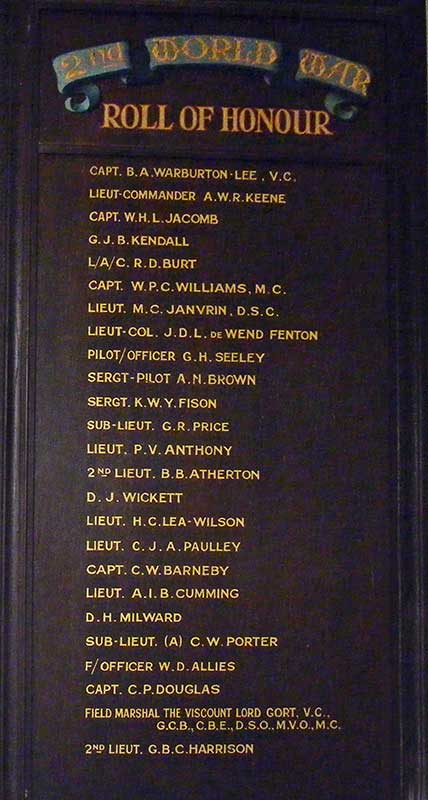 Surviving
in Malvern Museum can be found the Link School's 2nd World War Roll of
Honour (see photo opposite, courtesy of Malvern Museum). Surviving
in Malvern Museum can be found the Link School's 2nd World War Roll of
Honour (see photo opposite, courtesy of Malvern Museum).
The transcription reads:
2nd World War
Roll of Honour
Capt B A Warburton-Lee VC
Lieut-Commander AWR Keene
GJB Kendall
L/A/C RD Burt
Capt WPC Williams MC
Lieut JDL de Wend Fenton
Pilot/Officer GH Seeley
Sergt-Pilot A N Brown
Sergt KWY Fison
Sub-Lieut GR Price
Lieut PV Anthony
2nd Lieut BB Atherton
DJ Wickett
Lieut HC Lea-Wilson
Lieut CJA Paulley
Capt CW Barneby
Lieut AIB Cumming
DH Milward
Sub-Lieut ACW Porter
F/Officer WC Allies
Capt CP Douglas
Field Marshal the Viscount Lord Gort, VC, GCB, CBE,
DSO, MVO, MC
2nd Lieut GBC Harrison
Probably all these men were casualties except Viscount
Gort who died of cancer of the liver in 1946. Those names known to us are:
Air gunner Gerald Henry Seeley, whose sister Dorothy
Hilda Seeley became headmistress of St Nicholas
Girls' School in Cowleigh Road, North Malvern.
Lt Christopher James Archibald Paulley, son of the
headmaster of the Link School. The CWGC records that Lt CJA Paulley 176153,
2nd Bn Royal Inniskilling Fusiliers died in Italy on 17th January 1944 aged
23 years. He is buried in Minturno War Cemetery.
David Henry Milward's name is remembered on the memorial
to his father Lawrence Sidney Milward, a mathematics teacher of Malvern
College who is buried in Guarlford churchyard. David Henry Milward, born
Malvern 1907, Corporal 13006110 Royal Engineers, formerly a civil engineer,
died on 28th April 1944 and is also remembered on the war memorial in Great
Malvern Priory and at the library.
WWI Memorial
In 2020 local historian Cora Weaver was
able to acquire the Link School roll of those that had won honours in the
Great War. The board was being auctioned at Tewkesbury and when the vendor
heard that Malvern Museum already had the WWI board he very kindly agreed to
gift it to the Museum.
Click to
view - The Great War, Distinctions Won
Photo credit: Cora Weaver
Memories of former pupils
Skip to read Everett
Jones memories of the Link School on another page
One source told us that in its final years it was not a
particularly friendly school. The account of a former pupil recollecting his
time at the school in the late 1950s seems to confirm this (ref 19). He
recollects:
The School motto was: *Vis Unita Fortior* (united
strength is stronger).
The headmaster was then Ormond Oliver Postgate MA,
(1905 - 1989) who was the son of
John P Postgate. This J P Postgate, a
Professor of Latin, had six children, one of whom was our headmaster,
Ormond Oliver, and another,
Raymond
was author of the Good Food Guide and
father of
Oliver Postgate well known author of the childrens' books 'Ivor
the Engine' and 'Noggin the Nog'.
Ormond Oliver Postgate, in Cairo in 1939, had married, in Jerusalem
during the Second World War, Patricia the daughter of
Thomas Eric Peet (1882 - 1934) who had been Professor of Egyptology
at Leeds University and is listed in the Oxford Dictionary of National
Biography. The couple were both teachers.
Ormond and Patricia's son
Nicholas (born 1945) was also at the Link School and became Professor of Assyriology at Cambridge University and
Fellow of the British Academy. I remember him at school and also met him by
chance in Baghdad in 1975, when he was vice-director of the British school
of Archaeology there, and I was on a British Council tour as lecturer at the
University of Basrah.
The Link School was an extremely academic school,
and woe-betide any poor boy who couldn't learn his irregular Latin and
French verbs; they were treated by Mrs Postgate, the teacher of those
subjects from Form 3 (age 10), with derision and she generally
terrified everyone who was not vaguely academic. She was highly academic
herself, and was (with hindsight) probably totally frustrated at teaching
little boys, most of whom were local farmers' children who had no interest
in Latin and French.
Her treatment of the boys was out of keeping with the
times, even then! Standing in the corner, making a boy remove his shorts
because he kept putting his hands back in his pockets, throwing non-swimmers
into the deep end of the pool if they didn't dare get into the dirty water,
or forcing boys to eat up all their food and forbidding dessert until the
main course had been consumed. One poor boy, who I think still resides in
Malvern, couldn't eat rice pudding, and so he stayed behind in the dining
room when all had gone and emptied it behind the heating pipes (or so the
story went).
With me it was the terrible pig liver on Tuesdays, so I
also had to sit there until everyone had gone and put it in my pocket, to be
disposed of later. The headmaster's wife was a terror, and this may have
partly led to the demise of the school, as so many boys were withdrawn,
including the two hydrophobic boys, whom I witnessed repeatedly being thrown
into the water. One weekend, in about 1960, about 15 day-boys were
withdrawn from the school after a meeting of local parents; they turned up
at the Downs in Colwall or Seaford Court up the road the following Monday.
Academic boys survived; in fact there were 4 of us in the Upper Sixth in
1962; all four of us went on eventually to Oxford, via Malvern College.
Apart from Nicholas Postgate the only other recent alumnus that I know of
really worth mentioning is the Pakistani journalist
Ahmed Rashid.
He went on to Fitzwilliam College, Cambridge, also via Malvern College, and
has since become a world-famous journalist in all media (Daily Telegraph
correspondent, CNN etc) and is a world expert on the problems of Central
Asia.
Perhaps the real reason the school closed, I suppose,
apart from declining numbers, was that Mr Postgate got an excellent price
for the plot of land on which the school was situated and the several-acre
playing fields down in Malvern Link somewhere near the end of Pickersleigh
Road, if I remember rightly. They would have fetched a good price.
In the 1950s the Link School was not the only one
where pupils were told to eat everything on their plate, fat, grisle and
all. Perhaps bullying, but maybe a lingering response to food rationing
during WWII. Times are different now we hope!
Jeremy Palmer living in Barbados sent us this
communication:
Greetings from Barbados! My brother Jonathan, myself and
our cousin John Barnard all went to The Link although we hailed from the
island of St Vincent in the West Indies. When the school closed we went to
Cobham House which was the Junior School for Bromsgrove where our cousin
John had gone. There were several of us from 'The Link' there and one Clive
Haffner still has school Sports photos of that era. My cousin John took 10
wickets and scored 50+ runs against Malvern St Richard's. The school itself,
as one of your contributors notes and I confirm, was pretty barbaric even
for the times. I later ran into Postgate and his wife at a hotel called the
Wessex in Winchester where I was working and he was teaching or tutoring. That would have been about 1973 or 74. He remembered my brother
and I as our father had sent barrels of limes to make lime juice for the
school and on another occasion mangoes for the school.
The late Peter Morgan of the Morgan Motor Company also
went to the Link; when he heard that someone was visiting the factory had
been at The Link he came and introduced himself to my wife and I. He was
there in the 50's and I was there from '61 until the school closed.
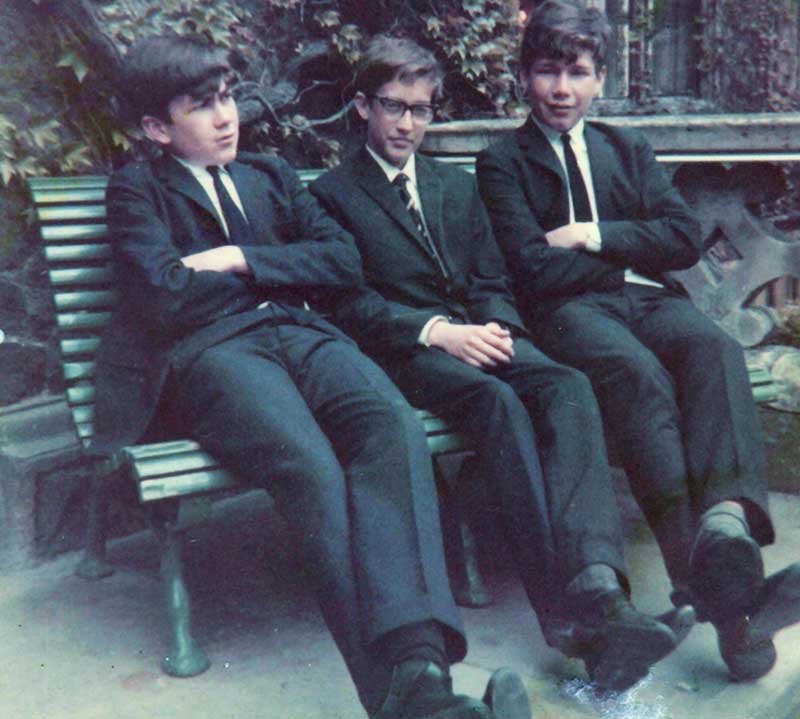
Outside the Abbey hotel - source: Jeremy Palmer
The photo above shows former pupils of the Link School
relaxing on a bench outside the Abbey Hotel, half term circa 1966/67. Jeremy Palmer (left), Michael Barnard (middle) and
Jonathan Palmer (right). Mike the younger brother of John Barnard was
bright and went to Malvern
College.
Adrian Leopard was another former pupil. He recalls (ref
39):
I and my two brothers all went to this school and
there was a Leopard there for every year that the Postgates were there
except the last one; I left in 1964. Just for a period of only a few terms
were we all there at the same time and I became Leopard 3. They were
extremely intelligent people and there is no doubt that Mrs Postgate was not
suited to teaching little boys who did not care about Latin verbs! She was
an absolute terror. Not only did she throw boys into the swimming but if you
turned up and had forgotten your swimming trunks, you just got on with it
anyway, in the nude! And there was invariably someone who did not have them.
The swimming pool was filled with 'railway water' as this was free, but it
took a week. Only if there was a crisis was the mains water tap turned on to
fill it up.
The school building was an interesting one. When I was a day boy
I used to get the train from Worcester and we could go direct from the
platform into the school garden. The grounds were fun for the kids and the
games field was not down Pickersleigh Road but at the bottom of Regency
Road. It was not all bad - there was a fabulous piano teacher called Mrs
Rudhall. She taught me and I went on to become a church organist amongst
other things. Years later I became organist and choirmaster at St James'
Church, West Malvern amongst other places. I remember Mrs Rudhall to this
day. In fact I can mentally walk around the school more or less by perfect
memory today and it was quite a shock to see the honours board on your site!
Ian Simpson a former pupil now living in Canada, who
attended the school with his brother Peter, shared with us two photos dating
from about 1964. One is of the entire school, which was taken on the tennis
court which was located on the premises. Click photo to enlarge.

The Link School about 1964
The other photo is of the school cricket team.
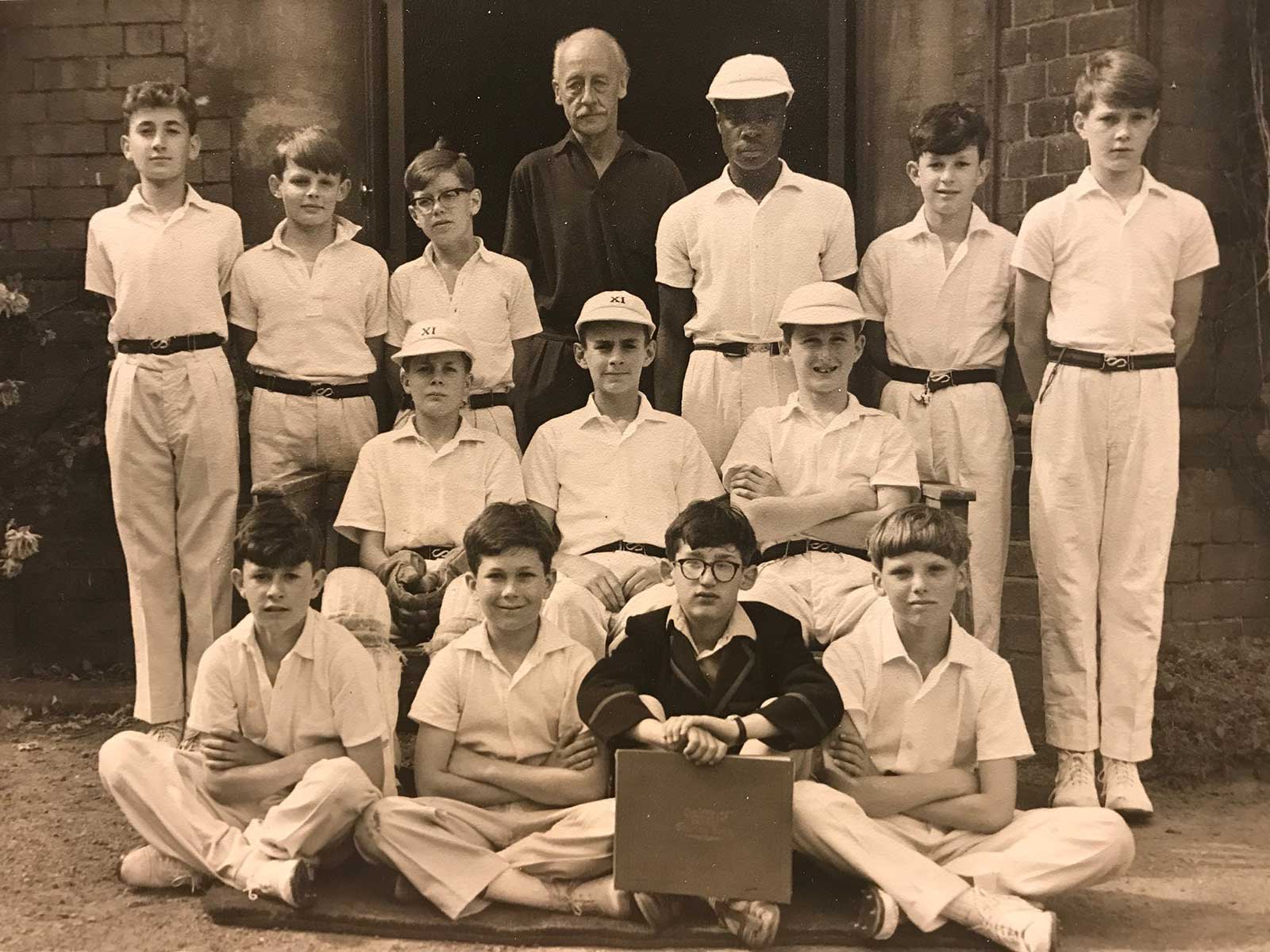
Link School Cricket Team, about 1964
The cricket photograph was taken at the back door of the
school. Peter Simpson is sitting front row left next to Jeremy Palmer. Ian
Simpson is located in the back row, second from right. Do you recognise any
other pupils?
We have not found either an obituary or biography of
Ormond Oliver Postgate (1905 - 1989) but he seems to have returned to the UK
from teaching in the Middle East about 1945 and lived for some years in
Newbury. He is first recorded at The Link School in the 1957 phone
book, suggesting that he came to the school circa 1956.
On 8th April 1958 The Times published a letter from
Ormond Postgate about education in the Middle East in which he put the need
for more British schools for Arab schoolboys to counter 'present problems'.
Perhaps like
TE
Lawrence and
Gertrude Bell he had a good understanding of the region and foresaw
growing problems which perhaps the politicians at home did not fully
understand.
Back to top
Lawnside (see photo below)
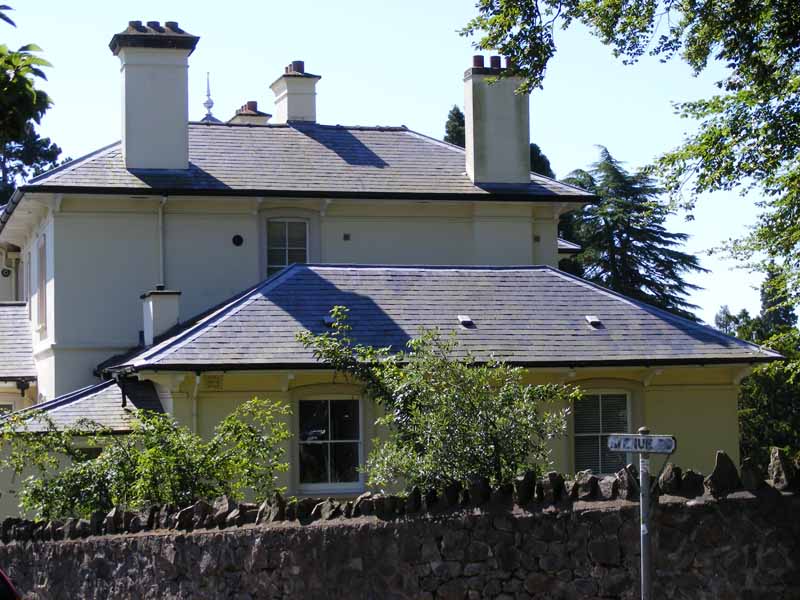
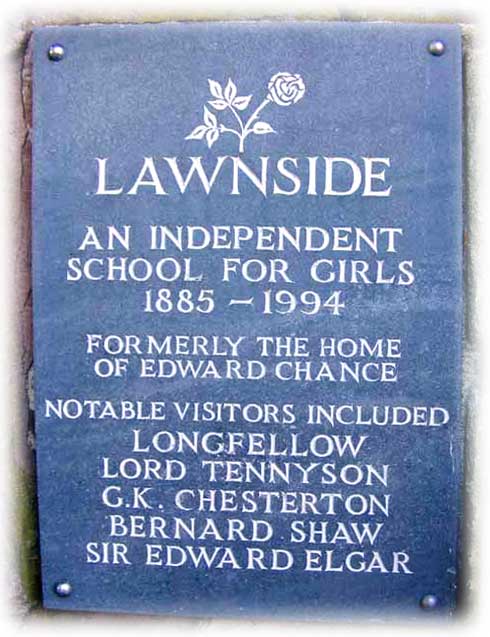
Early history of the school
Lawnside, on the junction of Avenue Road with Albert Road South, opened about 1885, and
its first headmistress was Janet Leighton, the daughter of a Scottish Land
Agent and Surveyor. She had bought the Ladies School at Malvernbury in Abbey
Road circa 1873 following the death of its Principal
Caroline Cooper, and
moved her school first to a house named Oak Hill at the junction of Albert
Road South with Clarence Road (see photo below) and then in 1885 to Lawnside.
In 1871 she had been Principal of a Ladies School in Bedford.
If you count the 'baton being passed' by Caroline Cooper it was
probably the first boarding school
founded for older girls in Great Malvern.
The photo below shows the side of the present house on
the site of 'Oak Hill' which was occupied by Janet Leighton's school in 1881, three years before
the school moved to Lawnside. The house is larger than it looks in this
picture and has a brick extension on the east side.
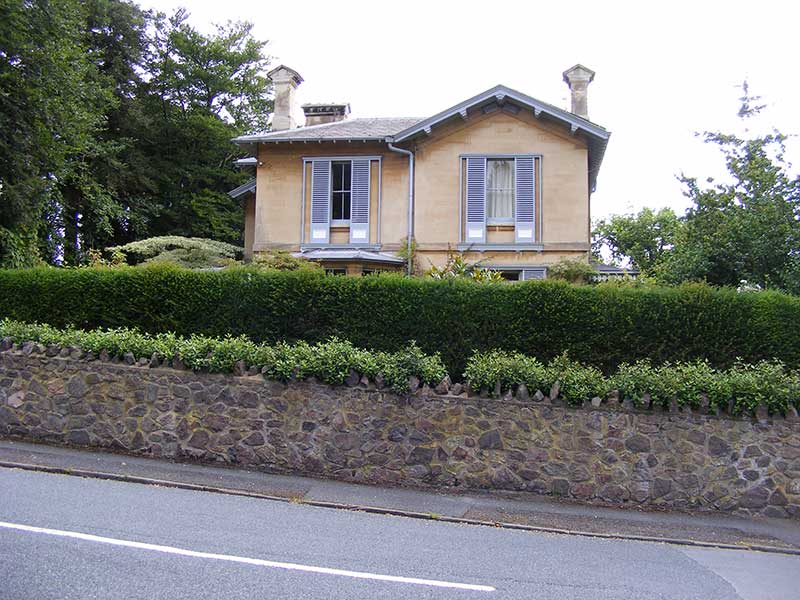
While at Lawnside, Janet Leighton went into partnership with Florence Kate Firth
until 1898 when The London Gazette of July 8th recorded:
Notice is hereby given that the partnership heretofore subsisting between us
the undersigned Janet Leighton and Florence Kate Firth carrying on business
as boarding school Principals at Lawnside Malvern under the style or firm
Leighton and Firth is dissolved by mutual consent as and from the 1st day of
May 1898. All debts due to and owing by the said firm will be received and
paid by the said Janet Leighton. Dated this 30th day of May 1898.
Janet Leighton
Frances Kate Firth
Janet Leighton died in London in 1915.
Florence Kate Firth continued as
headmistress at Lawnside until 1908 when she retired and the business was jointly taken over by
Madame Laura Robinet who retired in 1918 and Miss Gertrude Harman who
retired in 1925.
Lawnside school closed in 1994, due to dwindling numbers, when the school merged
with St James and The Abbey School (ref 6).
Some of the Lawnside teachers were obviously inspirational as can be seen
by various stories
told by Angela Huth who was a boarder at Lawnside in the 1950s. The
Headmistress was then a Miss Barrows whose father had bought the school for
her. Miss Barrows was a friend of Sir Edward Elgar and George Bernard Shaw.
The School buildings have now been developed into residential apartments.
About Edward Chance
In 1881 Lawnside was owned by Edward Chance who was
recorded as a master silesia and alkali manufacturer. Earlier in the 1871
Census he was recorded as a glass manufacturer.
He was a son of William
Chance who went into the glass manufacturing business with his brother
Robert Lucas Chance forming the renowned Midlands glassworks firm Chance
Brothers and Company.
The lychgate at Powick church was built 1912 in memory of
his cousin Arent de Peyster Chance died 1906, whose mother was the daughter
of
Arent de Peyster, a soldier who fought for the British during the
American War of Independence.
Edward's elder brother James Timmins Chance, 1814 - 1902,
became head of Chance Brothers and Company and was created a
Baronet in 1900.
Edward Chance, 1824 - 1881, is buried in
Great Malvern Cemetery
and there is also a touching memorial to him in
Great Malvern Priory in
the form of a brass plaque.
Chance
Glass Ltd an offshoot of the original company is based in Malvern near
the Morgan factory.
The American poet Longfellow visited Lawnside about 1868
and met boys from Southlea School, opposite, where Edward Chance's son
Frederick had been a pupil.
Sir
Frederick William Chance 1852 - 1932 later became MP for Carlisle. Edward
Chance seems to have been held in
high regard and
St
Andrew's church at Poolbrook was erected in his memory. St Andrew's was
built in 1885 and was dedicated as the Chance Memorial Chapel, as well as a
chapel of ease and daughter church of
Christchurch.
More about the house and school - The Grove
Lawnside school was closely associated with the 'arts'
and the school doctor, Medical practitioner Charles Harry Hanger East, who
lived in Priory Road, was a
nephew of the Victorian landscape painter Sir Alfred
East, who became President of the Royal Society of British Artists. Madame Laura Robinet, who was a
principal of the school in 1911, was the wife of French painter Paul Robinet.
The Grove, a Gothic revival house just yards away across the road, became part of Lawnside School for sixty
plus years (see photos below).
The Grove was designed and built by
Edmund Wallace Elmslie, a London
architect, for himself in 1867;
he was also the architect for Great Malvern railway station, the Avenue
Road bridge over the railway, and the
Imperial Hotel built in 1862 which was bought by Malvern Girls College in
1919.
A map of Malvern dated 1881 shows that the Grove used to be named St
Munghos. Elmslie sold the Grove (St Munghos) to
Dr. Archibald Weir
who is also mentioned on our page about Elmslie. His son, soldier General
Sir George Alexander Weir KCB born 1876, may have attended Southlea
preparatory school next door. His elder son Archibald Munday Weir became a
medical practitioner in Malvern Link.
Dr Weir added a billiards room to the Grove. The
house was sold about 1921 to become part of the Lawnside Girls' School, and the
billiards room became a concert hall where Sir Edward Elgar and Sir George
Bernard Shaw were regular visitors.
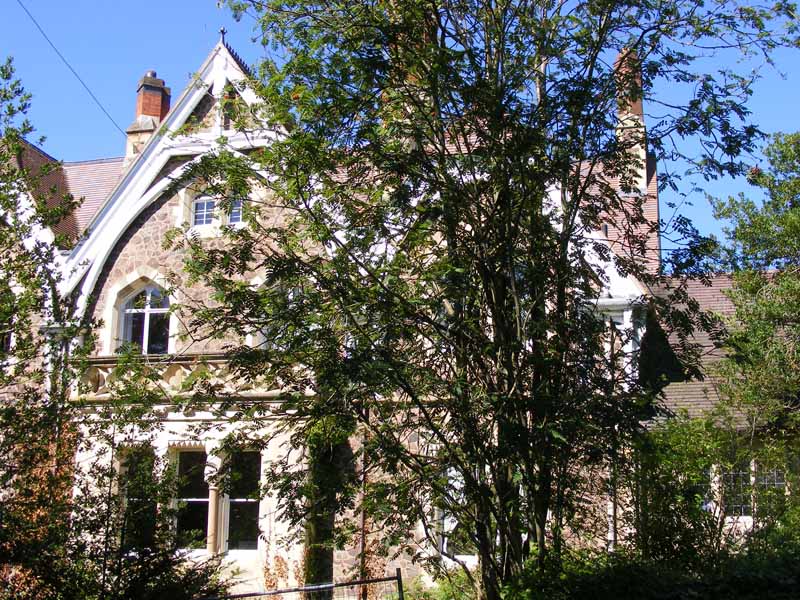
The photo below shows the Grove in 2015 after renovation. It is now named
Elmslie House.
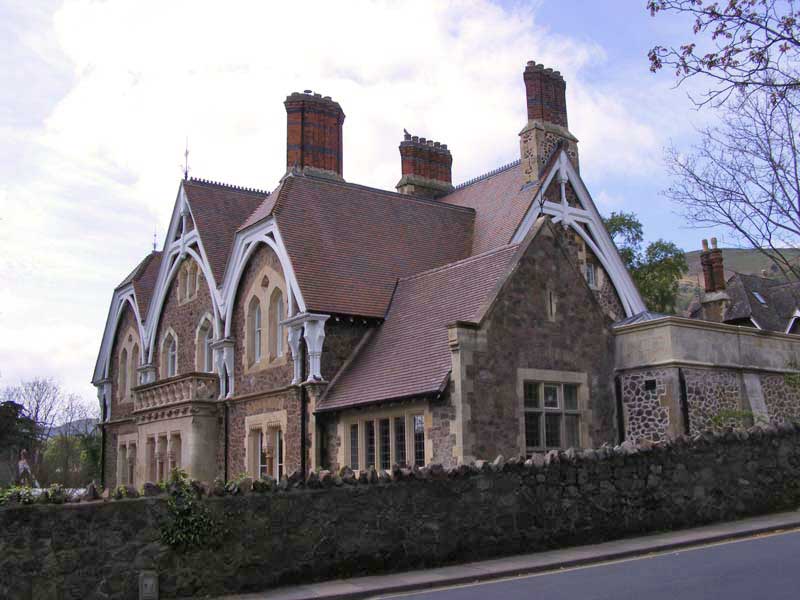
The plaque at the entrance to Lawnside records that the poet
Lord
Tennyson (1809-1892) visited the school. Possibly it was no coincidence
that his first cousin, once removed, Edmund Charles Tennyson D'Eyncourt
married Charlotte Ruth Godson daughter of Barrister, Freemason and MP for
Kidderminster Sir Augustus Frederick Godson, who lived at a mansion named Ashfield,
near the junction of College Road with Abbey Road, Great
Malvern.
Lawnside school closed about 1994 and the property lay empty for
a long while before being converted into residential apartments.
Not far from Lawnside in Albert Road North was another school
for girls at 'The Mount' run by Rosa Campbell Burley who was born Dartford
about 1865. It was the school chosen by the composer Edward Elgar for
his daughter Clarice Irene Elgar.
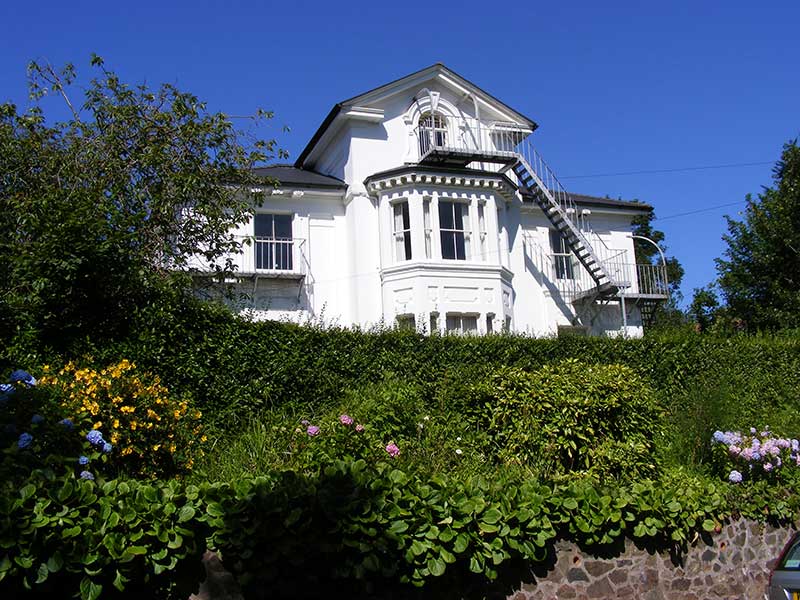
Pevsner described the house as Italianate with raised
pedimented centre (ref 18).
Isabel Greenslade, the daughter of a draper, born at
Bristol in 1862,
founded the school which would become Malvern Girls' College, now Malvern St
James, with her business partner Miss
Lily Poulton.
The first lessons were held about 1893 at Ivydene a
'brick built' house in College Road opposite Malvern Boys' College occupied
by architect William Ford Poulton, his wife (a retired teacher) and their
daughter Lily.
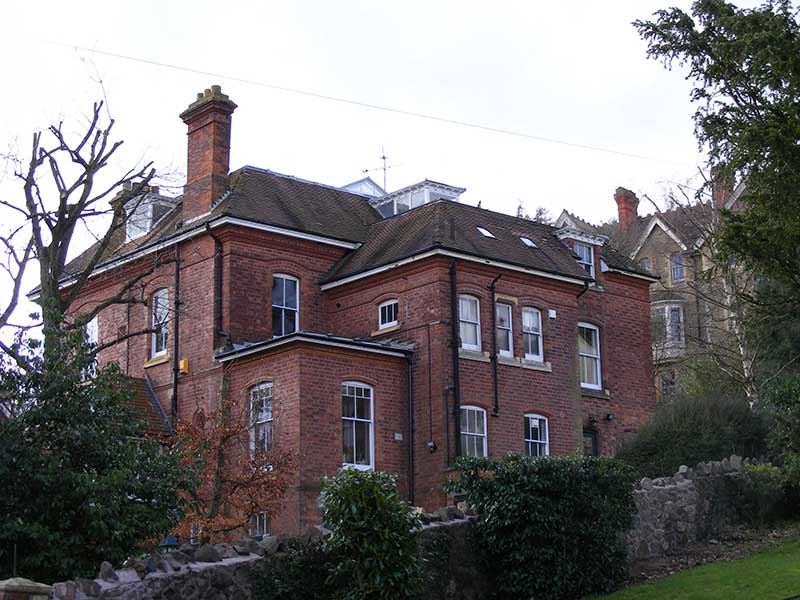
Ivydene, College Road, built 1886
About 1899 Greenslade and Poulton bought Mrs Norton's
school at 'Montpellier' in
Albert Road North, opposite The Mount, and the house was renamed 'Ivydene Hall'.
An extra story was built to accommodate the growing
number of pupils, and a large hall added at the side providing a gymnasium
and studio (demolished in 2014).
About 1907 'The Mount' across the road was added to the
school's
property portfolio.
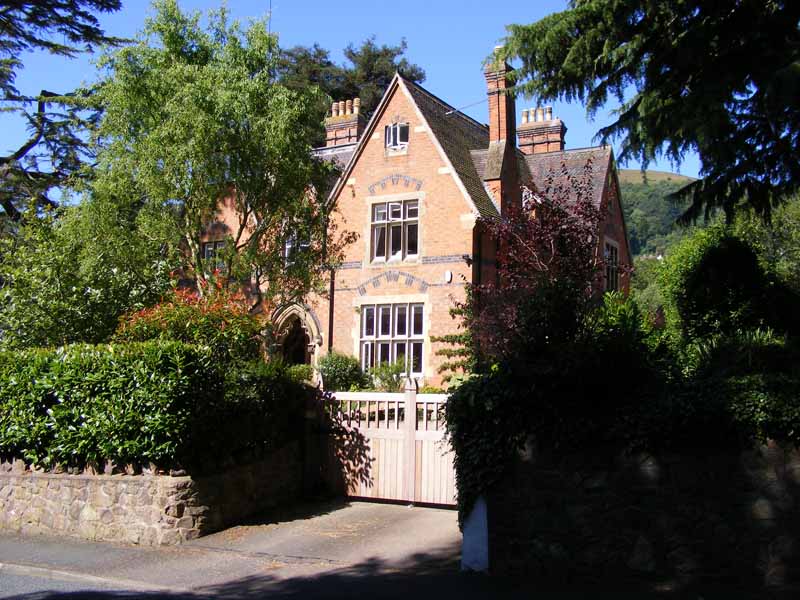 By
1911 the expanded establishment was called 'The College for Girls' and the
joint Principals were Isabel Greenslade, Lily Poulton and Blanche Eleanor
Mitchell. By
1911 the expanded establishment was called 'The College for Girls' and the
joint Principals were Isabel Greenslade, Lily Poulton and Blanche Eleanor
Mitchell.
Between 1910 and 1913 the school also rented a large house named Stoberry in Albert Road
South at the junction with Clarence Road (see photo opposite).
Further properties were acquired over time. Kelly's Trade Directory of 1916 listed four Principals,
the Misses Greenslade, Poulton, Mitchell and Dawson; Malvern Girls' College;
with properties in Albert Road, Avenue Road, and Tibberton Road.
In 1919 the school took the giant leap of moving to the
Imperial Hotel opposite Great Malvern railway station, now the home of
the well known private school Malvern St James.
By 2015, Ivydene in Albert Road, where the college
started, had fallen into a poor state of
repair and was being renovated by
Court Property
Developers Ltd with the intention to convert the building into 14
apartments and build a 2 storey home at the rear (see photo below).
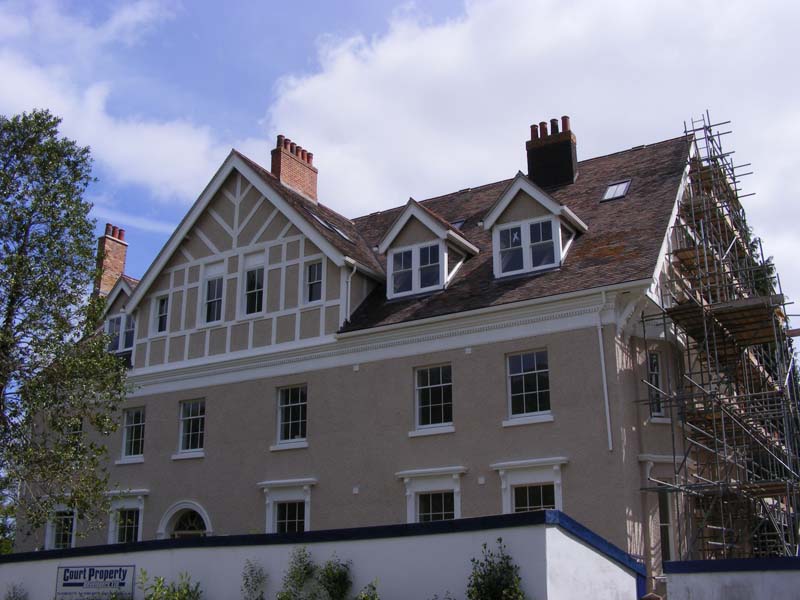
Pevsner mentions in a footnote that Malvern Girls'
College colonised the roughcast Ivydene, giving it half timbered gables 1903
(ref 18).
Next door to Ivydene on the corner of Albert Road North
and Church Street is a house named Summerside which was acquired about 1903
and connected to Ivydene by a covered gallery; Summerside was also known as
School House.
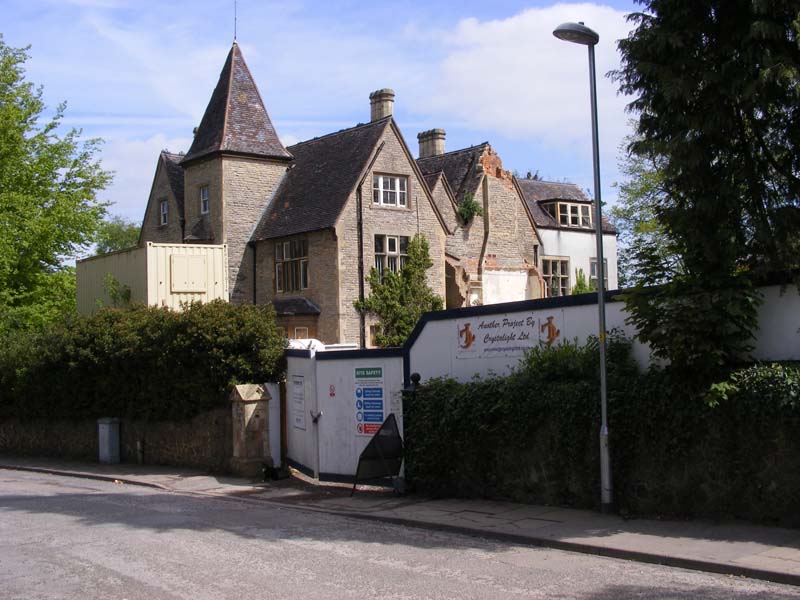
Pevsner described Summerside (pictured above, awaiting
renovation) as by A C Baker 1884 with a pyramid roofed tower with triangular
oriel.
The house may have been built earlier or perhaps there
was another house named Summerside as there are references to a 'Summerside'
in the London Gazette of 1865 and Census of 1871:
In 1865 the London Gazette recorded the bankruptcy of John
Jones a lodging house keeper and retailer of beer and wine of Summerside
House, Bedford House and Refreshment Rooms, Great Malvern.
While the 1871 census recorded Isaac Hollis living at
Summerside (lodging house) with his much younger second wife Catherine. The
business Isaac Hollis and Sons was a
Birmingham based gun manufacturer, and Isaac died at Malvern in 1875.
Miss Greenslade who founded Ivydene which became the
Girls'
College retired to live at
Abbotsmead in Avenue Road and died in 1940.
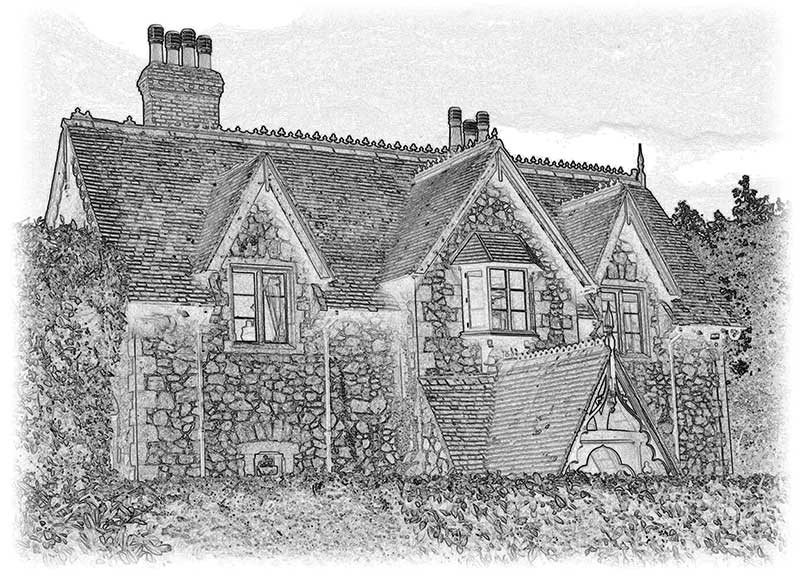
Picture above: line drawing of Abbotsmead
For a much fuller account of the school you are referred
to Pamela Hurle's excellent book Malvern Girls' College, a Centenary History (ref 3).
Montpellier was a Ladies' School in Albert Road, acquired
by Isabel Greenslade in 1899, as mentioned above.
The school seems only to be listed in Kelly's Trade
Directory of 1896, the Principal being a Mrs Rosa Norton. However reference 3
refers to an earlier advertisement for the school in an illustrated survey
of Malvern in 1894; to quote extracts:
a school for the daughters of gentlemen... an
aristocratic establishment... Mrs Norton while possessing a large amount of
the necessary governing power, is at the same time kindly to a degree which
must react favourably on the people under her charge.
Rosa Norton does not appears in the 1891 and 1901 census
of Great Malvern and so we think it likely her school was only in existence
from about 1894 to 1899. That also makes it very difficult to identify her family
and how she came to acquire the school. However we think it possible she was
the Rosa Mary Norton, born London in 1849, who had married in 1876 George
Joseph Frederick Norton (1839 - 1914) the son of sugar planter Joseph
Norton (1801 - 1881) of
British Guiana in South America. In 1881 that Rosa is Principal of Uplands School in London and her
husband is a traveller in the wine and spirits trade. In 1891 the family is
living at Langley near Eton and her husband is oddly described as a mushroom
grower. Rosa died at London in 1900 and so, if she was the lady who started
the school at Montpellier, possibly it was ill health that forced her to
pass the school on to Isabel Greenslade.
Rosa was the daughter of draper and silk broker William
and Mary Ann Bemand. When her mother died in 1858 her maternal
grandfather silversmith James Killick was appointed her guardian. Rosa first
married in 1869 Robert Thackery Reilly but in 1870 her husband died in
Dublin and their son was stillborn.
Rosa and George Norton had three children. Daisy the
eldest born in 1877 married bank clerk George Herbert Wheeler and they also
had three children. Rosa's son Cuthbert Hugh Norton born 1879 became a civil
servant and travelled widely overseas. He became District Commissioner to
British Guiana,
where his grandfather had been a sugar planter, and was awarded the OBE in 1938. Youngest daughter Gladys
Amy born 1888 did not marry. She was baptised at Christ Church,
Erith in
Kent; the family was then living at Ellicombe, in Bexley Road, Erith where her
father was recorded as a wine merchant. We get the impression for one reason
or another the family did
not stay in one place long.
The 1927 Ordnance Survey map of Great Malvern (East)
shows a large house and grounds in Albert Road midway between Malvern
College and the railway line. In 1911 this was the home of Colonel Thomas
Heywood JP. After his death in 1915 Hatley St George became a Junior House
of Malvern Girls' College and in 1918 Miss Dawson may have been the Head.
Miss Kate Dawson was the fourth joint Principal of
Malvern Girls' College, in its formative years, from 1912 to 1928. She was
educated at York High School, the University College of North Wales Bangor,
and Royal Holloway College at Egham in Surrey. She received her BA in 1894,
possibly being amongst the first group of women in the country to be awarded
a degree.
In the mid 1800s the mansion had been known as Oak
Hall, not to be confused with Oak Lodge further down Albert Road. Circa 1890
Oak Hall was renamed Hatley St George after an ancestor of Thomas Heywood's
second wife, Sophie Grace St George.
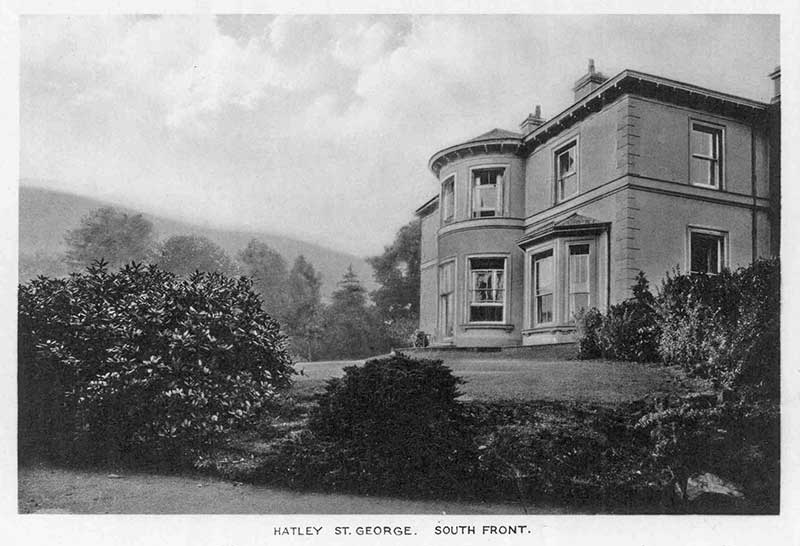
Hatley St George, south front, courtesy of Malvern St
James
The next photo, showing one of the classrooms, suggests
there may have been up to 20 pupils in a class.
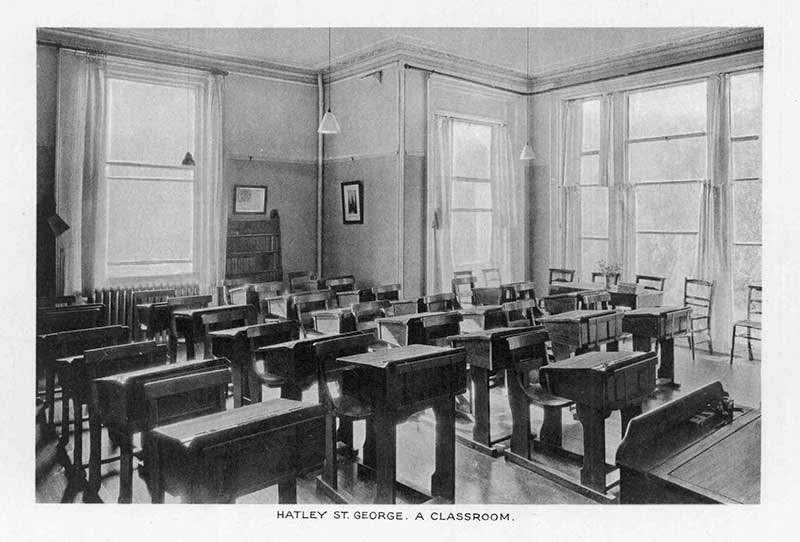
Hatley St George, a classroom, courtesy of Malvern St
James
The dining hall, see below, was probably very similar to
that of many other private schools before the Second World War.
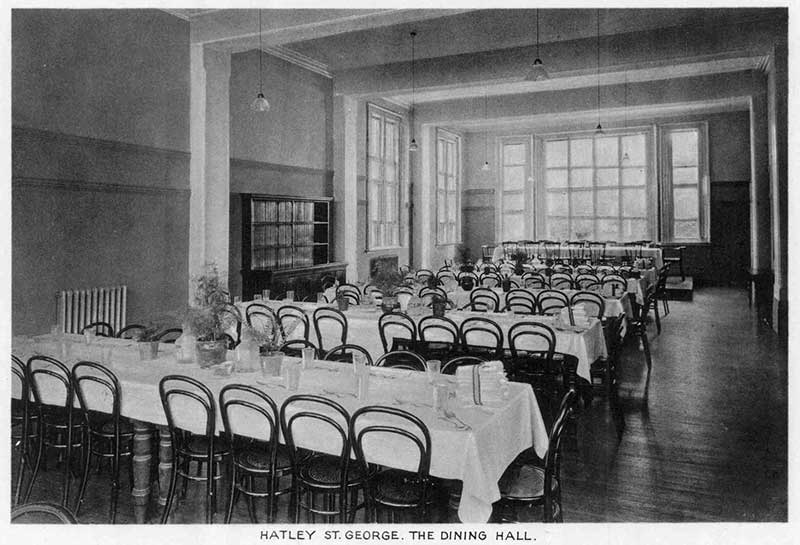
Hatley St George dining hall, courtesy of Malvern St James
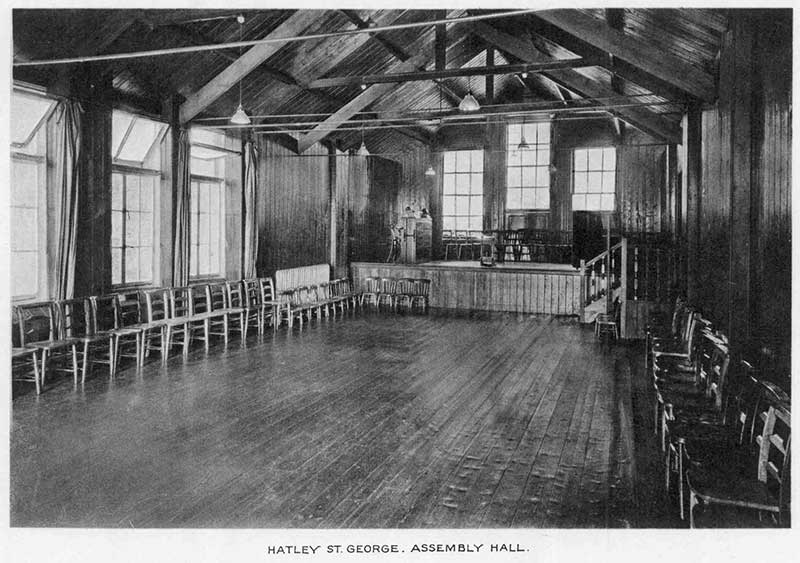
Hatley St George Assembly Hall, courtesy of Malvern St
James
The assembly hall was in a separate prefabricated
building and looks very similar to the one that was installed at Ellerslie.
Ruby Helena Margetts, the daughter of a butcher, taught
music at the school and possibly also at Abbotshill and The Priory. She was
born at Chipping Norton in 1883 and died at Malvern in 1961. In 1901, aged
17 years, she had been at the Beethoven House Music School in Northampton.
Hatley St George was greatly extended by Malvern Girls'
College, and a new wing created now named Hatley Court.
When the property became surplus to requirements, Malvern
Girl's College sold Hatley St George which, like many other larger
properties in Great Malvern, was converted into apartments. After changing hands again, Hatley St George was further
being renovated by Developer Steve Hickman in 2017.
Click to
read more about the history of Hatley St George
Croftdown preparatory school in Abbey Road was founded in 1940 and flourished for many years until
its decline in the early 1990s, when it was taken over by Malvern Girls'
College, finally being closed in August 1997, because of falling rolls. The
house and grounds have now been developed, with the original school being
converted into six luxury apartments plus five new buildings, combining
apartments and town houses.
Kelly's Trade Directory of 1950 listed Croftdown,
boarding and day school, telephone 183, Principal Miss M Wortley.
A former pupil recalls:
After Miss Wortley, who I remember very well, I think
Mrs Bott from Colwall became the head. I can't remember her Christian name,
but her husband, Ian, worked at RRE.
There was a nursery department across the road at Prior's
Lea. The Red Door was the entrance to the upper class in the Nursery
department. The fire escape doubled as an exit for classrooms on the front
upstairs. The 'Tinies' were at the back of the house with safe entry onto
the garden at the rear. In the 1970s the school was run by a Board of
Governors with Mrs Portway-Fletcher as Headmistress.
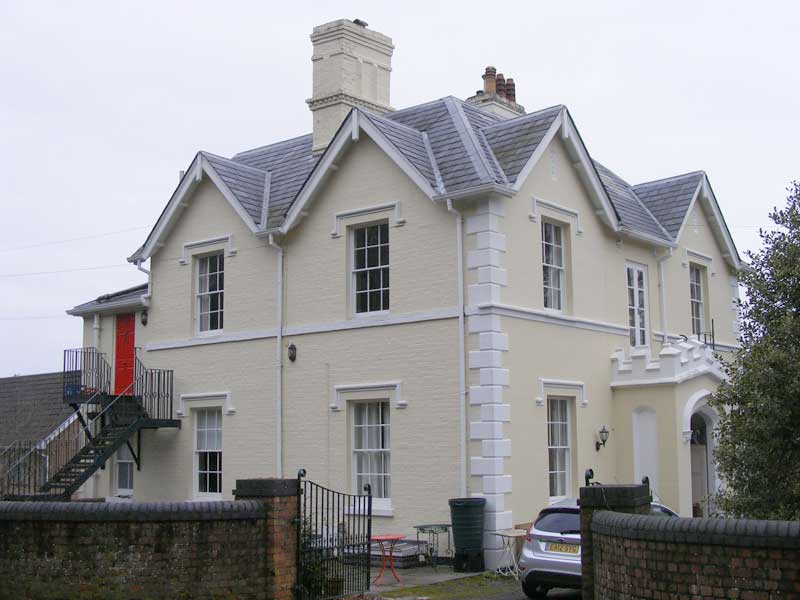
Prior's Lea, nursery department of Croftdown
The building of
Priory Park Mansion, the
present Council House (see photo below) began in 1874 for merchant Alfred
Miles Speer. Following his death in 1894 the property was let to Ebenezer
Lloyd-Jones (1836 - 1922) who in the 1901 census is recorded as having a
school at The Priory. In 1911 Ebenezer was granted a 14 year lease for a school
for the sons of gentlemen. His son Edward Harold Lloyd-Jones took over as
headmaster but died soon after at London in 1912. In 1913 the tenancy passed to Claude
Harold Giles BA, and he continued to run the school with Arthur
Clement Allen MA, who in 1911 had been the Principal of Cherbourg preparatory
school on the Wells Road.
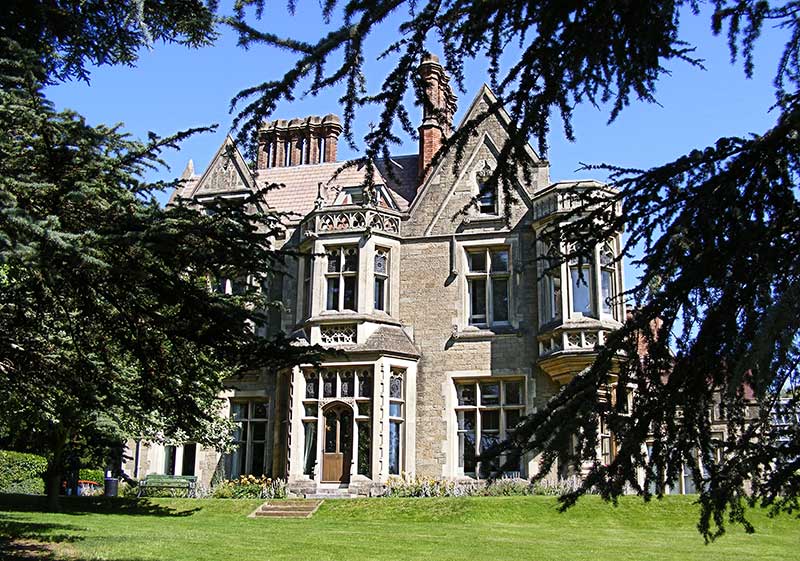
In 1925 when the lease expired, the school left Malvern and moved to
Wood Norton Hall near Evesham. The school then became known as the Wood
Norton Preparatory School for Boys, telephone Evesham 230. It continued to
be run
by Claude Harold Giles and Arthur Clement Allen until about 1936.
Wood Norton Hall was occupied by the BBC during WWII and is now a
hotel.
Ebenezer Lloyd-Jones of Abbotshill in Abbey Road died in 1922 and is
buried in Great Malvern cemetery, where there is also a memorial to his
son, a doctor, who was killed in WWI.
Cherbourg (see illustration of east face below taken from
Priory Road) is a
large house below the Wells Road opposite the
turning to the Wyche cutting, possibly built about 1850. It was last used as
a boarding house by Ellerslie School for girls, but much earlier there had been a
preparatory school for boys. We don't know exactly when the first boys'
school moved to Cherbourg but possibly it was as early as 1881. The modern
flat roofed building below is Hardwick House on Abbey Road built in the 1960s.
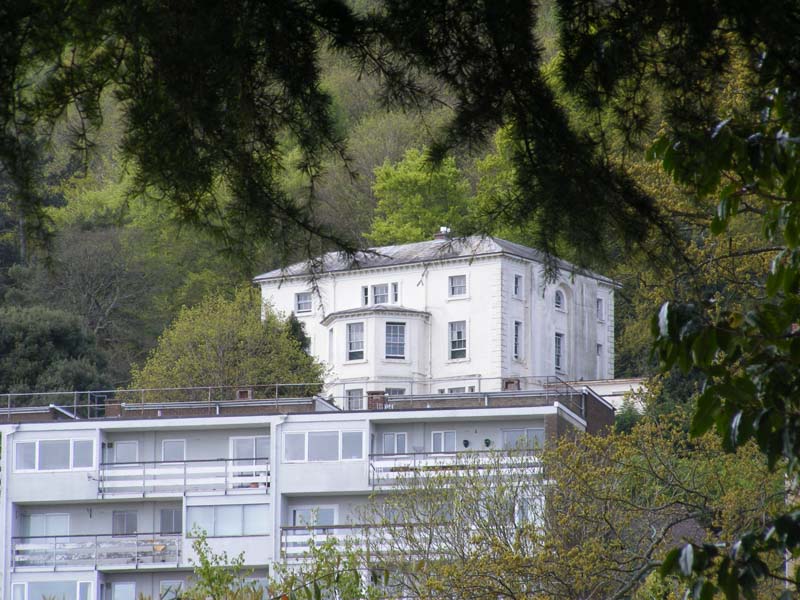
The London Gazette of January 30th 1891 records:
Notice is hereby given that the Partnership heretofore
subsisting between us the undersigned Frederick William Young and Arthur
Vernon Vines, heretofore carrying out the business of Schoolmasters at
Cherbourg House, the Leasowes and Norfolk Villas, Great Malvern, in the
county of Worcestershire under the style or firm of Young and Vines, was
dissolved by mutual consent as and from the 1st day of December 1890. The
said business as from that date be carried on by the said Arthur Vernon
Vines alone, who will receive and pay all the debts and liabilities due to
and owing by the late firm. Dated this 23rd day of January 1891.
Frederick William Young was a clergyman and the son of a
land surveyor. He was born Dorking, Surrey in 1830 and died at Sussex
in 1919. He first married Eliza Rumsey in 1855 by whom he had three
children. In 1861, Frederick was staying with his brother in law, Henry W
Rumsey, a schoolmaster and his father-in-law a retired school master. At
that time Frederick was curate of
Great
Missenden so perhaps it was the influence of his wife's family that
caused him to become a schoolmaster. Eliza died in 1864 and Frederick
married second, in 1867, Jane Catherine Young by whom he had several
children. The 1871 census records
Frederick as a clergyman and head of an establishment named Etonhurst, in
Upper Chase Road, Barnards Green, Malvern; there are two assistant masters,
one of whom is Arthur Vernon Vines aged 25 years, and 17 pupils aged between
9 and 18 years. In recent times, Etonhurst must have been demolished as
there is a modern block of flats of that name there now.
By 1881 Frederick is a schoolmaster on the Wells Road,
possibly at Cherbourg; there are 3 tutors and 37 pupils. North Leasowes,
mentioned above, is a lodging house next door.
Another website records that Ernest Wright Alexander VC
(1870 - 1934) had been educated at Cherbourg House, Harrow and Sandhurst;
his father Robert was a prominent Liverpool based ship-broker and had been a
director of the Suez Canal Company.
In 1891, Rev Frederick William Young and his wife retired
to live next door to a girls' school in Eastbourne, where perhaps he
became a chaplain; Cherbourg school was then run by Arthur Vernon Vines.
Arthur Vernon Vines, the son of a solicitor, was born at
Reading in 1846. In 1861 he had been a pupil
at Christ's Hospital,
and in 1871 was an assistant master working in Malvern for Rev Frederick
William Young.
We don't know where Arthur was in 1881, but on 25th
August 1885 at St Lukes, Cheltenham he married Mary Adelaide Green who was born Bengal,
India on 9th May 1864. She was the daughter of Major-General Sir George Wade Guy Green KCB,
formerly of the Bengal Staff Corps, and Ellen Facey Carter daughter of
William Carter of Troy, Jamaica (ref 20). Her grandfather Revd George Wade
Green (1785 - 1868) had been vicar of Tytherington in Gloucestershire,
between 1817 and 1830 and you can read more about him on the
Tytherington Roots website.
In 1891 Arthur Vernon Vines was
living at Cherbourg, but there were no pupils or staff; perhaps it was not
term time or had something to do with the previous headmaster leaving.
The 1901 census records Arthur as 'Principal of a School' living at the
Chestnuts with 7 pupils aged 15 - 18 years and another master. A few doors
away at Cherbourg, his brother-in-law Thomas Coates is a married preparatory
schoolmaster, with 2 assistant masters, 27 boarders and other staff;
possibly Arthur Vernon Vine and younger Thomas Coates became joint
Principals at the school.
Thomas Coates, born 27 Sep 1872 in Yorkshire had married
on 22nd April 1887 at Christ Church, Cheltenham, Georgina Lilian Green who
was born at Bedford on the 19th of April 1870; she was the younger sister of
Arthur Vernon Vine's wife Mary. Thomas Coates went on to be a Classics
teacher at Bedford School (1907 - 1931). In the 1911 census Thomas is
described as an assistant schoolmaster at a secondary school, living at 11
Rothsay Road, Bedford with his wife Georgina, sons Ronald Gordon and Donald
Ivor who were born in Malvern, a cook and a housemaid.
Ronald Gordon Coates was born at Malvern on the 16th of
April 1888. He was educated at Bedford School, and at the Royal Military
College, Sandhurst. He joined the Devonshire Regiment, with which he served
in the war 1914-1918, being wounded twice severely.
Donald Ivor Coates was born at Malvern on the 24th of
March 1900. He was educated at Bedford School, and at Lincoln College,
Oxford. In 1922 he passed into the Sudan Political Service.
By 1911 Arthur Vernon Vines had also left Malvern and was described in the
census as a 'retired army coach' living by the sea at Margate. We wondered
whether at some time he had specialised in educating boys hoping to gain
entrance to the military academies at Sandhurst and Woolwich. He died on
16th October 1915 at Cheltenham leaving no children.
The 1911 census lists the new Principal at Cherbourg as Arthur Clement Allen; Kelly's Trade
Directory lists him still at the school in 1917, but by then he was also
probably involved with the new Priory
School in Priory Park (see above). Arthur Clement Allen born Shropshire 1868
was the third son of William Allen, vicar of Eccleshall. He was educated
Oxford obtaining his BA in 1891; he died at Fleet, Hampshire in 1957.
In 1920 and 1923, Kelly's Trade Directories list Miss
Lloyd-Jones, the daughter of Ebenezer Lloyd-Jones (first headmaster of the
Priory School), having educational establishments at
Cherbourg and Abbotshill (see below).
Cherbourg House later became part of Ellerslie
School for Girls.
The building still exists but in 2015 was empty awaiting
restoration.
The 1891 census records a school for teenage girls at
Gratton House, in Orchard Road, which had earlier been the home of water
cure doctor James Wilson.
Catherine Marian Horry head of the household is recorded
as a school mistress; there are three English teachers (her sisters), a
French teacher, a German teacher and 18 boarders aged between 14 and 17
years.
Catherine was the eldest daughter of William Smith Horry
a ship-broker of Romford, Essex. We have not found Catherine in the British
records after the 1891 census, nor her brother William Smith Horry (junior)
who was born 1861 Edmonton, Middlesex. We wondered if he was the
William Smith Horry of some note who became chief
engineer of the Peoples' Gas Light and Coke Company of Chicago and
registered several patents for the production of Calcium Carbide. His work
was instrumental in the forming of the Union Carbide Corporation of the USA.
On 4th October 1892 at Manhattan NY, William Smith Horry married British
born Kate Ellis Williams; we assume the couple mostly lived in the USA.
Trade Directories of 1900 and 1904 record Miss
Julia Britten having a Girls' School at Gratton House.
Some time later Gratton House reverted to a private dwelling until it was
given to the Malvern UDC about 1937 when the buildings on the site were
demolished to create a new Bowling Green on the edge of Priory Park (ref 7); see photo below.
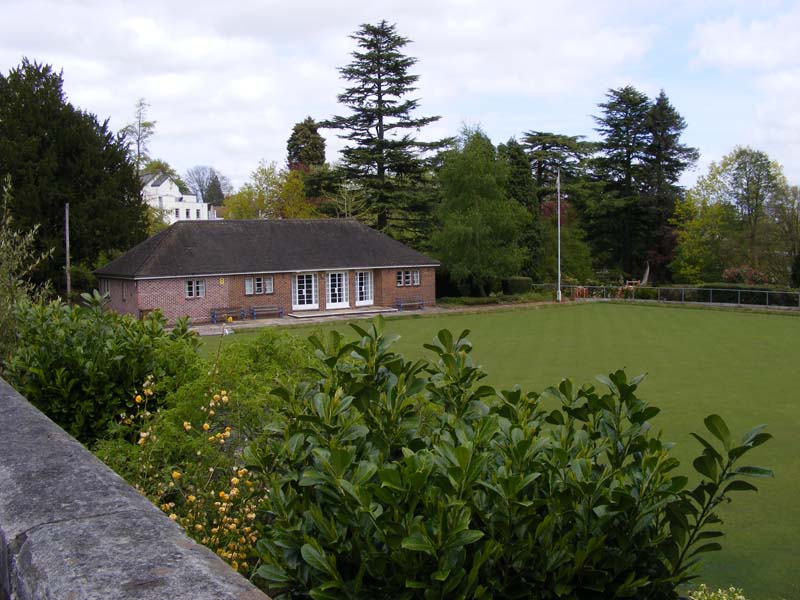
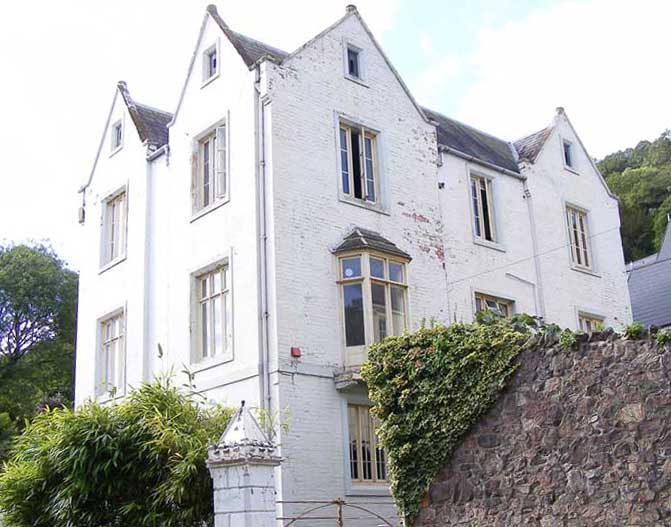 Fonthill College
located in Abbey Road was a small boarding school for young ladies aged
between about 11 and 17 years; it was in existence from about 1880 to 1912. The
property, now named Salisbury, is shown in the photo opposite. Fonthill College
located in Abbey Road was a small boarding school for young ladies aged
between about 11 and 17 years; it was in existence from about 1880 to 1912. The
property, now named Salisbury, is shown in the photo opposite.
Kelly's Trade Directory of 1876 recorded Fonthill, north
of Chatsworth House in Abbey Road as a lodging house run by Ann Grace. Soon
after, possibly because of a decline in the water cure, Fonthill
became a college for some 20 young ladies. In 1881 the co-proprietors
were Miss Ellen Mary Aldis born 1841 Long Melford, Suffolk and Emily
Billiter born Clapham about 1847. Ellen Aldis was the daughter of chemist
Henry Aldis and Emily was the daughter of corn merchant's clerk Richard
Billiter.
One of the governesses at Fonthill
College in 1881 was Selinda Geater. Earlier, in 1871 she had been governess to Herrick Augustus and Dorothy Palmer and
their four small children. They lived in Cardiff and he was then Captain and
Adjutant of the Glamorgan Militia.
In 1889 Rev William James Povey acquired the land on the
south side of Fonthill College for the purpose of building the present Baptist Church.
The book 'The Church at the Hay Well', how Baptists came
to Malvern, by EKH Jordan, mentions that Fonthill, the property now known as
Salisbury in Abbey Road, was considered to be a more eligible site for the
new Church, but the committee eventually accepted the recommendation of
Malvern Baptist Church to build on the Hay Well Bath site, because no
agreement could be reached regarding the Fonthill site - where the girl's
school was located.
The census records that by 1891 Ellen Mary Aldis had
moved to become a teacher at Mont Cambrai, Jersey, in the Channel Islands
while Emily Billiter had moved to join her sisters as School Principals in
Clapham. By 1889, Miss Selinda Ellen Geater seems to have stepped up to become the Principal at Fonthill College assisted by her sisters Susan
and Lucy.
The Geater sisters, born in Leiston, Suffolk, were the daughters of
successful tailor Charles Geater and Fanny Munnings Gooch. We were told
their story by a family historian (ref 13) who mentioned that the Berrows
Worcester Journal of 3rd August 1889 contained an announcement that Fonthill
was to be offered for sale. To quote:
The detached freehold residence known as Fonthill in
Great Malvern is for sale by auction on 8 Aug 1889 and is currently in the
occupation of the Misses Geater at £120 per annum. It has extensive frontage
on to the Abbey Road, Great Malvern. It contains 3 reception rooms, 8
bedrooms, Bath, Box and storerooms, spacious cellarage and excellent Domestic
Offices also large Garden, Ornamental Pond, Cottage, Greenhouse and 2-stall
Stable. Harness-room and Coach-house.
It would seem that the property was either not sold or it was
bought by the Geater sisters for they were still there in 1891, but by 1901 Fonthill College had moved to St Chad's in Orchard
Road where Selinda Geater was still Principal.
Possibly the move to St Chad's had
something to do with the noise and upheaval associated with the construction of the Baptist church next door.
Apparently establishing a firm foundation for the church proved to be very
difficult and costly because of the springs.
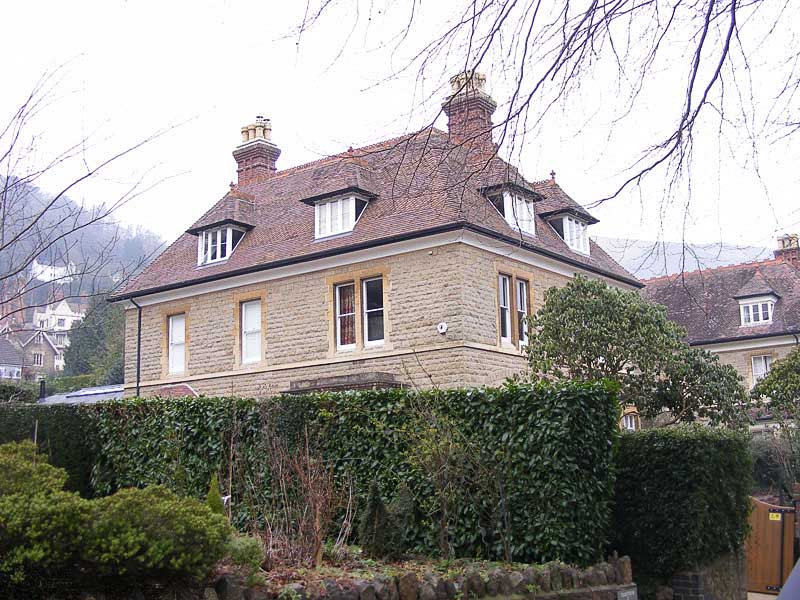 Chadsmore
(shown) appears the twin of St Chads, next door Chadsmore
(shown) appears the twin of St Chads, next door
St Chad's had been advertised unfurnished 'To
Let' in 1888. It had three large reception rooms and nine bedrooms (The Times, 18
Jan 1888).
Kelly's Trade Directory recorded auctioneer John Chippendale
Gibbs in residence in 1888, while the 1891 census recorded Wheatley
Robertson and his family in residence; Colonel Wheatley Robertson, retired
Madras Staff Corps, was born in India about 1834 and died in Hampshire in
1910. He had been commissioned Ensign, the 5th Madras Native Infantry, in
1852.
The National Probate Calendar records that sadly Selinda's
sister Lucy Louisa Geater died at Fonthill College on 10th March 1904 aged
only 50 years. Her executor was manufacturer's agent Alfred Geater who we
think was her married elder brother, a commercial traveller.
Selinda retired not many years after, about 1906, and
moved to live with her sister Susan at a house named 'The Willows' in
Blofield
which lies between Norwich and Great Yarmouth.
David Green relates:
The 1911 census recorded Selinda Geater aged 58, retired
principal of a school, living at the seaside town of
Lowestoft with her sister Susan, where they were probably on holiday at
Willingdon Cottage,
Pakefield built
about 1907; this was a very small bungalow, on a cliff-top close to the sea.
On the census form, Susan had written the bungalow had five rooms, perhaps kitchen, sitting-room and three bedrooms - they must
all have been very small! It was said to have been built by the owner of an
adjacent large house for the benefit of his guests (ref 42).
Susan died in 1926 and Selinda the next year in 1927; the
sisters are buried in Blofield churchyard. The simple inscription on their
memorial reads (ref 13),
In loving memory of
Susan Geater
Born April 16th 1850
Died July 24th 1926
Selinda Ellen Geater
Born October 19th 1857
Died December 1st 1927
In 1911 the Principal at Fonthill College (formerly St
Chad's) in Orchard Road
was Miss Ada Russell born Ireland about 1873. Kelly's Trade Directories
list her as the Principal of Fonthill between 1908 and 1912. Possibly then
the
lease ran out and the school had to close.
Kelly's Trade Directory of 1924 records Miss Lloyd-Jones at
Abbotshill and a Miss Sayle at Cherbourg.
Abbotshill is not shown on the 1884 map of Great Malvern
so may have been a later addition at 26 Abbey Road. It was latterly the home
of Leontine Elise Lloyd-Jones and her father Ebenezer, retired
headmaster of The Priory School, who had died in 1922. Possibly she set up a small school there and employed the
younger Miss
Sayle at Cherbourg, but we don't know for sure.
Sadly her brother Edward Harold Lloyd-Jones, also briefly
headmaster at the Priory School,
Great Malvern, had died in London in 1912, leaving a widow and two small children.
Her youngest brother Major Percy Arnold Lloyd-Jones had a
distinguished military career in the Royal Army Medical Corps. Sadly he died
of wounds on 22nd December 1916 in France. He is remembered on the Great
Malvern Priory War Memorial,
Malvern Remembers
website, and at
Great Malvern cemetery.
Miss Lloyd-Jones' eldest brother, Ernest, became a medical practitioner in
Cambridge, where she herself died in 1955.
Perhaps having no family to pass her school on to, it is
possible Miss Lloyd Jones sold her establishment to the younger Miss Sayle
who founded Ellerslie.
The 1871 and 1881 census record that Wellington House,
number 43 Abbey Road, was for a time a school for young ladies run by Elizabeth Jay and her
business partner Joyce Chapman.
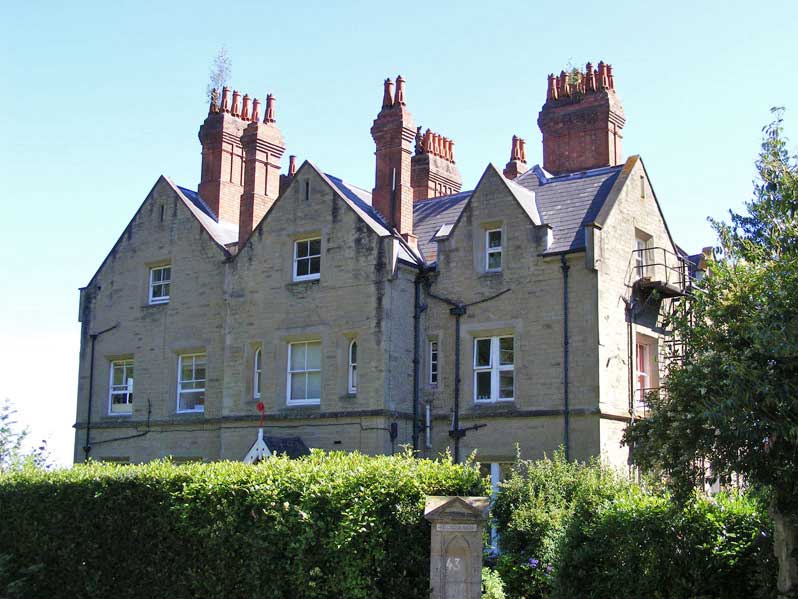
Prior to this, in 1861, Elizabeth Jay and Joyce Chapman
were running Oakfields Academy for girls at Droitwich Road, Claines, not far
from Malvern Link.
Joyce Chapman was born Croydon about 1823
Elmsdale, erected about 1853, and Hardwicke House, which
stood next door, were built for Dr
James Loftus Marsden to accommodate water cure patients.
Caroline Cooper
James Loftus Marsden seems to have been away abroad a
lot, and we are beginning to wonder how successful his water cure business was, for as
early as 1857 Elmsdale was occupied by
Miss Caroline Cooper who ran a Ladies'
School in Abbey Road, where she is recorded in the 1861 census.
Towards the end of the 1860s Trade Directories suggest
the school briefly moved to Holly Mount
mansion above the Worcester Road, before moving
to another large house named Malvernbury, two doors along from Elmsdale in
Abbey Road.
Holly Mount, which had bowed windows providing fine views over
the Severn plain, had earlier been rented to the Duchess of Kent and Princes
Victoria for 6 weeks when they visited Great Malvern in 1830.
The 1871 census records Caroline Cooper's school at 'The
Bury' or 'Malvernbury' as it was later known. The head
teacher in charge on census day was Julia Marten Duplock who in 1861 had
been a governess at the school, along with her two sisters Matilda Marten
Duplock and Eliza Marten Duplock. On census day Caroline Cooper herself, born Reading about 1822, was a
visitor in Somerset, describing herself as Principal of a 1st class school.
Also at Malvernbury was Caroline's niece Sarah aged 21 years described as a
governess.
Littlebury's Trade Directory of 1873 records Miss Cooper
as Principal of a Ladies School at Malvernbury in Abbey Road, where she died
on 15th January 1873 (ref 17). The school continued for a short while
under the management of the niece Sarah HP Cooper and Julia Duplock until it was bought by Janet
Leighton who moved the school to Lawnside. Julia Duplock, formerly of
Malvern, died at Petersfield in 1875 aged only 42 years. Sarah Cooper left
the school and became a teacher, living to a good age.
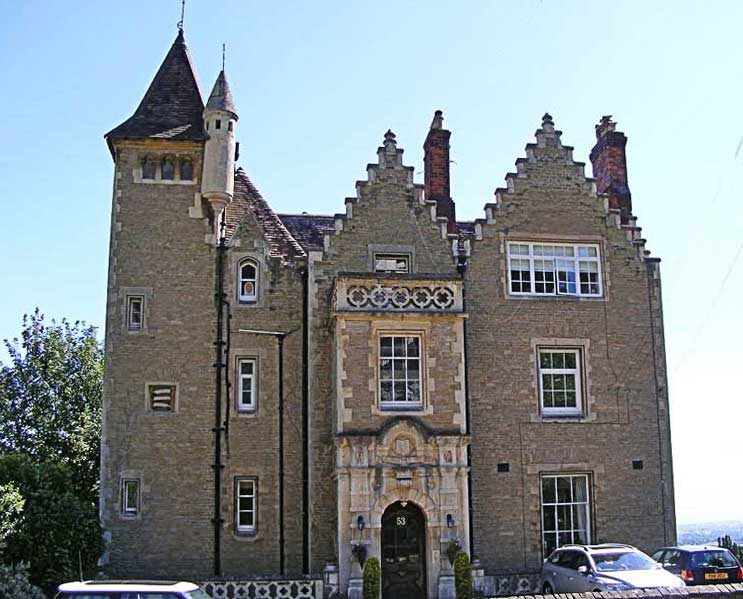
Photo above: 'Elmsdale' in Abbey Road
Unfortunately we do not have a photograph of Malvernbury as it was
rebuilt and the present house is now screened by trees and houses.
Rachel Rose Gilbert
We don't know why Caroline Cooper left Elmsdale in the
late 1860s, but the 1871 census and Littlebury's Directory and Gazetteer of
1873 record that the house then became another school known as
'The Ladies College' run by Mrs Rachel Rose Gilbert. This school was also listed in
the publication 'Schools for Girls and Colleges for Women. A Handbook of
Female Education, Chiefly Designed for the Use of Persons of the Upper Middle
Class' published by Charles
Eyre Pascoe in 1879. The Victorians were obviously very class conscious!
Rose the daughter of a teacher and methodist minister had
married her brother-in-law schoolmaster George Mowbray Gilbert after her
sister Sarah died. In 1851 George Mowbray Gilbert had been running the Goodenough
House School (42 boys) at Ealing which had been started by Rev Samuel
Goodenough (1743 - 1827) later Bishop of Carlisle. Former pupils of
Goodenough House included the prime minister Henry Addington, Viscount
Sidmouth (1757-1844), the diplomat and collector Thomas Bruce, earl of Elgin
(1766-1841), the antiquary Barré Charles Roberts (1789-1810) and the soldier
Sir Robert Walpole (1808-76)
In 1861 George and Rose were in Worcester,
and in 1871 at Elmsdale in Great Malvern, when she is described as a
schoolmistress and he as a fund holder. George died at Elmsdale in 1877, and
Rose died there on 5th April 1879, so it would seem the latter school was in
existence for no more than ten years. At the time of the 1881 census Elmsdale
was uninhabited and presumably advertised to let.
Rose's son
Walter Raleigh Gilbert was a gifted cricketer and cousin of the
cricketer WG Grace. To avoid a scandal involving petty theft, Walter had to emigrate to Canada.
Sadly his youngest son 2nd Lt Archibald Holmes Gilbert,
22 Squadron, Royal Flying Corps, was a casualty of the Great War and died in Belgium on 21st September 1917.
He had transferred to the RFC from the Canadian Infantry.
Fanny Elizabeth Ridley
Trade directories indicate that Elmsdale House continued
to be used as a private school until at least 1908. In 1888 Fanny E Ridley was the Principal of the school,
but it had changed from being a ladies' school to being a preparatory
boarding school for young boys.
Fanny Ridley was born in Bridgenorth in 1848 the eldest
of seven children of whom three died in childhood. Her parents were seed
merchant Edward William Ridley and Elizabeth (Lizette) Lander.
In 1871 Fanny was a governess at a school in
Kidderminster run by her Aunt Elizabeth Frances Ridley. Also governesses
were
Elizabeth's cousins Catherine E Bennett and Dora Townley.
By 1880, following her father's death, Fanny became Principal of a private boarding school
for boys at Needwood House in Kidderminster. Needwood House was purchased
for Kidderminster Hospital in the 1930s and converted into a nursing home.
In 1881 Fanny's Aunt Elizabeth was still
the Principal of Broomfield Hall school for girls in Franche Road,
Kidderminster. Broomfield Hall, an imposing mansion, was demolished in the
1960s; a small photo can be found on the Kidderminster Civic Society web
site.
An 1888 Trade Directory and the 1891 and 1901 census
record Fanny as the Principal of a private boarding school for boys at
Elmsdale House in Great Malvern. She is last listed in a Trade Directory of
1908 when perhaps she decided to retire on reaching the age of 60 years. The
1911 census records her as a retired boarding house keeper staying at
Queensborough Terrace in Paddington; she died at Salisbury in 1926.
We don't know who took over the school from Fanny Ridley,
but Pauline Connolly in her book The Water Doctor's Daughters relates an
advertisement of 1908:
A Home School for little Boys. Preparatory for the Public
Schools and Navy.
Ellerslie, at the south end of Abbey Road, became a well
known Public School for girls but exists in
name only now as a boarding house at Malvern College.
The school was founded as a private boarding school for
girls in 1922, or thereabouts, and remained in existence for 70 years before
merging with Malvern College in 1992.
The photo below taken in March 2015 shows the empty
Victorian building as the adjoining science block (left, out of picture) was being demolished in preparation for building a retirement village on
the site. The roof of the lodge adjacent to the entrance can just be seen above the shrubbery.
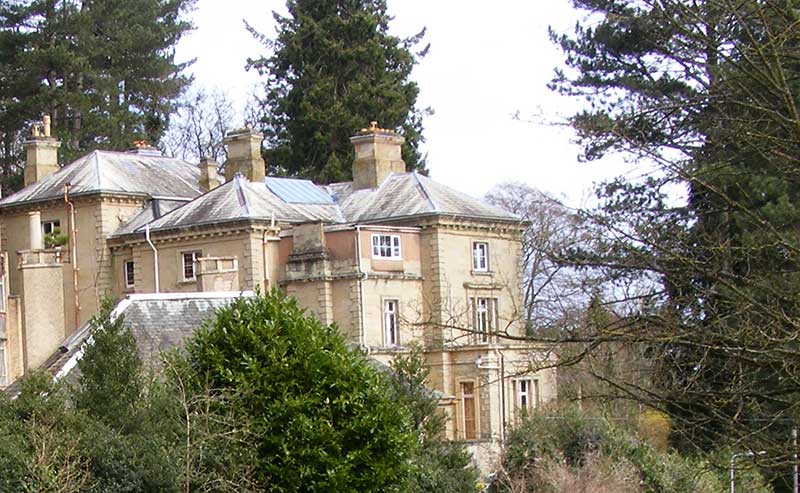
Ellerslie House, after the school closed
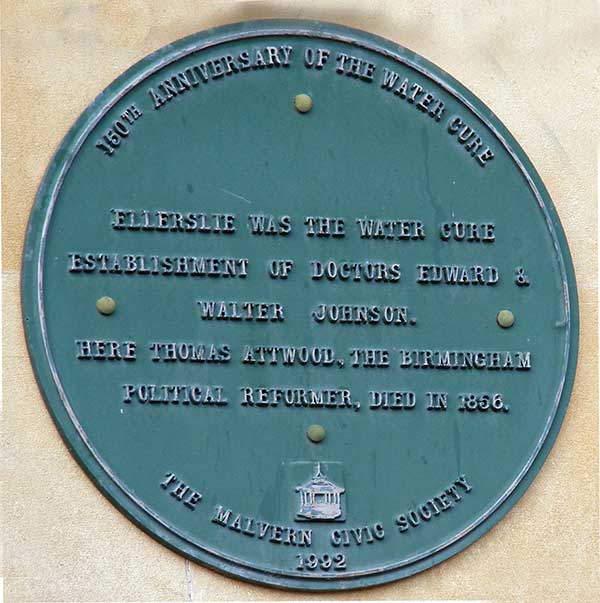 On
the wall of the lodge was a green plaque placed by Malvern
Civic Society in 1992. On
the wall of the lodge was a green plaque placed by Malvern
Civic Society in 1992.
It records that before the school was founded:
Ellerslie was the water cure establishment of
Doctors Edward and Walter Johnson.
Here Thomas Attwood the Birmingham political reformer
died in 1856
The meaning of the name Ellerslie or Elderslie is obscure,
but possibly it refers to 'field of the elder trees'.
Founding of the school
In 1914 men of Great Britain had been called to arms and
soldiers were dying in large numbers. There was little demand for large
country houses then and between 1914 and 1917 Ellerslie, which had been
advertised to let, lay empty.
According to Kelly's Trade Directory of 1917, the first school
to be located at Ellerslie was 'North Foreland Ladies School'
whose principal, Miss Wolseley Lewis, had started her school in 1909 at
North Foreland, a chalky outcrop near Broadstairs. Presumably the
school had been evacuated because of the First World War, as
afterwards North Foreland Ladies School returned to Kent.
In 1924 Kelly's Trade Directory recorded another private boarding
school for girls at Ellerslie, telephone 201; Ellerslie Lodge was then the school
sanatorium. The Principal was Miss Gladys Mabel Pearson Sayle,
daughter of an export merchant, born London about 1889. Miss Sayle, who
founded the school about 1922, remained Principal until 1957.
A directory of 1964 records that
Miss MD Prior, BA Oxon Hons, Geography, was the next headmistress.
The school had a Christian ethos. Kelly's
Trade Directory of 1950 recorded that Revd Canon William
Norman Willson was a chaplain to the school. He lived nearby at Beverston on
the Wells Road and died in 1956; born 1872, he was educated at Emmanuel
College, Cambridge, and was made a Canon of
Salisbury in 1930. A former pupil told us that the chaplain occupied Ellerslie Lodge
in the 1960s.
In the 1970s a new science block with study bedrooms
above was built on the south side of Ellerslie, which was opened by the
education minister,
Margaret Thatcher MP,
later to become Prime Minister. A stone plaque marked the event. That may
have been on 19th March 1971 when Margaret Thatcher gave a short address on
the occasion of Ellerslie School's Golden Jubilee, which was reported the
next day in the Worcester Evening News.
Previously pupils had attended science lessons at Malvern
College, and in earlier days there had been a chemistry laboratory in the
grounds.
The diagram below, based on the recollections of a former
pupil, shows the relative position of the buildings on the main Ellerslie
site. In the 1960s the art studio was in an adjacent house named Cherbourg.
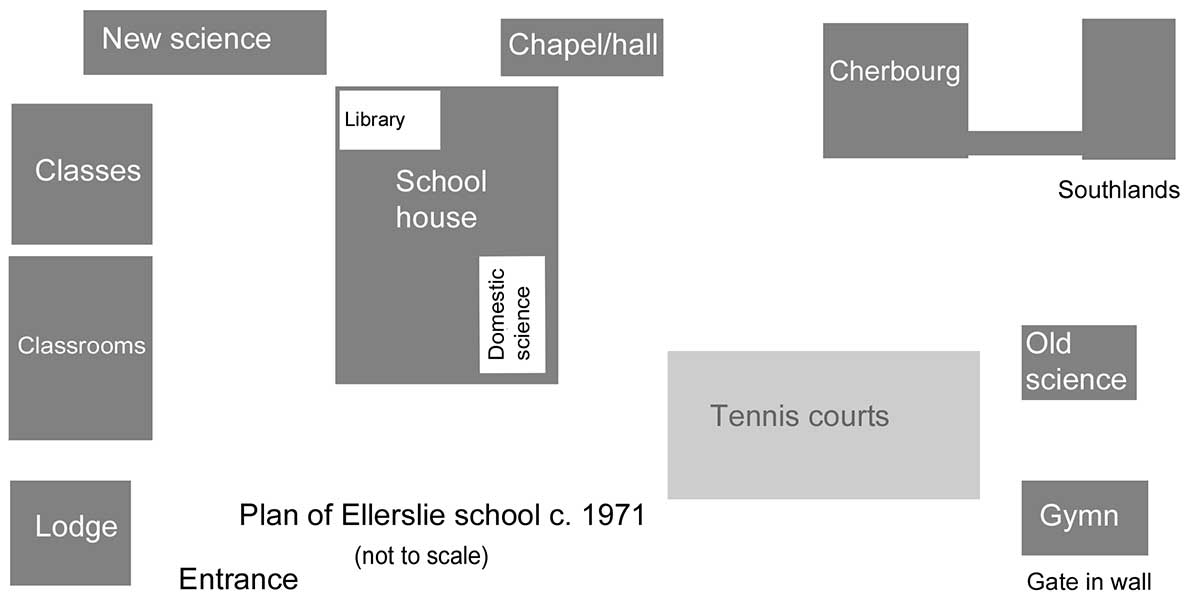
Plan of the Ellerslie site
The photo below shows a line drawing of the north face of
Ellerslie made in 2015 when the house was empty awaiting redevelopment.
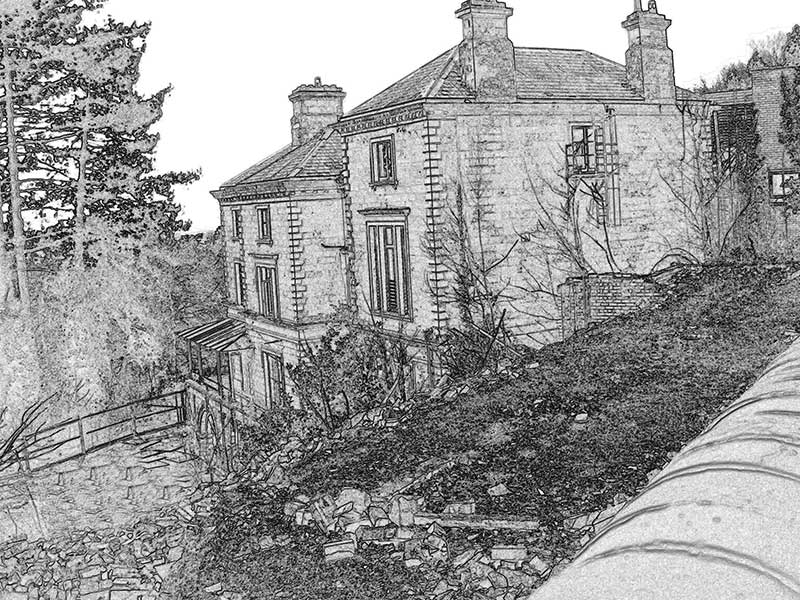
Ellerslie from the Wells Road
Below the boundary wall there was an assembly hall/chapel
which was demolished after the site was sold.
We have not, as yet, found a history published of the school but
this advertisement circa 1955 described it thus:
Ellerslie, Great Malvern
Recognised as efficient by the Ministry of Education
Boarding school for girls from 13 years of age with
preparatory school for girls from 7 to 13 years of age
Principal Miss Sayle
The school is situated 535 feet above sea level, on the
slope of the Malvern Hills.
The school buildings consist of four houses standing in
adjoining grounds of 12 acres in which there are 5 tennis courts, a school
chapel, a swimming bath, school hall, a fitted gymnasium, reference library
and laboratory. The school has central heating and every modern convenience.
The high tone in the school is of first consideration.
There is a splendid health record and every home comfort is given.
A course of domestic science may be taken in all
its branches under a highly qualified mistress; special prospectus available.
Girls may be prepared for the Cambridge General
Certificate of Education; London University matriculation and Inter. BA BSc;
RAM and RCM school and local centre music examinations; Secretarial Diplomas;
Royal Life Saving Society examinations.
There is a fully qualified staff of 16 highly qualified
mistresses including, English, French, Science, Mathematics, Music, Art,
Gymnastic, Dancing, Secretarial, and
Froebel mistresses and 6 well trained
and experienced matrons.
Delicate girls receive special care and are not
pressed with their work. All forms of cramming are avoided.
In the 1960s the school occupied four Victorian
houses: Ellerslie, Cherbourg, Southlands, and Hampton House
across the road.
The illustration
below shows the rear of the houses known as Cherbourg and Southlands.
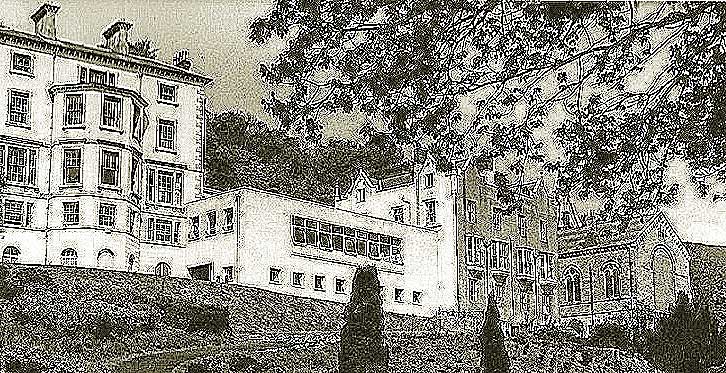
Cherbourg and Southlands
Southlands on the Wells Rd, which is next to Emmanuel Chapel on the turning to the
Wyche, provided accommodation for the Upper 4th (13 year olds) and
Cherbourg (left of image), accommodation for the Lower
5th (14 year olds).
The two houses were joined together by the school dining
room with the music block underneath and overlooking tennis courts below.
The views from the dining room windows were said to be 'absolutely
spectacular and many wonderful sunsets were seen in the evenings; on bad
weather days the houses were often above the clouds'.
Earlier the dining room had been in the basement of
Cherbourg.
Prep department
From about 1925, Hampton House, on the east side of Abbey Road, was the prep
department for younger girls, and provided
accommodation for domestic staff in the 1960s.
Kelly's Trade Directory of 1958 confirmed Hampton as the preparatory school for Ellerslie.
See photos of Hampton House
below, which were kindly provided by a former pupil of Ellerslie. Note the
many chimney's, for coal fires, which have since been removed.
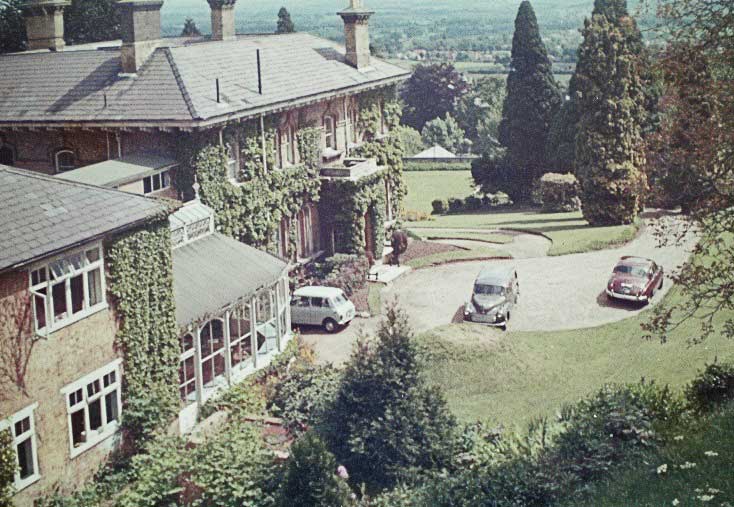
Hampton House circa 1965
On the south side of Hampton House there was an open air
swimming pool, with changing rooms on the slope above, see photo below.
The pool is said to have been filled with soil,
after Ellerslie closed.
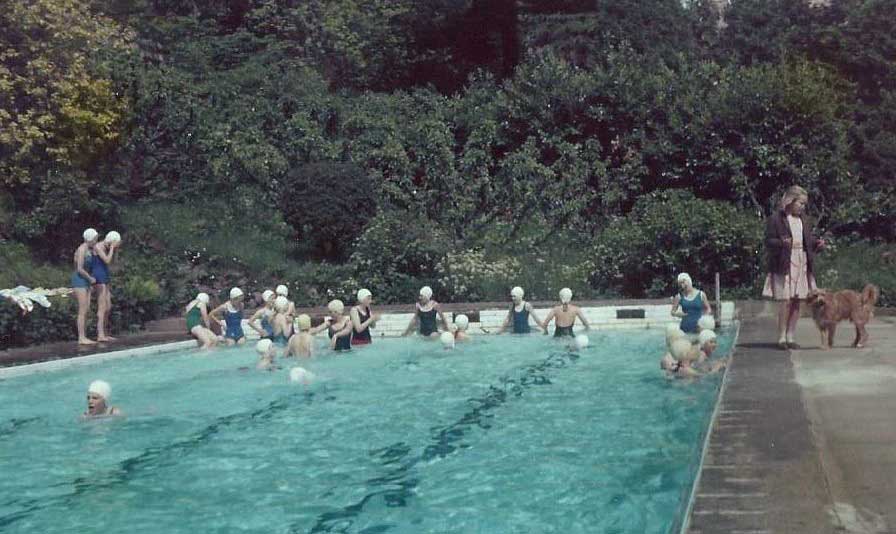
Ellerslie swimming pool next to Hampton House, circa 1965
There were also tennis courts below Hampton House and a
gymnasium built in the grounds named Margaret Prior Hall, after a former
headmistress.
A former Ellerslie pupil recalls:
Before Miss Prior, who was head of Ellerslie when I was
there in the 1960s, the school was run by a Miss Sayle and a Miss Scale.
They only retired about a year before I went there. My Aunt, Vivian Cooke,
taught Art there during WWII before she moved to the Abbey School. She remembered them
well; apparently both characters! Ellerslie Lodge was used as a house
for our school Chaplain.
Due to dwindling numbers, Ellerslie, which had been
elevated to the status of a Girls'
Public School, and Hillstone Prep School, from Como Road, merged
with Malvern College in 1992 and the Ellerslie 'complex' became a
co-educational prep department for Malvern College. Ellerslie eventually moved to new buildings in
College Road and in 2009 the prep department moved to the Downs School at Colwall
which was
started by the Cadbury family, who were Quakers.
The land and buildings were then sold to Audley Court Ltd
who applied for planning permission to develop the site for a
large retirement village, which in 2016 was under construction on the site of Ellerslie, Cherbourg and Southlands.
These homes appear to be well built but possibly too expensive for many
local people to afford.
Hampton House was sold on to another developer who has
converted Hampton into six apartments, renamed Magnolia House, and is
building terraced homes and coach houses in the grounds - the development has been named
Bellmere Gardens approached by a new access from College Road.
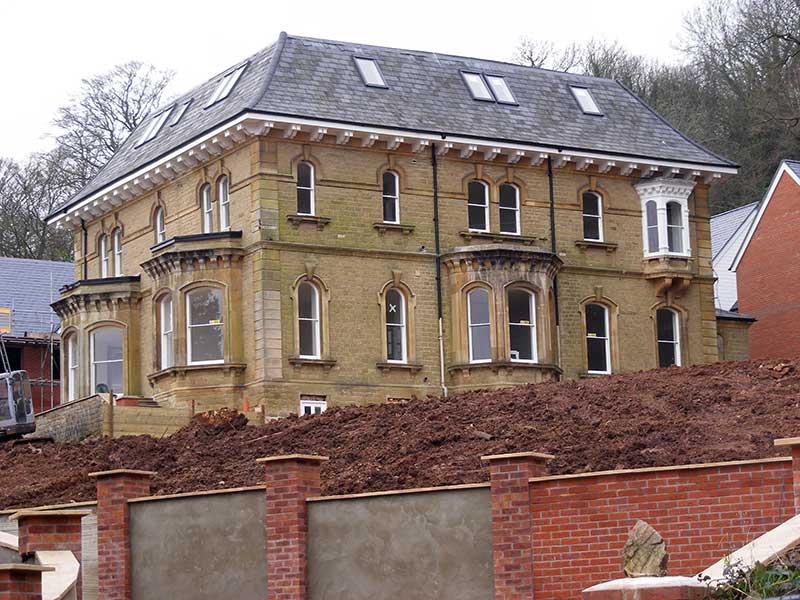
The Bellmere Gardens development at Hampton House
It is believed that, after the sale, a photographic record of the Ellerslie
site was made by Malvern Civic
Society while the buildings were empty. There were said to have been
some fine fireplaces in Ellerslie and Cherbourg which were stolen while the
properties were unoccupied. Other photographs dating from 1926 are held by
Malvern College and we hope to add some of those to the website shortly.
Click to read our biography of
Gladys Sayle, founder of Ellerslie
school.
The Abbey School for girls (now the site of
Abbey College)
occupied a large Malvern stone mansion with a prominent clock tower
in Malvern Wells and other premises. Recently we were able to discover a lot
more about the school after Diana Moores told us her mother was a pupil
there in the 1930s.
Click to read The
Story of the Abbey School Malvern Wells
Briefly, the school was founded in Blockley, then in
Worcestershire, by Mrs Margaret Judson in 1881. Her daughter
Florence Judson moved the school to Hazel Bank on the Worcester
Road in Malvern Link, and then to The Abbey in Malvern Wells in 1908. The
Abbey 'closed' in 1979 after amalgamating with St James in West
Malvern. Then St James and the Abbey 'closed' after amalgamating with
Malvern Girls College forming Malvern St James, which occupies the site of
the old Imperial Hotel in Avenue Road. The site of St James and the
Abbey in West Malvern has become the Elim
(Pentecostal) International Centre, an evangelical church movement.
In 1940, Kelly's listed the headmistress as Miss Alice Judson
(Florence's younger sister),
and in 1950, Miss A F Evershed. We have been told the uniform was grey coats
and boaters or grey felt hats; the hat bands were possibly red and white.
The school magazine was appropriately known as the Hazel
Nut.
Kelly's directory of 1940 lists Thorn Bank School for Girls in Malvern
Wells, Miss H M Rogers, head mistress. The school is again listed in 1950, but it
is believed to have closed soon after due to financial difficulties. Thorn
Bank is a large white house on the eastern slope of the Malvern Hills which
still exists today.
Daphne who attended the school in 1947 said that she shared a room with
two princesses called Alum and Frikata from Ethiopia. 'We wore purple coats,
grey tweed tunics, grey stockings and black hats'.
If you can tell us more about the school, please get in touch.
Seaford Court prep school for boys was founded in 1901 in
the seaside town of Littlehampton,
by Mr AC Clarke. The 1939 Register records the school was then in Berry Lane
and the headmaster was Eric SR Milton.
Eric Sidney Ryland Milton was born in Cape Colony, South
Africa, in 1886 and was educated at
Brasenose College
Oxford. In 1916 he married Doris M L Lowth. The couple had two children
Geoffrey and Pamela.
In 1940 Seaford Court School was evacuated from the coast to Malvern Link and occupied Fern Lodge, 185 Worcester Road, once the home of
HFS Morgan,
the founder of the
Morgan Motor Company. Eric Milton died in
1958 and his son Geoffrey Dennis Leslie Milton, born in 1926, became the next headmaster.
Geoffrey was only 13 years at the start of WWII,
but he may have seen some service as on 1st February 1946 aged 20 years
Geoffrey was appointed a 2nd Lt in the Lincolnshire Regiment. In 1955
Geoffrey had married Cheri JD Moriarty at Dublin.
About 1977 Seaford Court merged with 'The Elms' in
Colwall and circa 1980 the site was bought by the NHS with the intent to build a
local hospital. However throughout the period when Margaret Thatcher was
Prime Minister there was no money and Seaford Court was left to rot and it
became a blot on the landscape.
On 10th December 2008, when Tony Blair was Prime
Minister, the derelict building was demolished by Interserve, a Facilities
Management business, following which the new Malvern Community Hospital was
built and opened in 2011.
Interserve collapsed into administration in March 2019
and was bought by creditors including Royal Bank of Scotland and HSBC.
Ordinary shareholders lost their money.
Click to read Guardian report on Interserve.
Click
to watch video about the school and the demolition of Seaford Court
Geoffrey Milton, still a relatively young man, then became a farmer and died only
recently in 2010.
A former pupil recalls that the masters used to live in
Broom Lodge, next to Seaford Court, and that he found the school the best he
had been to!
Hillside was founded by Francis William Quibell
Smith and his wife Dorothy F James in
the 1950s (ref 5). Latterly including properties next door to Seaford Court on the Worcester Road,
it became
a very large prep school for day pupils.
At its peak it was rumoured to have had about 400 pupils.
FW Quibell Smith born 1907 was the son of Reverend
Francis Archie Smith, latterly Rector of Brierley Hill, and Mary Louisa
Quibell. The 1939 census records him as a Music Master living with his wife
and a child in Bromsgrove.
The Musical Times records he had been Choirmaster and
Organist at St Edmunds Dudley, and Music Master at Lichfield Grammar school.
He may also have played at Great Malvern priory.
The first Hillside School was a mixed school taking boys
and girls at 171/173 Worcester Road, probably the properties earlier named Inchbrook
and Hilton, with Mr and Mrs F W Quibell Smith in
charge.
In about 1961 the Boys’ School was established lower down
at 179 Worcester Road; the property had been earlier named Hazel Bank, a
girls' school run by Florence Judson, and later Amestrey boys' prep.
See Hazel Bank and
Amestrey
Hillside also incorporated St Cuthbert's next door which
had previously been a prep school for boys but, between 1947 and 1959, was a
convalescent home annexed to Birmingham Children’s Hospital.
When Francis Quibell Smith died on 16th January 1983 his
son John took over as headmaster.
Hillside closed in 1991 but shortly before that St
Cuthbert's was demolished
by McCarthy and Stone in order to build Morgan Court which provides
sheltered accommodation for the elderly overlooking Malvern Link Common.
Perhaps payment of death duties had something to do with that?
Littlebury's Trade directory of 1873 refers to a much
earlier boarding school named Hillside in West Malvern. This Hillside was
founded in about 1870 by farmer's son Rev Edward Ford MA, a graduate of St
John's College, Cambridge.
He is first recorded at Hillside in the 1871 census, with
his wife Marianne and 9 children aged between 12 years and 6 months.
The 1881 census recorded in residence, Rev Edward Ford
aged 55 years, his wife Marianne and their children; 24 pupils aged between
9 and 14 years; a nurse, cook and 3 housemaids. Next door at Beaulieu were
two schoolmasters, two pupils and a page boy/groom. Three of Rev Ford's
sons, Edward Wilton, Charles Whitemore, and Ernest Henry were described as
schoolmasters so by the 1880s it must truly have become a family
business.
One of the pupils was Herbert Graham Ford, the son of Rev
Ford's brother Henry Edmund Ford who in the 1881 census is recorded as
Organist at Carlisle Cathedral.
An advertisement of about that time reads:
Hillside school, West Malvern
The Rev Edward Ford MA, of St John's College Cambridge,
assisted by his two Sons and by able Masters, receives BOYS to prepare for
the Public Schools, Professions, Universities etc.
Hillside School which is most beautifully situated on the
western slope of the Malvern Hills, has been established for some years, and
has been specially adapted for Pupils, with Large, Well-Ventilated
Schoolrooms, Dining-hall, and Dormitories, also with Bathrooms, Large
Swimming Bath, Large covered in Playroom and Gymnasium, Large Fives'-court,
Carpenters'-room etc. There are also good Cricket and Football Fields.
FRENCH and GERMAN Taught by a Resident French Master, BA
of the University of Paris.
One wonders how Rev Ford found the money to develop these
facilities given the school only supported a limited number of pupils.
About 1887 Rev Ford became Rector of Exhall with Wixford,
possibly leaving one or more of his sons in charge at Hillside, but we
speculate the school may have encountered financial problems as by 1891 the
headmaster was Walter Churchill Perry aged 42, while only one son, Ernest
Henry Ford, is still a schoolmaster.
A Norwich Union fire insurance document suggests by 1896
the following people might be joint owners of the school:
Walter Churchill Perry (the new headmaster)
Rev Hildebrand Thomas Giles Alington
William Salter (1863-1948) son of William Charles Salter,
last Principal of St Alban Hall Oxford (who would become headmaster)
Charlotte Sophia Isaac, the daughter of a banker in
Worcester
By 1901 William Salter had become headmaster of Hillside;
he had been educated at Malvern College in Great Malvern, and Merton
College, Oxford.
His advertisement reads:
Hillside, West Malvern
Preparatory for the Public School
and Royal Navy
Headmaster W Salter Esq MA Merton College, Oxford
Assisted by
Residential Masters
The School is beautifully situated on the western slopes
of the Malvern Hills 1,000 feet above sea level and commanding extensive
views of almost 46 miles. It is sheltered from the east by the range of
hills. It is conveniently situated for both Great Malvern and Colwall
railway stations.
The School Buildings include Chapel, Covered Swimming
Bath, Gymnasium and Playroom, Covered Fives Court, Carpenters' Shops,
Laundry etc. Excellent Cricket and Football Field.
The regular school course
includes Divinity, English subjects viz - History and Geography, Latin,
Greek, French, Mathematics etc. Class Singing in the winter.
Complete
prospectus will be forwarded on application to the Headmaster
William Salter is not listed at Hillside in Trade Directories
after 1908 and by 1911 he is joint headmaster of
Eastman's Royal Naval Academy near Winchester.
The Times records that in 1910 Hillside was put up for
sale but there was no buyer.
We cannot find Hillside in the 1911 census so assume the
school may have been empty at the time.
Trade directories record Edward Capel Smith as the next
Principal from 1912 to 1921, who had earlier had a school at
Fairfield.
Edward Capel Smith (1857 - 1923) born
Thruxton Herefordshire was the eldest son of Reverend Edward Braithwaite
Smith and Maria Hanbury. His father married second in 1867 Ann Harrison.
Edward junior was educated at Queen's College Oxford BA 1881. The 1881
census recorded him as a teacher at
Aysgarth in Yorkshire, while in 1891 he was a tutor living in Penzance.
In 1901 and 1911 he was recorded living at Fairfield with his half-sister
Mary Harrison Smith who may have become his housekeeper.
The Times records that in 1922 Hillside was again advertised for sale and we
assume, after some 50 years of existence, it then closed and became a private residence.
An entry on Wikipedia suggests that
Hillside School in West Malvern relocated to the Worcester Road in the
1950s, but local opinion is that these were definitely separate establishments.
Hillstone was a private preparatory school for boys,
founded about 1880, located near
Great Malvern Library, at the bottom of Como Road. In
1992 the school was acquired by Malvern College, transferring to the old Ellerslie
girls' school site
in Abbey Road, before becoming part of the Downs School at Colwall.
Kelly's Trade Directory of 1872 lists the building where
the school started as a lodging house run by Catherine Smith. By 1880 it had
become a private boarding school for boys run by Emily A Chaffer, and her
school continued to be listed in Kelly's until 1896. The school was then run
by Edith Lord and her sister Ellen who were born at Crewe in Cheshire; the
1911 census also recorded in residence 18 boys aged 5 to 14 years, a cook and
2 housemaids.
Kelly's trade directories records clergyman Rev Alfred
Hooper MA (1892 - 1955) as the headmaster from 1921 to 1936. The youngest
child of a commercial traveller, he studied at Hatfield College, Durham,
becoming priest in 1915. In 1914 he had married music teacher Amy Elizabeth
Folliott Blandford.
The Times, 18th May 1937, announced the dedication of a
new school chapel:
Hillstone School Malvern
In the presence of old boys, parents, and friends the
Bishop of Worcester (Dr AWET Perowne) dedicated a new school chapel at
Hillstone, Malvern, on Sunday. The ceremony was preceded by the opening of a
library and of handicraft rooms by Dr
Cyril Norwood, President of St John's
College, Oxford, and chairman of the school council. The chapel was designed
by Mr MW Matts, of London. Dr Norwood in opening the library, said that with
the addition of the new premises the school was now well equipped as any
preparatory school in the country.
Only a fortnight later on 5th June 1937 the Times
reported Rev Hooper would be
resigning as headmaster due to ill health:
Headmastership of Hillstone School
Because of a renewed breakdown in health, the Rev A Hooper
has tendered his resignation of the headmastership of Hillstone School
Malvern, after 19 years' work. The new headmaster appointed is Mr A R Barbour
Simpson of Canford School. Educated at Mostyn House, Parkgate, and at
Morrison's Academy, Crieff, he is a BSc in Engineering of Edinburgh, and an MA
of Cambridge (Natural Sciences Tripos). He has been house master at Canford.
Mrs Barbour Simpson is the daughter of Dr Cyril Norwood who is chairman of
the governors of Hillstone. The new headmaster will take charge of Hillstone
in September.
Rev Alfred Hooper may have been the
clergyman of that name who during the Second World War became an RAF chaplain with the rank of
Sqn Ldr.
After retiring from Hillstone, it seems Rev Hooper turned
his hand to writing text books and lecturing on mathematics. After the
Second World War he travelled to the USA, with his wife and
daughter, and a Pennsylvania newspaper reported a lecture he gave in 1947 thus:
A dramatization of the whole field of mathematics was
given to students of the Bloomsburg State Teachers College, Thursday June
17th, by Alfred Hooper, noted British educator, author and lecturer.
Speaking on the subject, 'The River Mathematics' Dr
Hooper made interesting a subject that, for most people, is lifeless and
uninteresting. The English educator, who served for a number of years as
Headmaster of the Hillstone School in Malvern, England, wrote a best selling
non-fiction book 'Mathematics Refresher' as well as the 'The River Mathematics'.
A third book will be published this year.
Dr Hooper is also the editor of a mathematical film that
has been produced by the American Council of Education. In his lecture at
the College, Dr Hooper indicated that mathematics is the key that opens up
the treasure-house of modern science.
It is bringing closer and closer to us the power to
control forces of nature that are utterly beyond our present imagination. To
understand the part played by mathematics in the rapidly unfolding tale of
human endeavor is essential for men and women of today, and even more so for
men and women of tomorrow.
He was also the author of 'A Modern Course in
Trigonometry'.
Rudolf Barbour Simpson had married Barbara Norwood the
youngest daughter of the Headmaster of Harrow School at Wimborne Minster in
1932 and many distinguished people were ar their wedding. They are recorded
at Hillstone in the 1939 Register.
Only one school master was recorded at Hillstone so
presumably the other teaching staff lived out. In residence was John Denys
Wall born 1910 the son of John Clifford Wall, Rector of Kelmarsh in
Northhants who had been educated at Malvern College and Clare College
Cambridge. In 1942 the London Gazette records John Denys Wall was an
Aircraftsman so possibly a member of RAF ground crew. He died at New Milton
in 1985.
Meanwhile, back in Malvern, Kelly's trade directory of 1940
recorded:
Hillstone School Ltd. (A R Barbour Simpson MA, BSc, FRSE,
head master), Como Road TN 57.
Alexander Rudolf Barbour Simpson (1901 - 1977) was
the son of a surgeon and the grandson of Sir Alexander Russell Simpson (1835
- 1916) MD, LLD, Emeritus Professor of midwifery and the diseases of women
and children at the University of Edinburgh. He was the author of several
books such as Asia, 1939; Africa, the Americas, Australia - New Zealand; the
British Isles (geography of the world series), 1952; and Europe including
the USSR; a slightly odd choice of subject seeing he had taken an
engineering degree.
We have been sent two undated pictures of Hillstone
school pupils and staff, by Norman May, which we think may have been taken
in the 1940s (ref 5).
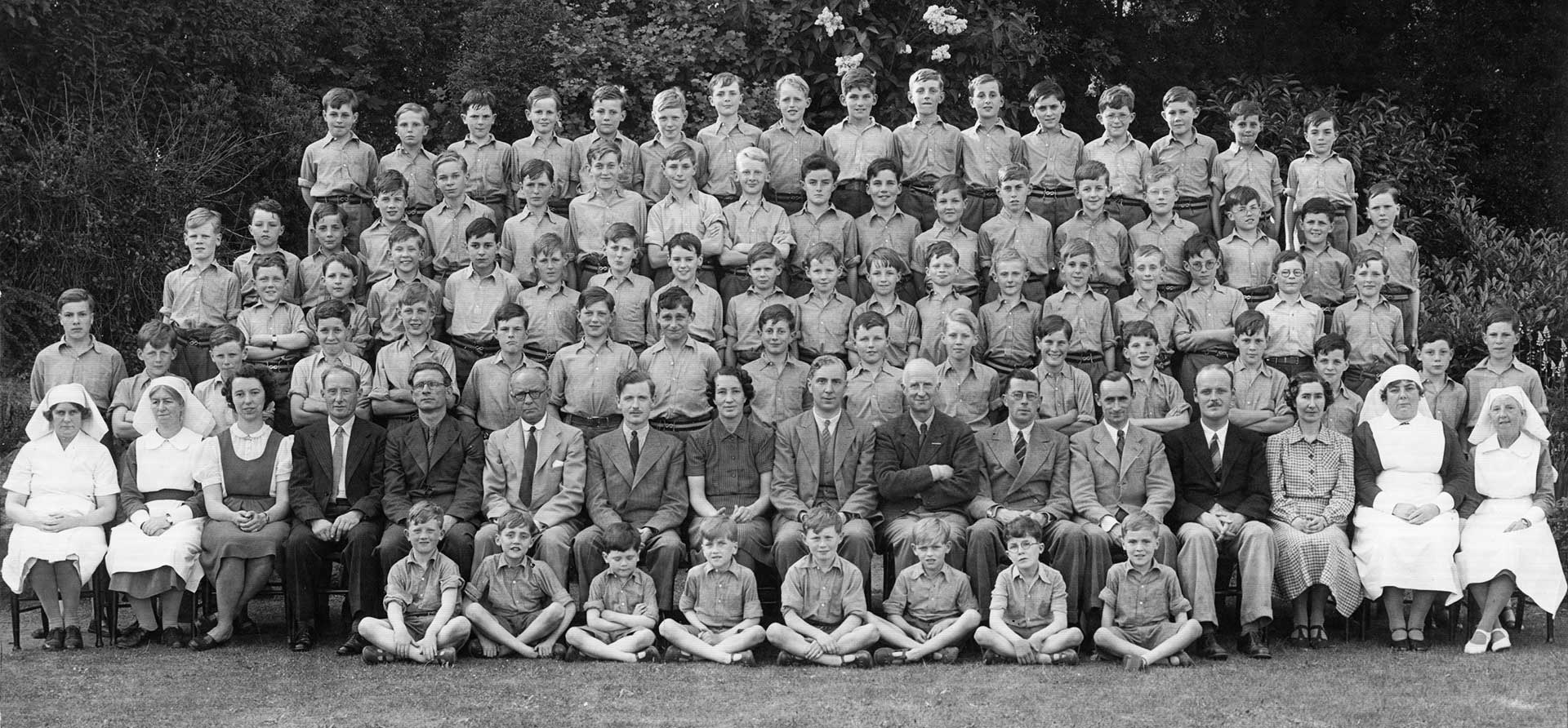
Hillstone school circa 1944
(click photos to enlarge)

Hillstone school circa 1945
It is thought the second picture shows Headmaster Rudolf
Barbour Simpson, and his wife Barbara in the centre of the second row; fifth
from right is
Sergeant Basil George Hirons, a local man, who taught woodwork and gym;
later he came in to teach at The Hill School above the Worcester Road in
Great Malvern and St Richard's Roman Catholic school in Malvern Wells. The
girl in the front row could be the headmaster's daughter.
Do tell us if you can name any others and provide an
exact date for the photos.
Barbour Simpson was still at Hillstone in the early
1960s, but accounts in newspapers by AN Wilson circa 2011 hint he had to
resign
after certain allegations were made. Rudolf Barbour Simpson died at Colwall
in 1977.
The next headmaster was Christopher Hugh Torrance
(1924 - 1996), supported by his wife Eileen. He was the son of engineer,
John Rowland Torrance (1862 - 1946) and Gertrude de Winton Herbert Bradley;
his grandfather Thomas was an engineer, iron founder and inventor, of the
Bitton Foundry near Bristol. The Bitton Foundry was a notable business and
you can read more about it on the website of the
Bitton Parish History Group.
We know nothing of CH Torrance's education and early
life, but he is included in a list of people having diplomatic immunity in
South Africa in the 1950s, which suggests he held a government post,
possibly concerned with education, in South Africa.
The announcement of CH Torrance's death and funeral in
the Times on 13th May 1996 recorded that he had been headmaster of Hillstone
School Malvern from 1962 - 1983, a lengthy period of 21 years.
CH Torrance's elder brother Thomas Edward Roland
Torrance OBE, MA, CEng, FIMechEE continued the family tradition of working
in engineering. He retired with the honorary rank of Major from the Royal
Electrical and Mechanical Engineers in 1949, and was awarded the OBE in 1975
for services as Director of the Crane and Deck Machinery Group of
Stothert and Pitt Ltd.
The London Gazette recorded on 20th August
1965 that Hillstone School had been put into voluntary liquidation. Whether
this was due to Barbour Simpson relinquishing ownership or a dip in pupil
numbers we don't know. The Gazette reported:
Name of Company: Hillstone School Limited
Nature of Business: Preparatory School
Address of Registered Office: Hillstone School Malvern,
Worcs
Liquidator's Name and Address: Derek Ronald Andrew FCA,
Lyttleton House, Malvern, Worcs
Date of Appointment 5th August 1965
By whom Appointed: Members
In 1966 the London Gazette reported a general meeting of
Hillstone School would be held to report on how the assets of the school had
been disposed.
Presumably the school was purchased as a going
concern and continued under new ownership, but we have no knowledge of
either how
the school changed, what buildings the school eventually acquired, or pupil numbers.
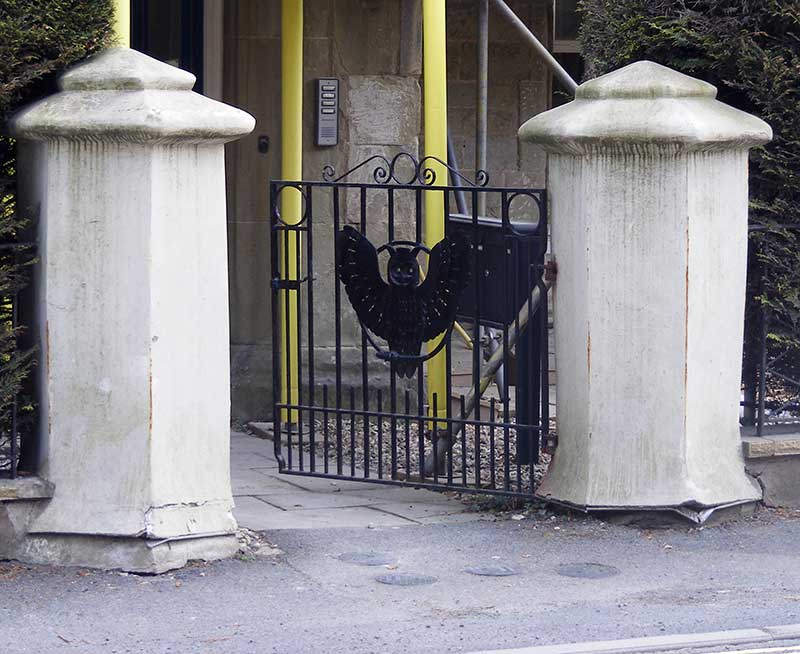 A modern advertisement for
Como House, now a
B&B, relates that the Hillstone
started there, but before it closed, we believe the school also occupied several
other properties including Rockburn at the
bottom of Como Road; the property on the corner at the top of Como Road may
have been the headmaster's house; we wondered if the school also occupied Springfield Lodge in Graham Road,
currently being redeveloped and covered by scaffolding, as there is a metal
owl on the gate similar to the badge on
the school blazer (see photo opposite). A modern advertisement for
Como House, now a
B&B, relates that the Hillstone
started there, but before it closed, we believe the school also occupied several
other properties including Rockburn at the
bottom of Como Road; the property on the corner at the top of Como Road may
have been the headmaster's house; we wondered if the school also occupied Springfield Lodge in Graham Road,
currently being redeveloped and covered by scaffolding, as there is a metal
owl on the gate similar to the badge on
the school blazer (see photo opposite).
The large apartments to the north of Springfield Lodge,
known as Hillstone House, and Hillstone Mews, are post war developments as
an aerial view of 1949 shows the land was not built upon at that time.
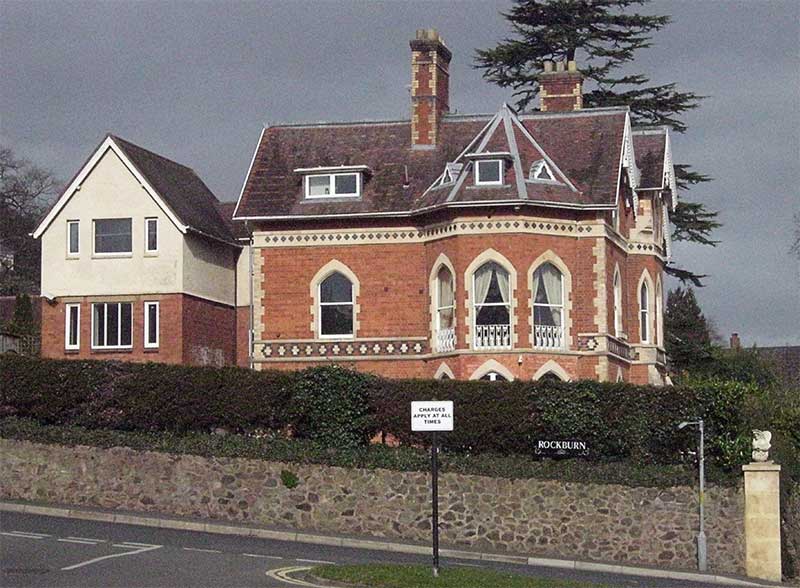
Rockburn, Como Road, in 2015 (now Charterhouse)
In 1986 the Times reported that a proposed merger between
Hillstone and the Downs School Colwall would not go ahead, but on 7th
September 1992 the Times contained a lengthy article about Malvern College
taking over both Ellerslie girls' school and Hillstone prep. At that time
private school were finding it increasingly difficult to find enough fee
paying pupils to cover their costs.
Following the merger, the school buildings and land in
Como Road were sold for residential
development, and blocks of apartments now occupy the site.
On the site of the old Ellerslie girls' school in Abbey
Road, Hillstone became a well loved coeducational school for boys and girls
aged between 3 and 13 years. The youngest children attended as day pupils at
Hampton House where a gymnasium was built in the wooded grounds. Cherbourg
and Southlands continued to be boarding houses, with classrooms at
Ellerslie, and tennis courts in the grounds below (ref 34).
So it was that Hillstone, one of the oldest and last
surviving boys' preparatory schools in Malvern, was acquired by Malvern
College in 1992, pupils moving first to Ellerslie and Hampton House in Abbey
Road, and finally being absorbed into the Downs School, Colwall in 2009.
Roger Gillard, who succeeded CH Torrance as headmaster was one of the last
headmasters.
Educated at Wadham College, Oxford, Roger Gillard retired
in 1998 after 15 years as Head of Hillstone. He was previously headmaster of
Milton Abbey School
(1977 - 1983), Master in charge of soccer at
Bradfield
College (1972 - 1977); assistant member of staff at Malvern College
(1962 - 1972) and at
King's College, Budo near Kampala (1971 - 1972). In 2009 he opened the
new pre prep building at The Downs School, which was named 'Hillstone' after
his old school.
The next headmaster was Peter Moody, who was headmaster
in 2004.
About 2010, the Ellerslie site was sold to
Audley, a
property development company that is building a number retirement villages
in the UK. The one being built on the site of Ellerslie is known as 'Audley
Ellerslie'. Audley Court Ltd is now part of the larger, London based,
Moorfield Group.
With an ageing population in the UK, the development of property for the
elderly seems to have become big business!
Do please let us know if you have either memories or
photos of Hillstone
School that could be used to improve this account.
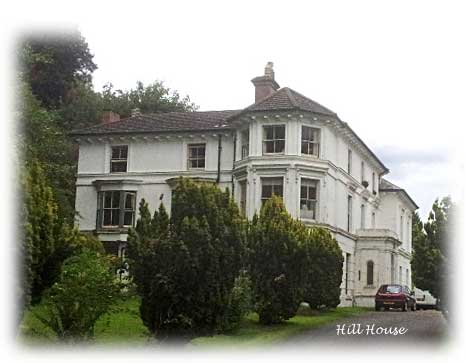 In February 2016 a former pupil kindly sent us
information about The Hill School, which was a preparatory boarding school
for boys. The school was situated above the Worcester Road in Great Malvern,
just north of the present TV mast and not far from Brays department store.
It was
approached by a narrow drive off the Worcester Road. In February 2016 a former pupil kindly sent us
information about The Hill School, which was a preparatory boarding school
for boys. The school was situated above the Worcester Road in Great Malvern,
just north of the present TV mast and not far from Brays department store.
It was
approached by a narrow drive off the Worcester Road.
The building is nowadays
divided into apartments (photo C Weaver).
The Lodge Spring, which still flows, is an ornamental
fountain on the left hand side of the private drive to Hill House. Cora Weaver and Bruce Osborne relate (ref 24) that the mansion
known as Hill House had much earlier been known as 'The Lodge' - Charles Darwin
had stayed there in 1849 - and for many years the house was the home of Sir
Henry Edward Francis Lambert, Baronet (1822 - 1872) and later his son Henry
Foley Lambert Grey. The latter had appended the surname Grey, as the result
of an inheritance. Henry Foley Lambert Grey inherited the Foley Estate when
his Aunt, Lady Foley, died in 1900; he sold the estate in 1910 but retained
The Lodge until his death in 1914. Currently we do not know when the name of
the house changed from The Lodge to Hill House, or who owned it between 1914
and the arrival of The Hill School.
The diary of Thomas Steed, who was a young gardener, records that in 1842 James Archibald Campbell, 6th Earl of
Inverneill, was living at The Lodge with his young wife and children.
James' wife, Jane
Augusta Campbell, died in childbirth that year causing him to return to
Scotland (ref 16); he married, second, Maria Grace Cameron and went on to have a second
family.
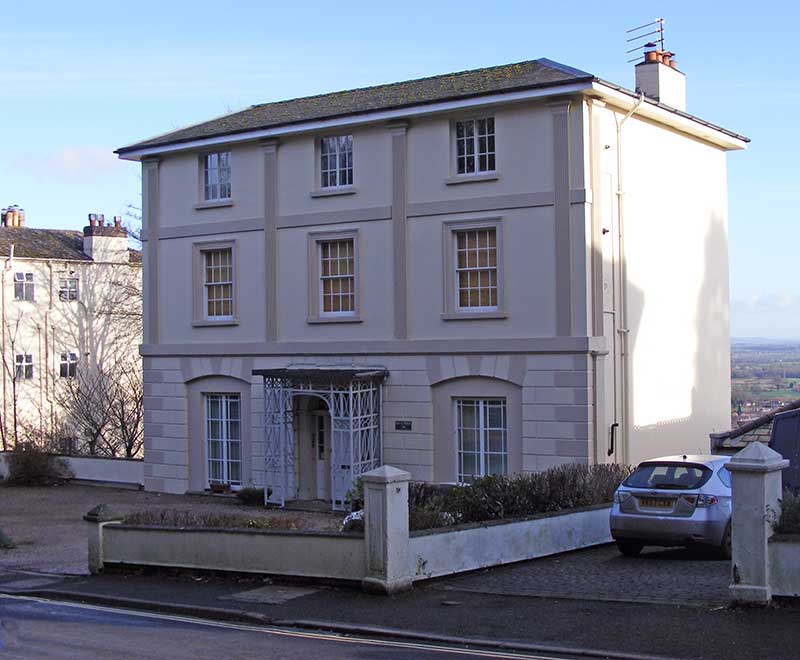 Next in residence was Mary Hind, the daughter of a
Liverpool merchant, with a sister and two nieces Mary Emma and Eliza Fenton;
their father Captain Lewis Fenton, 55th Regiment of Foot, briefly Whig MP
for Huddersfield, had died in Huddersfield in 1833 and their mother in 1837.
Mary Hind and her nieces moved across the road to Aucott House (see
opposite) where she
died in 1878. Eliza, the youngest niece, married Major David Mortimer Murray,
the son of a clergyman, in 1861, but died childless in 1869. He is buried
Barnwood
St Lawrence, Gloucester and his epitaph reads: Next in residence was Mary Hind, the daughter of a
Liverpool merchant, with a sister and two nieces Mary Emma and Eliza Fenton;
their father Captain Lewis Fenton, 55th Regiment of Foot, briefly Whig MP
for Huddersfield, had died in Huddersfield in 1833 and their mother in 1837.
Mary Hind and her nieces moved across the road to Aucott House (see
opposite) where she
died in 1878. Eliza, the youngest niece, married Major David Mortimer Murray,
the son of a clergyman, in 1861, but died childless in 1869. He is buried
Barnwood
St Lawrence, Gloucester and his epitaph reads:
Sacred to the memory of David Mortimer Murray, late
Captain in the 64th Foot, with the rank of Brevet Major in the army for
distinguished service on the staff of Lieut General Sir W Mansfield during
the
Indian Mutiny. Born 11th May 1832, died 24th January 1881.
More about
General William Rose Mansfield (1819 - 1876), 1st Baron
Sandhurst, Knight Grand Commander of the Order of the Star of India, can be
found on Wikipedia.
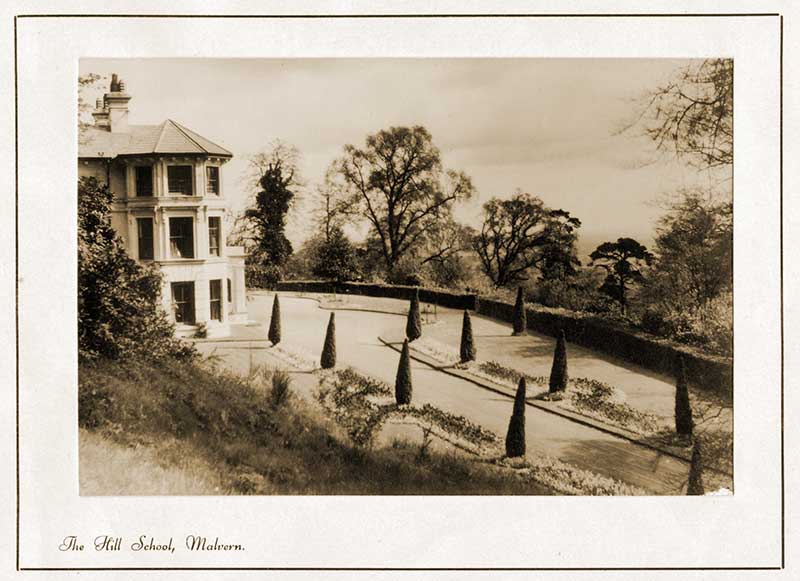
Sketch of 'The Hill School' from an early prospectus
The principal of the School was Lumley Fitzgerald Lyster
MA (1890 - 1958), who was educated at Cambridge University. He was the son
of soldier Lt Col Charles Bybie Lyster, once of West Malvern, and the second cousin of Vice Admiral
Sir
Arthur Lumley St George Lyster, who had a distinguished
career in the Royal Navy.
In 1917 Fitzgerald Lyster had married Gladys Faith Friend
Forwood, the daughter of a cotton merchant, born in the USA; Fitzgerald then
was a Lieutenant in the Army Ordnance Department.
Trade directories suggest 'The Hill School' was in
existence from about 1927 to 1957.
Pages from an early prospectus are shown below.
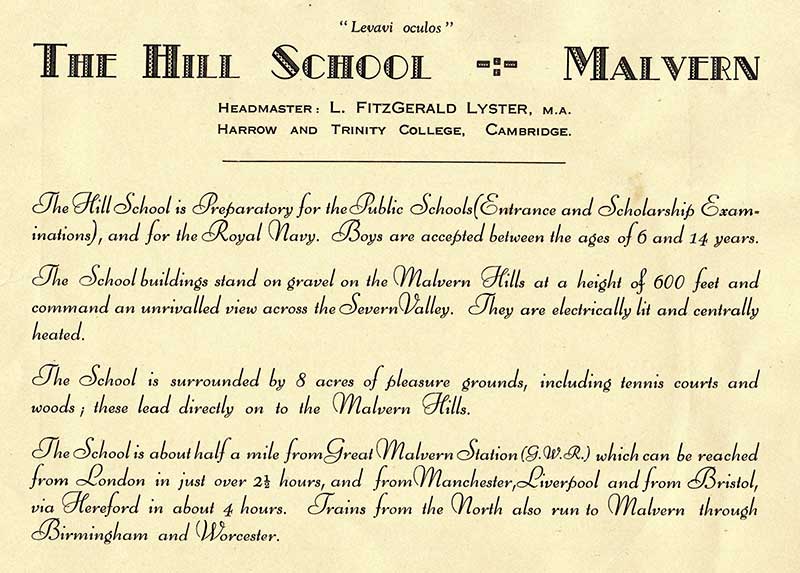
School Motto: Levavi Oculos
I have lifted up mine eyes
Perhaps this was based the psalm which begins 'I will lift up mine
eyes unto the hills from whence cometh my help; my help cometh even from
the Lord who hath made Heaven and Earth'.
The motto is most apt for a school lying under the
Malvern Hills; it unknowingly heralded the coming of radar to Malvern during WWII,
which the headmaster must have viewed with considerable interest.
Transcription of page 1
The Hill School, Malvern
Headmaster: L Fitzgerald Lyster MA
Harrow and Trinity College Cambridge
The Hill School is preparatory for the Public Schools
(Entrance and Scholarship Examinations) and for the Royal Navy. Boys are
accepted between the ages of 6 and 14 years.
The school buildings stand on gravel on the Malvern Hills
at a height of 600 feet and command an unrivalled view across the Severn
Valley. They are electrically lit and centrally heated.
The school is surrounded by 8 acres of pleasure grounds,
including tennis courts and woods; these lead directly onto the Malvern
Hills.
The school is about half a mile from Great Malvern Station
(GWR) which can be reached from London in just over 2 1/2 hours, and from
Manchester, Liverpool and from Bristol via Hereford in about 4 hours. Trains
from the north also run to Malvern via Birmingham and Hereford.
A second page includes the fees. Fees nowadays are
proportionately much more expensive, perhaps because a wider range of
subjects is taught and the expectation of parents is greater.
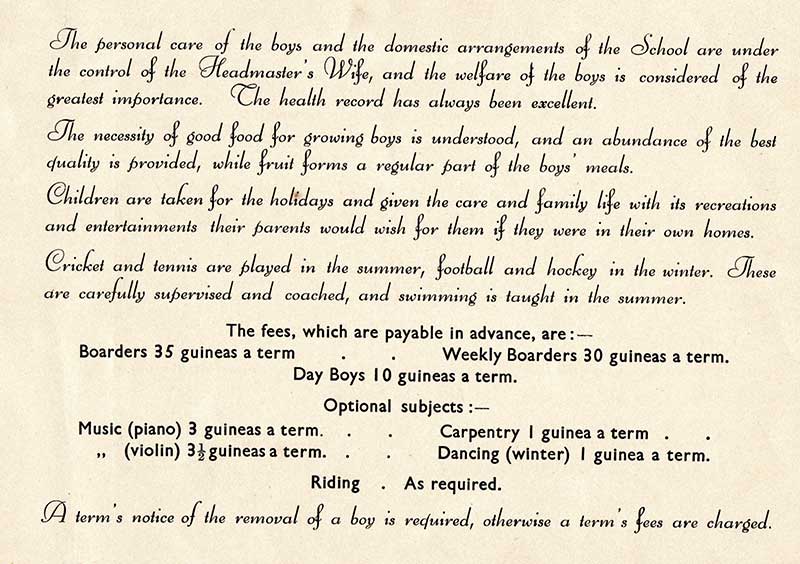
Transcription of page 2
The personal care of the boys and the domestic
arrangements of the school are under the control of the Headmaster's Wife,
and the welfare of the boys is considered of the greatest importance. The
health record has always been excellent.
The necessity of good food for growing boys is understood,
and an abundance of the best quality is provided, while fruit forms a
regular part of the boys' meals.
Children are taken for the holidays and given the care
and family life with its recreations and entertainments their parents would
wish for them if they were in their own homes.
Cricket and tennis are played in the summer, football
and hockey in the winter. These are carefully supervised and coached, and
swimming is taught in the summer.
The fees, which are payable in advance, are:-
Boarders 35 guineas a term, Weekly Boarders 30 guineas a
term
Day Boys 10 guineas a term.
Optional subjects:-
Music (piano) 3 guineas a term,
Music (violin) 3 1/2 guineas a
term
Carpentry 1 guinea a term
Dancing (winter) 1 guinea a term
Riding, as required
A term's notice of the removal of a boy is required,
otherwise a term's fees are charged.
A later prospectus dated 1946 repeats much of the
information above.
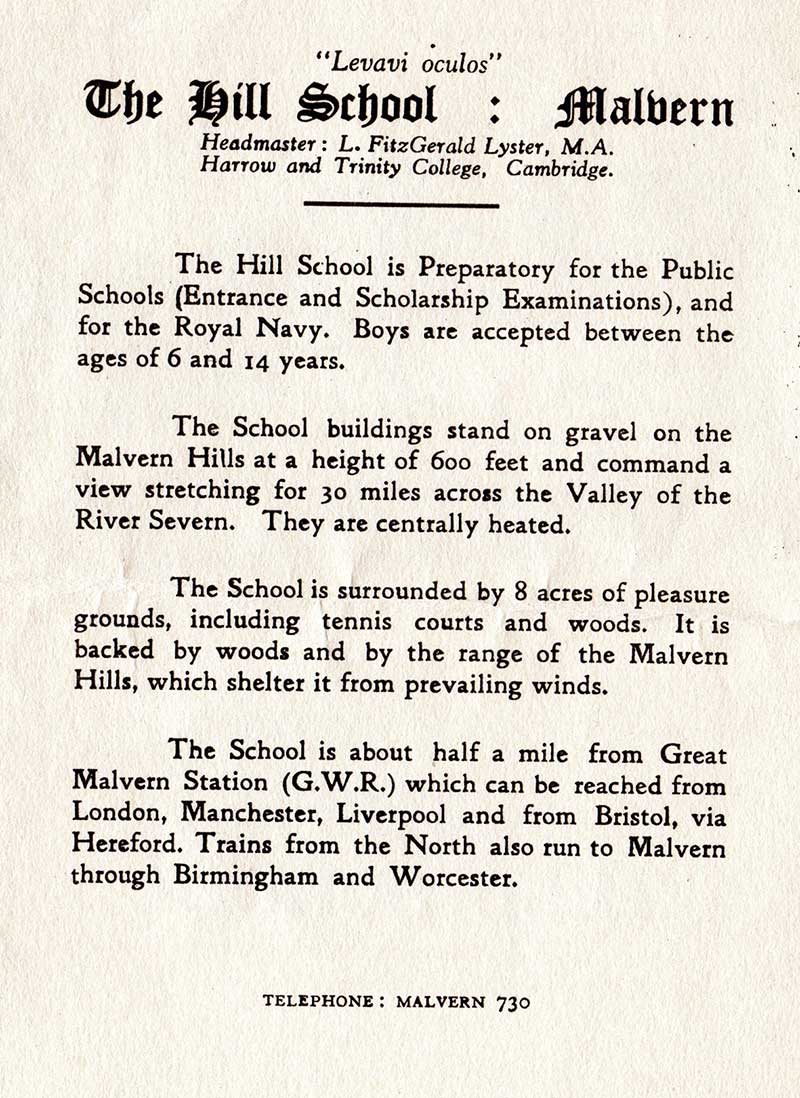
By the end of WWII the fees for boarders had gone up from 35 to 45
guineas per term.
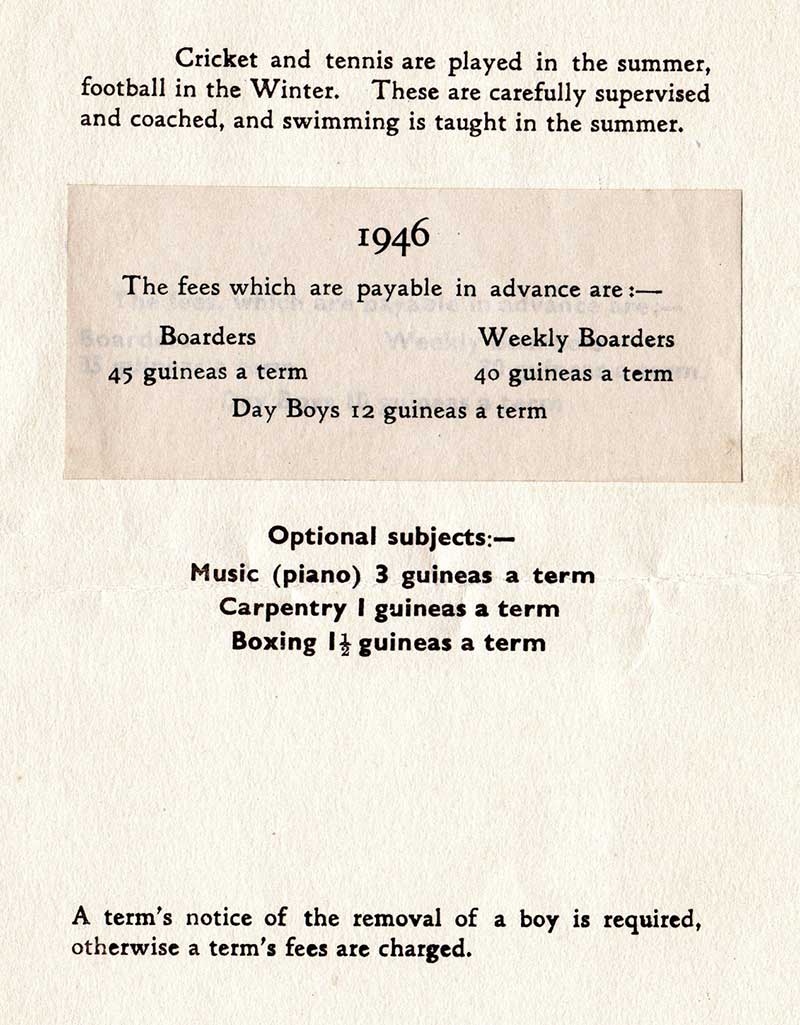
A further page listed parents of 'high' rank from whom references
could be obtained.
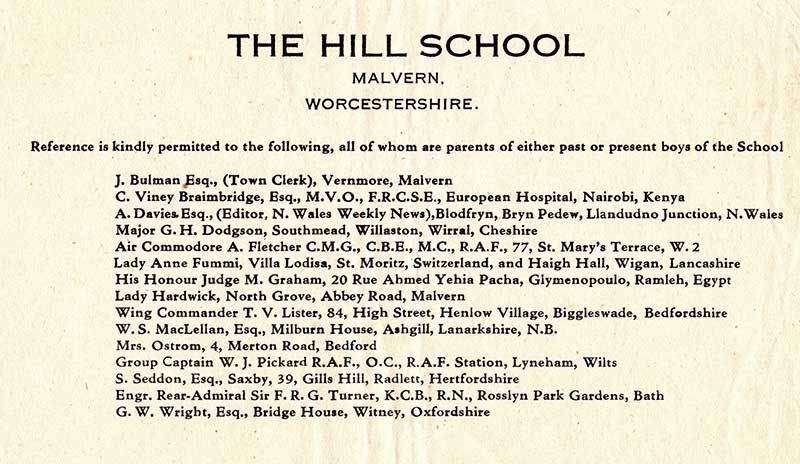
Transcription:
Reference is kindly permitted to the following, all of
whom are parents of either past or present boys of the school.
J Bulman Esq, (Town Clerk), Venmore, Malvern
C Viney Braimbridge Esq, MVO, FRCS(Edin), European Hospital,
Nairobi, Kenya
A Davies Esq, (Editor, N Wales Weekly News), Blodfryn, Bryn
Pedew, Llandudno Junction, N Wales
Major G H Dodgson, Southmead, Willaston, Wirral, Cheshire
Air Commodore A Fletcher, CMG, CBE, MC, RAF, 77 St Mary's
Terrace, W2
Lady Anne Fummi, Villa Lodisa, St Moritz, Switzerland, and
Haigh Hall, Wigan, Lancashire
His Honour Judge M Graham, 20 Rue Ahmed Yehia Pacha,
Glymenopoulo, Ramleh, Egypt
Lady Hardwick, North Grove, Abbey Road, Malvern
Wing Commander T V Lister, 84, High Street, Henlow
Village, Biggleswade, Bedfordshire
W S MacLellan Esq, Milburn House, Ashgill, Lanarkshire, NB
Mrs Ostrom, 4 Merton Road, Bedford
Group Captain W J Pickard, RAF, OC, RAF Station, Lyneham,
Wilts
S Seddon Esq, Saxby, 39 Gills Hill, Radlett, Hertfordshire
Engr Rear Admiral Sir F R G Turner, KCB, RN, Rosslyn Park
Gardens, Bath
G W Wright Esq, Bridge House, Witney, Oxfordshire
Former pupil Robert Kerrs sent us his memories of the
school, and a school photo (see below) which was probably taken either in
1952 or 1953.
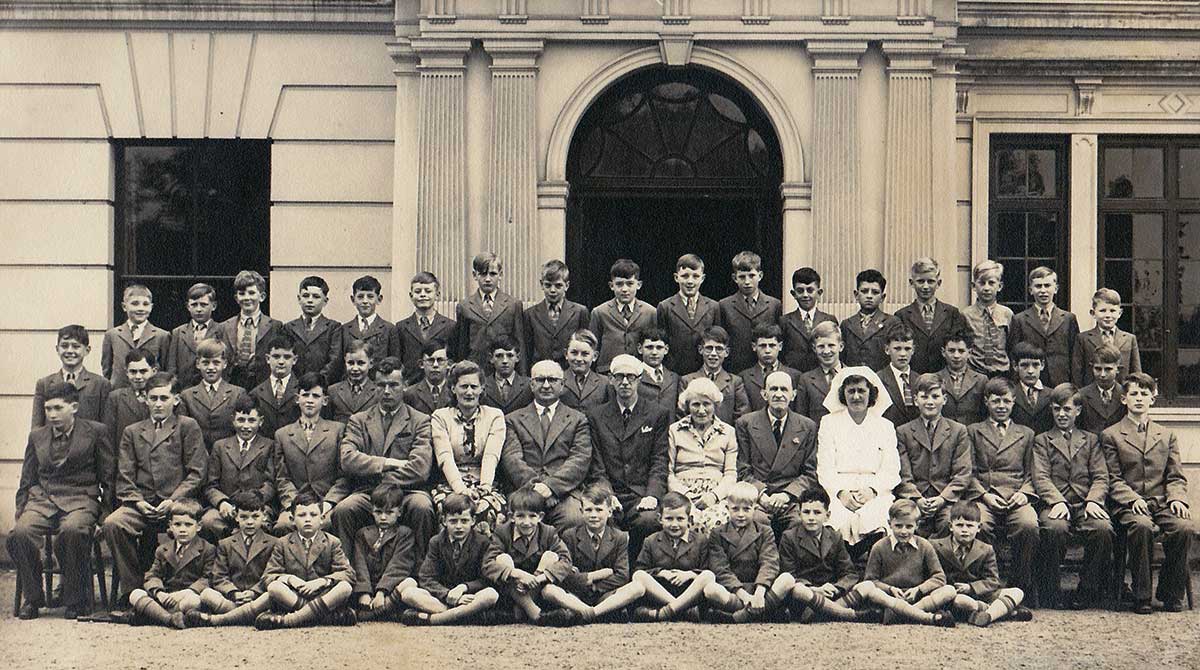
I was known as 'Bobby Kerss' at the Hill. Here are some
of my jottings exactly as they came to mind. Mr Lyster had almost the whole
of his left ear when I joined in 1951, but it gradually disappeared until
when I left in 1954 the ear had almost gone and as the photos show he was
wearing a head bandage to cover the remains.
I didn't know until now that Mr Lyster was a Christian
Scientist, but it probably explains why I was allowed to go to the Christian
Science church in Albert Park Road on my own each Sunday whilst the others
all went to Malvern Priory.
My memories of Sgt Hirons were woodwork of which I still
have 2 tea trays and a two tier table made in his classes. Woodwork was held
in the old courtyard garage and that was where we also had rifle target
practice with air rifles. He also taught boxing in a recreation room in the
house.
The game we played in the courtyard was by then called
'stump cricket' played with a tennis ball and cricket bat with both sides
cut off. I suppose it had developed from the earlier game. There were scores
for hitting the ball at various walls, but if you hit the ball over the low
wall on the left hand side you were immediately out.
There was no tennis in my days and we were not supposed
to go down there, just as we weren't supposed to go in the kitchen garden
and scrump the fruit. We did however have the run of the woods behind the
house (up to the top wall on North Hill) where we built a great variety of
dens.
The ornamental spring by the drive had a small pond -
great for trying out model boats. On some evenings we gathered in Lyster's
front hall to listen to approved radio programmes such as Dick Barton,
Journey into Space and the University Boat Race.
Other than a library of classic books in Form 2
schoolroom there wasn't a lot new to read other than possibly Boys Own
Paper, Meccano Magazine and Children's Newspaper, but my parents got Mr
Lyster to accept the new boys paper 'The Eagle' right from issue one.
Besides football played on a field a mile down the hill
in the Malvern Link area, the other memorable activity was the cross country
runs often around the perimeter of The Beacon and North Hill, and the
muddier we returned the happier we were. We all then shared baths on the top
floor of the house where the dormitories were, there being no showers. Other
than cross country runs, we had a shared bath once a week whether we liked
it or not!
At other times we went for walks on the Malvern hills
invariably taking in North Hill, the Sugarloaf and Malvern Beacon and always
calling in at St Ann's Well for the pure spring water (since bottled and
called Malvern Water). In winter we would go out tobogganing starting as far
up Happy Valley as we could and stooping at the wall at the top of St Anne's
Road before we plunged down the last stretch onto the main road. It's
probable inconceivable to modern safety conscious minds that we could do
this without anyone ever sustaining a single injury.
In February 1952, I was taken down to the dentist in Bank
Street (probably by Matron) for treatment under anaesthetic (gas) and when I
came round it had just been announced that George VI had died, so we passed
the news to Mr Lyster on return to tell the rest of the school.
I have attached a school photo possibly 1952/1953. The
chap left of F Lyster was John Ebden’s predecessor and a tartar for
discipline! John Ebden was a really nice guy and recognised my interest in
architecture by giving me a personal copy of his book 'Famous Buildings'
when I left in Summer 1954.
We don't know much about schoolmaster Edward John Ebden,
except that he was born in India in 1924, and his father had been an
official in the Indian Civil Service.
More photos of pupils and staff of the Hill School, from
the 1950s, which are shown below, were sent to us by John Webb; click
photos to enlarge.
Hill School group photo circa 1950 or 1951
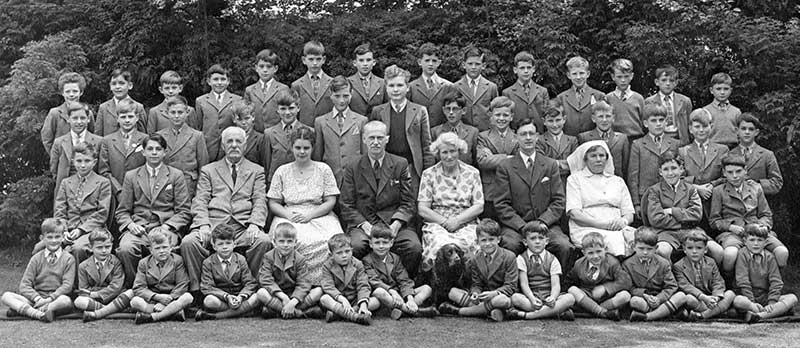
Staff above all seated left to right: unknown, Miss
Porterfield, Mr Lyster (headmaster), Mrs Lyster, unknown, Matron.
Hill School group photo circa 1951 or 1952
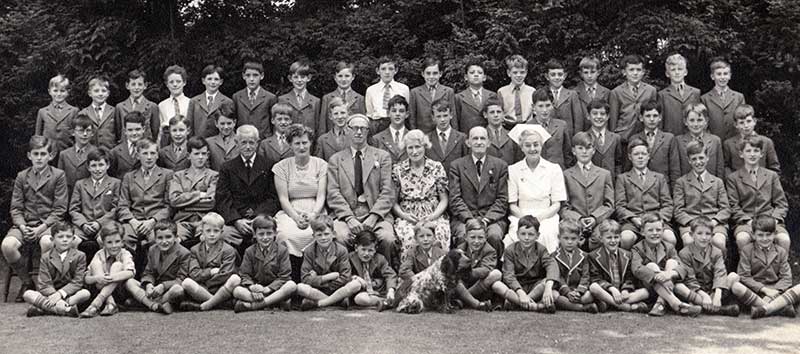
Staff all seated above from left to right: unknown but
this may have been Mr Fisher, Mrs S M Wilson, Mr Lyster (headmaster) Mrs
Lyster, Mr H M F Bode, who used to come part time to teach Latin, Matron.
Hill School group photo circa 1953 or 1954
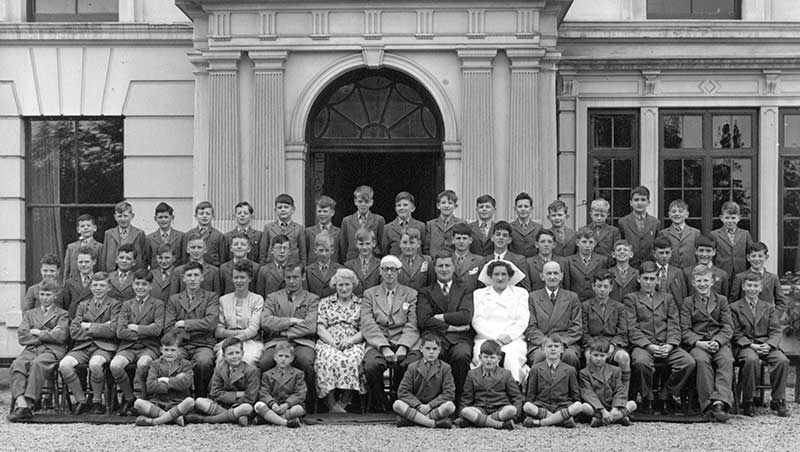
Photo taken at main entrance of the building. Staff all
seated above left to right: Mrs S M Wilson, Mr Peter S Gillott, Mrs Lyster,
Mr Lyster (headmaster), Mr Edward John Ebden, Matron, Mr H M F Bode.
Hill School group photo July 1955
The school photo below is annotated July 1955 on the
back.
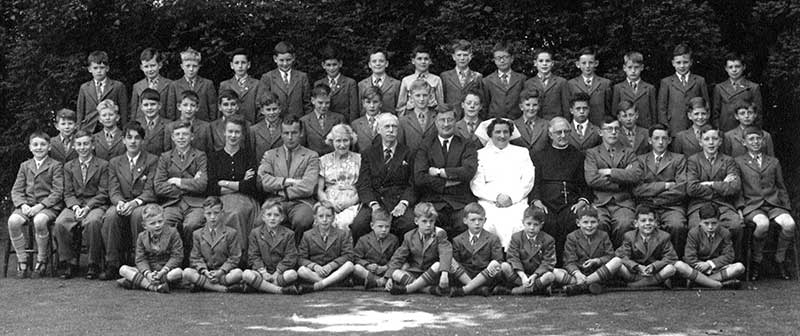
The Hill School, Great Malvern, July 1955
source: J Webb
The names of the staff, all seated, are thought to be, from left to
right of image: Mrs S M Wilson, Mr Peter S Gillott, Mrs Lyster, Mr Lyster, Mr Edward John Ebden, Matron, Father Scutt,
who came part time to teach Latin.
Former pupil John Webb, recalls:
Sergeant Hirons used to come to teach woodwork and
target shooting with air rifles. He also had us marching up and down and
drilling us as if we were in the army! He never appeared in any of the
photographs as far as I am aware. I always remember his advice in the
woodwork lessons; 'Only a fool puts his hand in front of a cutting tool'.
Ed. That final sentence is good advice, which we should
all occasionally remind ourselves of!
Hill School group photo circa 1956 or 1957
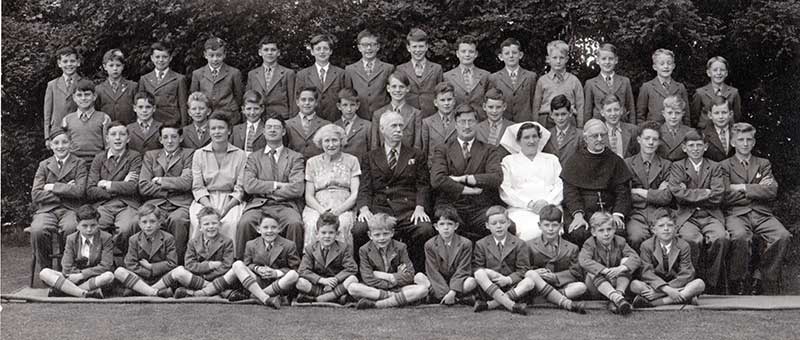
Staff all seated above from left to right: Mrs S M Wilson,
unknown, Mrs Lyster, Mr Lyster (headmaster), Mr Edward John Ebden, Matron,
Father Scutt.
We searched for Father Scutt in Crockfords Clerical
Directory. It seems likely he was Rev John Alfred Homer Scutt, the son of a
corn merchant, born Scarborough about 1892, who was educated at Cambridge,
BA 1913, and at Kelham Theological College, Nottingham, where he later taught. In 1917
he served as a 2nd Lt with the Hampshire Regiment in France; on his medal
card are written the initials MC and we wonder if that meant he was a
military chaplain. In 1942 he became an RAF chaplain with the equivalent
rank of Flt Lt and later Sq Ldr. In 1960, after The Hill closed, he was
living at St Michael's Parsonage, Axbridge; he died in 1969.
While searching for information about Father Scutt, we
came across the autobiography of former pupil David Evans (ref 25). In his
book David
vividly describes growing up in Malvern in the 1950s, attending The Hill
school, and later Hanley Castle, which was then a grammar school. He relates:
Father Scutt came in two days a week on his scooter from
a monastic house in West Malvern to teach Latin; Mr Ebden taught maths; the
Gosden sisters, Daisy and Olive, came in to teach singing and French; Mr
Gillot taught history; the matron was Hilda Dudgeon who kept in touch
and died in Ireland in
2003; Miss Blackwood was attractive!
In the school photos Mr Lyster looks to his
left and sometimes seems to have his head bandaged; David Evans relates
Captain Lyster
had been wounded in WWI suffering a skull injury and losing his left ear.
Mr and Mrs Lyster had two sons and a daughter;
their grandson Torrens was educated at The Hill.
Recently we have received more memories of The Hill
School from Tony Gwynn-Jones, who started at The Hill School before WWII; he
describes how the war affected his schooling -
click to read Tony
Gwynn-Jones' account.
Lumley Fitzgerald Lyster, army officer and Principal of The Hill School
Great Malvern, retired in 1957 and died the next year. A touching report
about the forthcoming closure of the Hill School appeared in the Malvern
Gazette - here is a transcription:
The Hill School to close (Malvern Gazette 10th May 1957)
35 Happy Years In Malvern – Principal
The 35-year-old Malvern independent preparatory school,
The Hill School, Worcester Road, is to close at the end of the term. The
principal Mr L Fitzgerald Lyster, who started it at Springbank, Graham Road,
has taken the decision to close on the advice of his doctor and is to retire
and live in Sussex.
He told a representative of the Malvern Gazette on
Wednesday that he had spent happy years in Malvern, and loved the town and
his work among boys, from the first. He had been lucky with his staff – some
had been with him for 17 years or more – and with the many boys who had
passed through the school during those years, some of whom had distinguished
themselves at their public schools and in later life.
The school has been in its present commodious and
pleasant quarters, formerly an old manor house of Great Malvern and once the
home of Sir Henry Gray, for 30 years. Round the classroom walls are pictures
which trace the progress of the school from the days when there were only a
few pupils to the present time.
Mr Lyster started at Springbank without a single pupil:
today the school caters for 30 day boys and 30 boarders. The very many
letters he has already received from parents indicate that its closing is
much regretted, and the loss to day boys found to be especially great.
During the summer holidays in the past, the school has
given hospitality to, among others, Davis Cup tennis players attending the
local tournament, and women cricketers taking part in the Colwall women's
cricket festival.
Keeps in touch
One of Mr Lyster's great pleasures has been keeping in
touch with old boys, and he recounted how only this week he had heard that
one of them, Edward Hardwicke, is to be married in June and has himself
entered upon a theatrical career.
The school stands in eight acres high above the Worcester
Road, with fine views across the Severn plain. Its chief delight to the
young mind is the large wood at the rear in which bird watching and other
natural pleasures can be enjoyed in fine weather.
The school takes part and does well in many inter-school
events in soccer, cricket and boxing.
Two other Malvern schools have closed or are closing this
year – Cleeve Court and St Nicholas. Malvern's total scholastic balance
sheet since 1939 has been five schools established or evacuated here, and
four lost by closure or removal.
Edward Cedric Hardwicke (1932 - 2011) was to become the
actor, loved by many, who played Dr Watson in the Granada TV series
'Sherlock Holmes'.
Hill House, which the school occupied, still exists and,
like many other large mansions, is now divided into apartments. It is
numbered 59 and lies above the Worcester Road, north of the TV mast, screened by trees.
Trade directories list another school in Graham Road
between about 1904 and 1912. This was a school for ladies run by Miss Alice
Kate Farmer, born Mauritius about 1866. The 1911 census recorded that
Langland House
had 23 rooms and that there were 18 pupils in residence aged between 14 and
18 years, 3 adults and 5 servants.
Langland, which stands next to the Buckingham House
Dental Practice later became a nursing home, named Fairholme, and is now
named Clanmere.
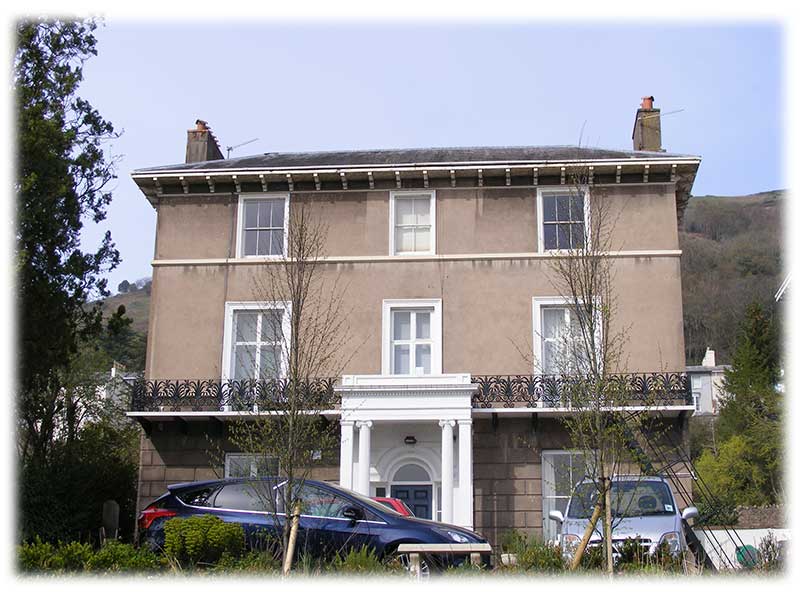
Langland, now Clanmere, 2016
Alice moved across the road to a smaller property, which
she renamed Langland after her old school, and became a prominent town
councillor.
Click to read
the biography of Alice Kate Farmer.
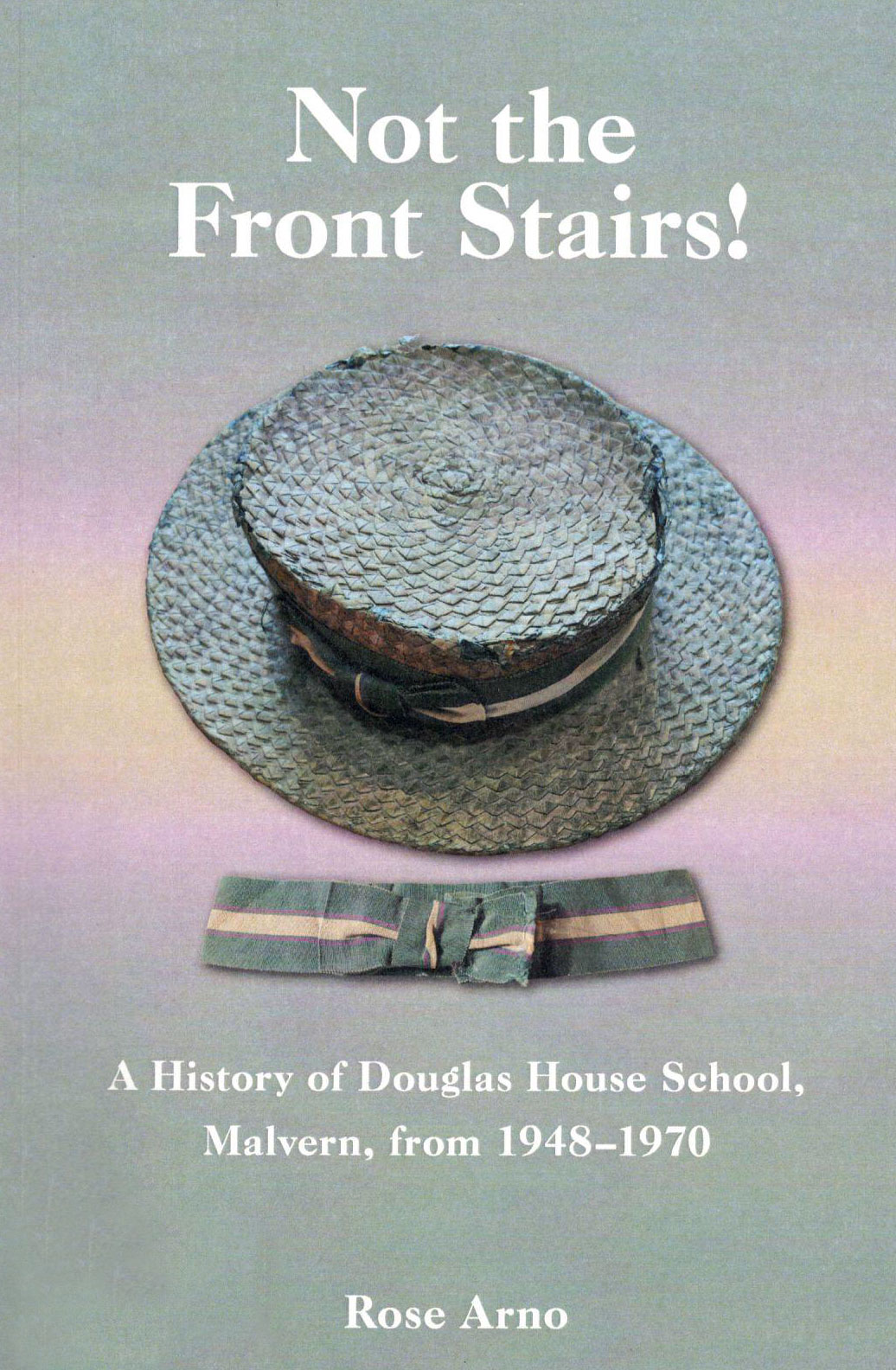 Douglas House School opened in 1948 in the Old Vicarage,
which later became the Osborne Hotel. The Principal was Mrs Owen-Williams; there were
then 12 pupils. Douglas House School opened in 1948 in the Old Vicarage,
which later became the Osborne Hotel. The Principal was Mrs Owen-Williams; there were
then 12 pupils.
By 1950 numbers had grown to 37 and the school moved to
'Prior's Mount' in Priory Road, an imposing Victorian residence, which
during WWII had been a mess for officers of HMS Duke.
By
1953, with 80 pupils, the school was recognised by the Ministry of Education,
and in 1959 it became a Public School under the Chairmanship of Lady Lechmere.
In 1960 the former Dalvington Hotel in Priory Road was purchased to cater for 36
boarders.
The above information was sourced by Malvern Museum (ref
11) from an article by Mrs Owen-Williams in the 1960 school magazine and
since then Rose Arno has published a book about Douglas House titled
Not the Front Stairs! where you can read much more about the school
(ref 56); see front cover opposite.
We could not find a house named Dalvington in Priory Road
but, if it still exists, it may be the property now known as Dalvey
House.
In 1911 Dalvington was a lodging house; one of the people
in residence there was Henry Hamilton Dwyer, a
medical practitioner, born Dublin about 1857.
'Prior's Mount', 35 Priory Road, lay just below St Edmunds Hall, having a similar facade to Tibbington
House.
Visiting in 1905 was
Rev
Arthur Durrant who was vicar of Leverstock Green, Hemel Hempstead.
After WWII Prior's Mount was occupied by Douglas House
School, which was a day school for girls aged between 10 and 18 years.
Douglas House closed in 1970 and was acquired by
Malvern College under whose ownership Prior's Mount was demolished in order
to build the Lindsay Arts Centre, named after former headmaster (1953-1971)
Donald Dunrod Lindsay CBE, who was chairman of the Headmasters' Conference
in 1968.
Below is a photo of 'Prior's Mount' taken in the 1940s, a magnificent house set in large grounds,
somewhat similar in style to Priory
Park Mansion.
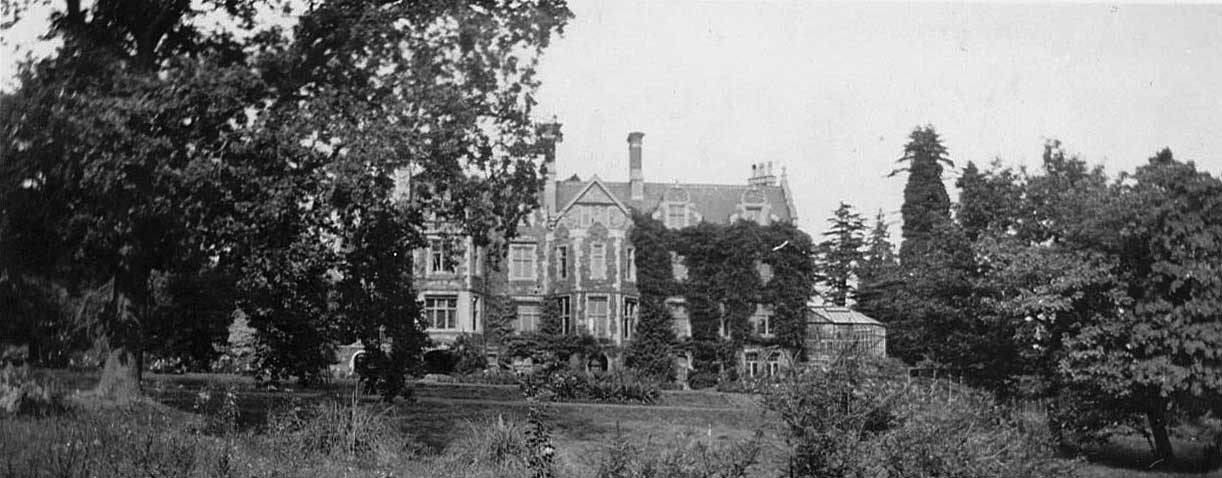
Prior's Mount about 1944 source: Anne Pitman
Evendine
Court, was a finishing school for
St James and later a
cookery school, before closure in 1999. It had opened as a 'School of
Household Training' about 1902 and is now a family home.
Fairseat was a small preparatory school
for boys and girls in Avenue Road run by the Robertson family. The advertisement
for the school shown below is thought to
date from the 1960s (source: ref 21).
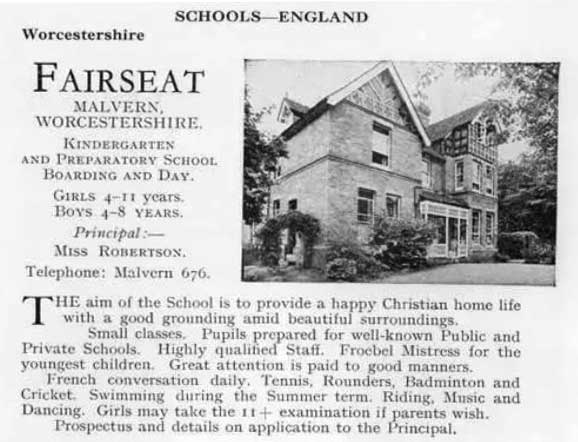
A former pupil relates:
Fairseat Preparatory School in Avenue Road was in
existence until 1987. I was a pupil until 1985. Up until the year before I
left it had been run by the wonderful Miss Robertson, who had opened the
school with her mother, I think in the 1920s. For a while it also took
boarders. It was a very small school, a great place to learn and be happy
pre-National Curriculum. Most of our text books dated from the 1950s, but we
were none the worse for that! St James and the Abbey took over the school in
1984 thinking it could become a feed for the secondary school - but it was
never the same place after Miss Robertson's retirement (ref 21).
We think the house named Fairseat possibly became a
school just before the Second World War. Trade directories suggest Mrs Agnes
Marian Foster Cooke nee Mackenzie was in residence at Fairseat between 1916
and 1921. Agnes was the widow of barrister-at-law George Isaac Foster Cooke
and their son
George
Albert Cooke (1865 - 1939) became a clergyman and well known academic at
Oxford University.
Next, trade directories of 1924 and 1928 record
Josiah Edward
Paul (1853 - 1928) in residence at Fairseat (telephone 297). He was
educated at Rugby School, had played Rugby Union for England and worked in
Madras as an engineer. He retired to Great Malvern with his second wife
Helen Mary Harries who died in 1930.
Kelly's trade directory of 1940 records Miss Sylvia
Robertson having a kindergarten school at Fairseat. Telephone directories
later record Miss Sylvia M Robertson at Fairseat between 1959 and 1963
(telephone 676). In 1957 there is a Mr Robertson at Fairseat and in 1940 and
1957 a Mrs Robertson; so far we have been unable to identify the origins of
the family. Between 1969 and 1983 the entry in the phone book changes to
Fairseat School (tel 5976) and the change of number may have arisen from the
Great Malvern manual telephone exchange being upgraded to an automatic
exchange.
St James and the Abbey acquired Fairseat School in 1984
but sold it in 1987 due to dwindling numbers.
In 2009 the Malvern Gazette reported that a former
pupil, Stephen Rimmer, who was born and grew up in Malvern, had been
appointed Director General for Crime Reduction and Community Safety in the
Home Office.
Fairseat, 34 Avenue Road (see photo below) still exists.
It seems little changed, but like many
other surplus school buildings, has since been converted into apartments.
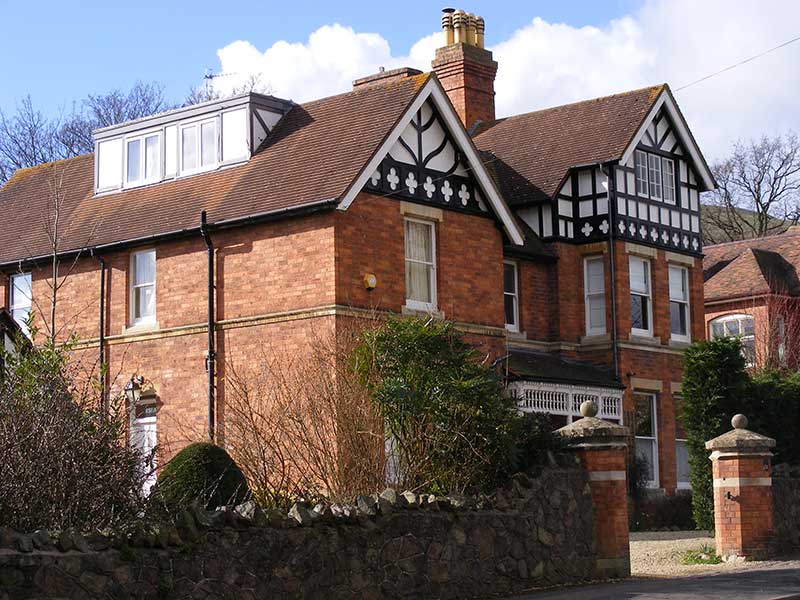
In the 1860s, Hazel Bank at 179 Worcester Road, Malvern
Link, became a school for boys, run by the Rev Allan. It later became a
ladies' school run by Fanny Somerville and her widowed mother Frances. The 1901 census records Hazel Bank as a school for
ladies, run by the Misses Judson - about 1908 they then took their business and the
name Hazel Bank to Malvern Wells where the school prospered as
The Abbey School for girls.
In 1909 the property on the Worcester Road again became a school for boys and the
new owners called it Amestrey; the school left Malvern in 1922. You can read
a lot more about the history of Amestrey on the
Amestrey web site.
William Eric Davis who became Head of BBC Radio
Childrens' Hour was a former pupil; to many listeners he was Uncle
David Davis. In the 1980s our children once listened to him telling
stories at the Lyttleton Rooms. He died in 1996 and his
obituary was published in the Independent newspaper. The family lived at
The Oaks opposite the Buckingham House dental surgery in Graham Road; his
father William Davis once ran a well known fishmongers' shop at the Exchange
building on the corner of Graham Road and Church Street.
Mowbray was a boarding school for
girls in Victoria Road, opposite the present police station. In 1911 it was run by widow Alice L Garner, aged 52
years. The property then had 24 rooms and about 40 female staff and pupils
in residence.
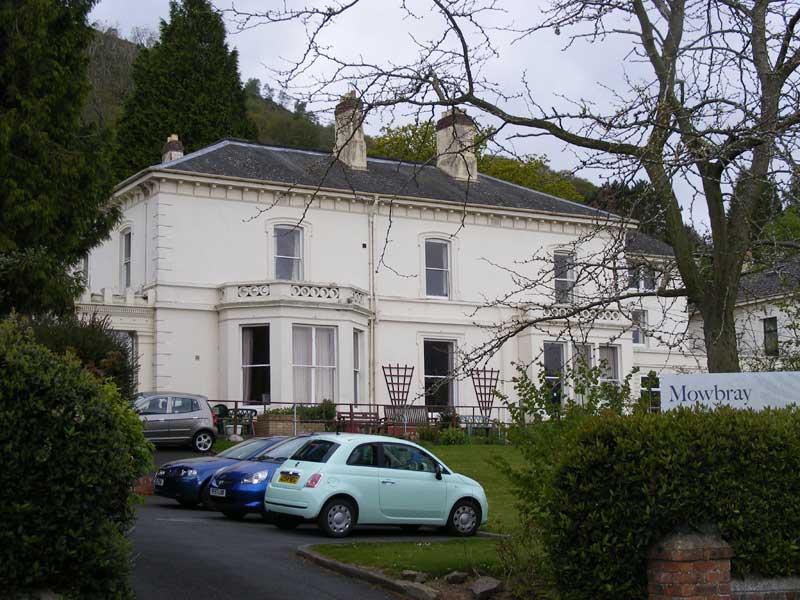
Mowbray in 2017
Later the school acquired Felthorpe next
door which had been a day school for boys (see below).
In 1932 Mrs Dalton was the headmistress. Nowadays Mowbray is a care home.
In a 1912 Trade directory there is mention of:-
High School for Boys, EW Harris, Principal, Victoria Road
Ernest William Harris born Canterbury about 1871 is
listed in the 1911 census as running 'a private day school for young gents'.
The property is recorded as having 12 principal rooms. This was probably the
school also known as Felthorpe, now
a dwelling situated at 5 Victoria Road, Great Malvern, next to Mowbray.
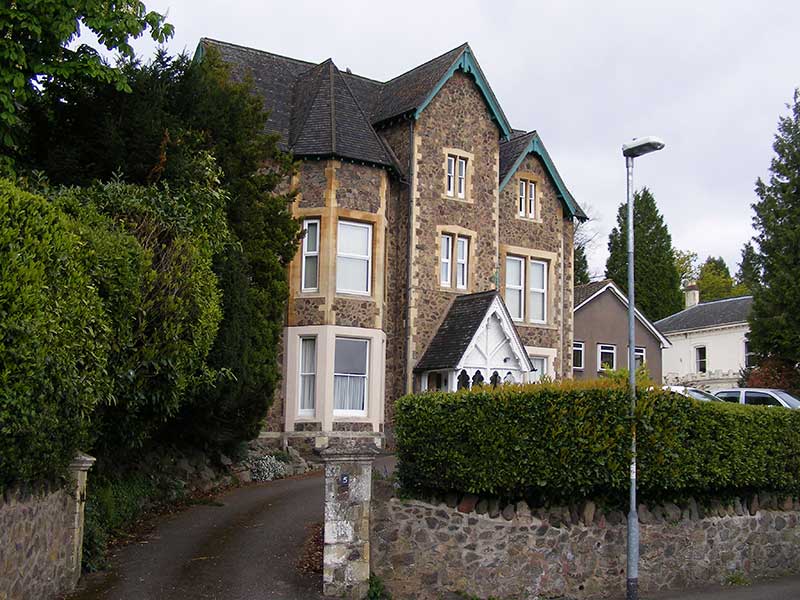
Felthorpe, 5 Victoria Road in 2017
Earlier EW Harris had trained at the Wesleyan Training
College in Horseferry Road, Westminster. It was the first
Wesleyan Methodist training college for teachers which had been founded in
Westminster, London in 1851 eventually moving to Oxford in 1959; you can read more
about that on a web page about
Westminster College Oxford.
 A former pupil was accountant Richard Hartland Woods,
Second Lieutenant, 25th (London Cyclists) Bn attached to 8th Kings Royal
Rifle Corps 41st Brigade, 14th Division BEF, who was killed on 4th December
1917, aged 28 years. He was born in 1889, the son of china and glass dealer
William Richard Woods of Stafford House, Great Malvern. At the time of his
death he was serving as Battalion Signals Officer. A former pupil was accountant Richard Hartland Woods,
Second Lieutenant, 25th (London Cyclists) Bn attached to 8th Kings Royal
Rifle Corps 41st Brigade, 14th Division BEF, who was killed on 4th December
1917, aged 28 years. He was born in 1889, the son of china and glass dealer
William Richard Woods of Stafford House, Great Malvern. At the time of his
death he was serving as Battalion Signals Officer.
Kelly's Trade Directory of 1876 records a Ladies School
at 2 The Birches Malvern Link. It was run by Mrs and Miss Piper who moved
their establishment to The Hollies.
The 1881 census records Mrs Ellen Piper as a
schoolmistress at the Hollies, Albert Park Estate, Newtown Road.
In 1891 The Hollies is described as on the Worcester Road,
and we wondered if either this was the same property or the school had kept its name but moved to a larger house.
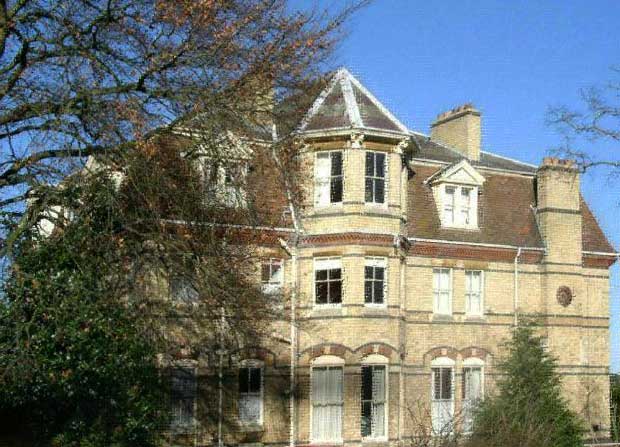
The Hollies, Worcester Road, Malvern Link
The 1911 census records Ellen Jane Piper, born Ledbury
about 1851 as schoolmistress at the Hollies, assisted by three sisters,
Fanny Stella, Isabel Elizabeth and Emma Florence; there are 42 people in the
household.
A
story about the Haggie family records that in 1901 Irene Haggie was a pupil
at 'The Hollies' in Great Malvern, when her family was
living at Link End,
Guarlford. Sadly her brother
George Esmond Haggie was killed in action in Flanders at the age of 27
years on 2 October 1917.
Other pupils at the Hollies circa 1900 included
Violet and Winifred Richards. Their brother bank clerk Charles Ainslie
Richards attended Malvern Link prep school a little further down the
Worcester Road; later Malvern College, and the University of Birmingham.
Sadly Charles was another casualty of the Great War.
Private Charles Ainslie Richards, born Hong Kong in 1890,
died of wounds at the 3rd Battle of Ypres on 2nd June 1916. He was said to
have died nobly at Sanctuary Wood sticking to his post despite heavy odds.
Thomas Essex appears to have started the first prep school in Malvern
Wells, at May Place, about 1863. Victorian explorer
Theodore Bent is though to have been one of the pupils.
'New section in preparation'
Wells House, in Holywell Road, Malvern Wells, was built
as a Coaching House about 1748, later becoming a small hotel for visitors coming to Malvern for the water cure.
Trade was probably increased by the railways coming to Malvern about 1860
with GWR line going on to Hereford and another line to Evesham via Malvern
Wells and Tewkesbury.
About 1870, Wells House became a relatively large private preparatory school for boys, run by 'well
connected' headmasters.
Littlebury's Trade Directory records Rev William
Wilberforce Gedge having an academy at the 'Old Well House' in 1873; and the records of Cambridge
Alumni indicate that he was
the headmaster between 1870 and 1889.
Rev Gedge had started his first school named Stamford
House in Cheltenham in the 1860s, before moving to Malvern Wells
Carleton Tarr relates (ref 43):
William Wilberforce Gedge was born in Ructon, East
Anglia in about 1830 and went to St Edward's School Birmingham where he
was a senior master at the age of 16 (more likely a head prefect as we would
say today). He went to Cambridge University and eventually took Holy Orders.
He was ordained in 1859 at Worcester Cathedral and married a lady from Aston
Cantlow in Warwickshire.
The Gedge Family lived in Hanley Swan and on a Sunday
there were Sunday School classes. Rev WW Gedge was headmaster until at least
1881, at which time, he returned to East Anglia as a Clergyman of a Parish.
We know that one of his daughters was married in Upton upon Severn Parish
Church and some other members of this family are buried in Green Lane
Cemetery at Malvern Wells. Rev William Wilberforce Gedge died in the early
years of the 1900's and is buried in Cheltenham Cemetery near the General
Hospital. An interesting footnote is that a relative of the same surname was
Augustus Wesley Gedge who ran an Apothecary shop called the 'Galen
Pharmacy' at the end of Hampden Road in Malvern Link.
The next headmaster was Alfred Henry Stable (ref 31), born
Wanstead Essex, about 1859, who was the son of a Land Agent. In 1891
Alfred married Ada Louise Huntington who was born in Italy; she was the
eldest daughter of Rev Henry John Huntington (1820 - 1887), died at Malaga, whose sons were
educated at Malvern College. Ada's eldest brother Rev Henry Edward Huntington
(1861 - 1893) became a master at Malvern College and married Francis Ellen
Gedge the daughter of the first headmaster at Wells House - sadly their
eldest son,
Ada's nephew,
Ernest Henry Huntington, (1890 - 1916), was a casualty of the
Great War; he is recorded in De Ruvigny's Roll of Honour thus:
Huntington, Ernest Henry, Private No 516, 25th Infantry
Battalion, Australian Infantry Force, elder son of the late Rev H E
Huntington of Malvern College, by his wife, Frances Ellen (now wife of Henry
Kempson, of Fosmo, Malvern), daughter of the Rev W W Gedge; born Great
Malvern, county Worcester, 2nd August 1890; educated Stancliffe Hall, and
Repton; went to Australia in January 1912; joined the Australian Infantry in
January 1915; served in Gallipoli and Egypt till March 1916; then went to
France, and died of illness contracted on active service near Armentieres,
25th April 1916. Buried in Erquingham cemetery; unmarried.
Ernest's Australian Service Record reveals that he
enlisted at Roma, in Queensland on 7th January 1915, using the name George
Stapleton, and that he died of meningitis. In his will he left all his
property and personal effects to his mother Mrs Kempson of Eastry, Malvern.
Ernest is remembered on the Rolls of the Fallen at Great Malvern library and
at Great Malvern Priory.
Alfred and Ada Stable were at Wells House until about
1902; sadly Alfred died at Swanage in 1907, at the early age of 47 years.
Their eldest son, Geoffrey Scott Huntington, (1891 - 1966) became a merchant
seaman. He was Master of the merchant ship Lahore which was sunk by a German
U boat in March 1941. Later he became a Commodore of the P&O line; his last
ship was the passenger liner Canton (ref 31).
About 1902, widower Ernest Prescott Frederick, MA
Cambridge, became headmaster at Wells House, until his death in 1929. He was
the son of George Septimus Frederick, who had been an accountant at HM
Treasury, and was related to the Frederick family of Baronets. Frederick had
been a Scottish Mathematician of some repute at
Loretto School
Musselburgh near Edinburgh.
George Chesterton, Malvern Civic Society, was a pupil at
the School in 1928 under headmaster Ernest Prescott Frederick who was
responsible for planning the Holywell Tin Chapel on the path to The Wyche
Cutting behind the School building and adjacent to the 'Cottage in the Wood'
a former Dower House.
About 1933, Alan Francis Darvall (1903 - 1983), MA
Canterbury, became the headmaster. Alan Darvall was educated at
Dover College,
and had also taught at Loretto School. He was listed in the telephone directory
at Wells House until 1960.
He is said to have retired in 1968 and is buried Kenn
churchyard near Exeter. His brother
Frank Ongley Darvall (1906 - 1987) became a politician and diplomat.
Their elder brother Air Vice Marshall Sir
Lawrence Darvall (KCB, CB, MC)
had a distinguished career in the RAF; he was born on 24 November 1898, the
second son of Richard Thomas Darvall of
Gordon Lodge, Reading. Lawrence Darvall was educated at Marlborough
House, Reading, Dover College, and the Royal Military College at Sandhurst.
After service in the Army he transferred to the Royal Air Force in 1921.
After various appointments he assumed
command of the Joint Services Staff College 1951 - 1953 and at the end of his
career became Commandant of the NATO Defense College in Paris
1953 - 1955. He retired in 1958 and died on 17 November 1968. In 1923 he had
married Aileen Mary Mahoney, daughter of an Irish JP.
One of the former pupils at Wells House was John Sims (1898 - 1914), the son of
painter Charles Sims and grandson of the Scottish landscape painter
John
MacWhirter.
The school is said to have eventually occupied Wells
House, Rock House, The Manse, May Place, and a building known as the
Centenary Building, commemorating one hundred years, which had classrooms
and a science laboratory upstairs; underneath was a gymnasium also used for
concerts and plays.
The staff at The Wells House lived in different parts of
the main building and looked after boys billeted out in former lodging
houses. Girls were admitted in 1974.
The Wells House school was located near the Holy Well spring and the composer
Edward Elgar, who lived nearby, taught there. The school closed at Christmas 1991.
Wells House School Roll of the Fallen
We think the Roll of the Fallen now in Malvern Wells
cemetery chapel was moved there after the school closed.
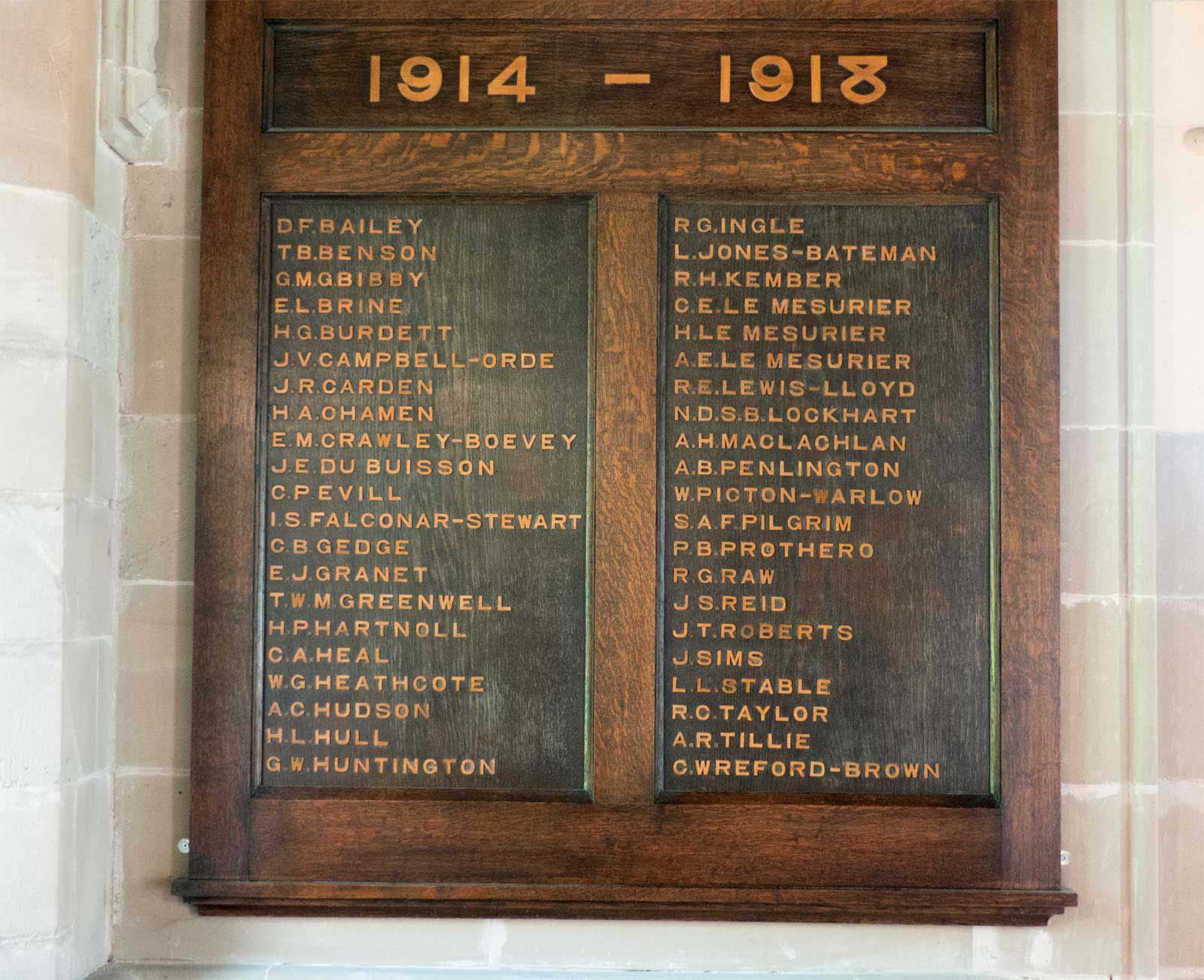
Wells House - Roll of the Fallen
More information about these men can be found on our page about
Malvern Wells Municipal cemetery (tour 2).
Cambridge House was a small school for young ladies, in
Malvern Wells founded about 1871. The school was started by Mary Frances
Fletcher assisted by her sisters. A partner in the early years was Louise D
W Wagner. The school continued to be run by the Miss Fletchers until 1904
and the names of some of the former pupils can be found in the 1871, 1881, 1891 and
1901 census.
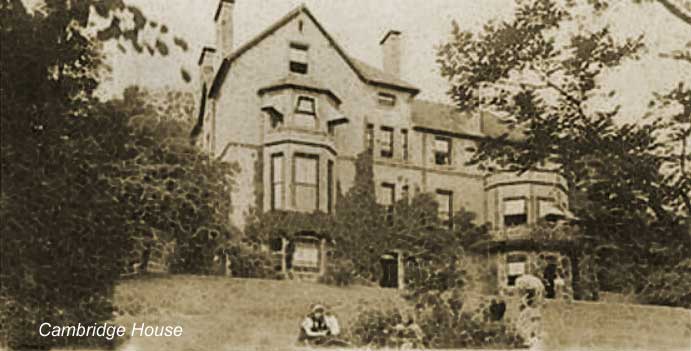
Cambridge House - photographer unknown
Louise D W Wagner appears only in the 1871 census, and we
have not been able to trace her birth or what subsequently became of her.
We imagine Louise may have felt outnumbered by the Fletcher sisters and
moved on to pastures new.
The 1871 census and Kelly's Trade Directory of 1876
record Miss Mary Frances Fletcher as the Principal of a Ladies Boarding
School at Cambridge House, Malvern Wells in the parish of Hanley Castle. She
was born London about 1839. The 1881 census records the boarding school next
to Rose Lawn when Mary is assisted by her three sisters Jessie Macnaughton, Josephine,
and Alice Jean Adams. Their mother Jane was living with them at Cambridge
House in 1871; possibly she was the Jean Fletcher whose death was registered
in the district of Upton Upon Severn in 1878.
In 1901 local girl Ada Elizabeth George was employed
as a
housemaid at the school. In 1912 she married domestic groom
Henry Norman of
Rodmell in Sussex, who sadly was later to perish in the Great War. Henry
Norman's name is one of many on the Roll of the Fallen at Great Malvern
library.
Cambridge House continued to be listed in trade
directories until 1904, when the Fletcher sisters retired to live in Bexhill
on Sea. Mary Frances Fletcher died at Bexhill in 1912. We now think
Cambridge House was then acquired by The
Abbey School to form the Junior Department and was possibly renamed
Hazel Bank.
Family
We have discovered that the sisters came from a notable family. Their paternal
grandfather Rev Joseph Fletcher (1784- 1843) had been an eminent Minister of the
Congregational Church, a theological writer, who was awarded the title Doctor of Divinity by
Glasgow University, and is listed in the Oxford Dictionary of National
Biography where you can read more about him.
The sisters' father was Joseph's eldest son Robert (1809
- 1892), born
Blackburn, who
practised as a solicitor in London. Their Aunt Elizabeth (1818 - 1870)
married Frederick Green of a 'shipping' family, and they were the parents of
the sisters' cousin Sir Frederick Green (1845 - 1927) whose death was
reported thus in The Argus Newspaper (Melbourne) on Tuesday 22nd February
1927:
SIR FREDERICK GREEN. One of Orient Line Founders. Sir
Frederick Green as whose death in England was announced in a cable message
yesterday was a partner of F Green and Company who with Anderson, Anderson
and Company formed the firm of Anderson, Green and Company, the founders of
the Orient line of steamers.
Sir Frederick Green came of a stock famous in the ship
building world for many years being in the direct line of the Green family
who built and sailed the Blackwall clippers from the 17th century.
A man of wide interests he was a leading figure in
sporting circles and was particularly interested in hunting and cricket in
his native county of Essex. When county cricket fell on bad times it was
through the efforts both moral and financial of Sir Frederick Green and his
brother Mr G E Green that the sport was maintained in Essex and in hunting
he was equally keen riding with the hounds until a few years ago when aged
nearly 80 years.
The connection of the Green family with the Orient Line
business was severed in 1919 when Sir Frederick Green retired from the firm.
In addition to his identification with the shipping business, Sir Frederick
Green was interested in other industrial concerns, and was a director of the
Suez Canal Company, the Bank of New South Wales and the Australian
Mercantile Land and Finance Co Ltd. He was a member of the council of the
King Edward Hospital Fund and was for some time High Sheriff of Essex. He
married an Australian woman, a daughter of Sir Daniel Cooper, of Sydney and
had four sons and three daughters. Sir Frederick Green was in his 82nd year.
The sisters uncle William Wolf Fletcher (1813 - 1880)
became an accountant in London, but it was perhaps their uncle Rev Joseph
Fletcher Junior (1816 - 1876) who may have had some influence on their
careers. Rev Joseph Fletcher Junior is listed in the Oxford Dictionary of
National Biography, like his father. He also became a Minister of the
Congregational Church and published a book about his father - 'Memoirs of
life and Correspondence of
the late Rev Joseph Fletcher DD' in 1846.
Rev Joseph Fletcher Junior founded a small prep school
for boys at Christchurch near Bournemouth on the south coast; the names of
some former pupils can be found in the 1861 and 1871 census.
Very sadly, tragedy struck the school in May 1868, when
seven pupils were drowned while bathing at Mudeford, as the result of a
freak wave. The accident was reported in local and national newspapers. The Times
reported thus on Saturday May 23rd
1868:
MELANCHOLY ACCIDENT
On Wednesday afternoon seven
boys, pupils of the Rev Joseph Fletcher, of Christchurch, were drowned while
bathing.
It appears that Mr Frederick Geyer, the German tutor in the
establishment kept by Mr Fletcher, went with eight boys, none of whom could
swim, to bathe off the beach at Mudeford. While they were in the water, most
of them as far from the shore as they could wade, a huge wave lifted them
off their feet.
Mr Geyer who was swimming at the time, looked round, and saw
Henry Atlee Pewtress, the eldest boy, with his hands thrown out of the
water. He went to his assistance, and endeavoured to save him, but was
unable to do so, as he clung to his arms and dragged him down under the
surface. The tutor, however, escaped from his grasp, rose again, and got to
the shore.
All the boys were drowned except Joseph Newsome Milne, of
Christchurch, who had not waded in so far as the others. He saw the wave
coming and was also taken for a time off his feet, but when the water
retreated he was able to walk to the shore.
He heard one of his companions
call for help, and saw others struggling in the water and throwing up their
hands. The bodies were all washed ashore the same day.
An inquest was held
on them on Thursday, when the jury returned a verdict of 'Accidentally
Drowned'.
The following are the names of the deceased:- Henry Atlee
Pewtress, before mentioned aged 15, and his brother, Arthur Howard Pewtress,
aged 11, whose parents live in London; Leonard Moser, aged 13, and
Horace
Moser, aged 12, sons of Mr Frederick Moser, of Carberry, Bournemouth;
George
Frederick Johnson, aged 13 of Croydon; James Atlee Hunt, aged 13, son of Mr
Hunt, Southampton, late manager of the English Joint Stock bank,
Christchurch; and William Robert Smith, son of Mr Smith, of the firm Smith,
Plumstead, and Trippe, Southampton.
Five months later a boating accident, caused by rough
weather, was reported in The
Salisbury and Winchester Journal and General Advertiser on Saturday 10th
October 1868:
Christchurch Boat Accident
A boat accident occurred at Mudeford on Tuesday afternoon
by which time persons named William French and Joseph Vick lost their lives.
A brother of one of the men who was also in the boat was rescued. On the
following morning an inquest was held before Mr J Druitt, coroner, when John
Vick, brother of Joseph Vick, made the following statement.
Yesterday, in company with my brother and William French,
we launched from the Christchurch Head and were coming in about half past
two. Nothing happened previously which related to the accident. We were
coming over the bar, a foul sea struck the boat, filled her, and she went
head first under the water, and did not right again. There was no-one near
at the time.
I was saved by Lord Bury and one of the coastguard named
Pride. I was sensible. I was picked up by them. Joseph Vick held up till
within ten minutes of the boat coming. I believe French was frightened at
the time of the upset, as he held his head down and did not move afterwards.
He was naturally timid. The sea was very heavy. I was in the sea for twenty
minutes or half an hour. The boat was a good one, new, of fifteen feet in
length.
The boat did not touch the bar. The sea was running ten
feet high, and she was swamped with the wave. French was forward. The boat
was loaded with shrimp pots. We had conversation while in the water. Joseph
Vick said, "Goodbye, John, I can't hold up any longer."
Lord Bury was next examined, and he stated that Pride,
the coastguards' man, and himself, seeing the condition of the men, launched
a boat and rowed for about three quarters of a mile, when they succeeded in
saving John Vick. This statement was corroborated by Charles Pride. The jury
returned a verdict of 'Accidental Death' and through their foreman, Mr N S
Newlyn, expressed their deep sense of the bravery of Lord Bury and the
coastguards' man.
These stories are a reminder to respect the power of the
sea, and not to ignore its potential danger.
Let us return now to past schools in Malvern Wells.
Kelly's Trade Directory of 1876 listed a Ladies Boarding
School run by Miss Martha Smith at The Manse, 183 Malvern Wells. In 1880
this was described as a First Class Ladies' Boarding School.
The Manse was a large house and there is a photo of it in
Keith Smith's book Around Malvern (ref 26). He records that prior to 1914
the house had been used as a ladies' school, and is now flats.
The 1881 census recorded that the school was next to
Thorn Bank, mentioned above, and that Miss Martha Smith was born Stanton
Lacy Shropshire about 1815. She was assisted by her niece Jane Elizabeth
Smith born Hopton Castle, Shropshire about 1847, who took over the school
when Martha retired.
The 1911 census recorded that The Manse had 20 rooms.
Then in
residence were Jane Elizabeth Smith, principal; Mary Annette Leake, niece; 4
governesses, Agnes Mary Rosina Lee, Ellen Marie Rive (French), Harriet
Groves Rowland and Clara Griesback (German); 10 pupils aged between 15 and
18 years; a parlour-maid, 2 house-maids, a cook and a kitchen maid.
It was most probably a 'finishing' school.
Kelly's Trade Directory of 1912 lists Smith J E ladies'
private school, Whitbourne Lodge (see advertisement). Page 28 of the
advertisements at the back of the directory contains her advert giving more
information.
Whitbourne Lodge
Malvern
First Class Home School for the Daughters of Gentlemen
Miss J E Smith
(Late of the Manse, Malvern Wells)
Assisted by Experienced English and Foreign Governesses
and well-known visiting masters.
Receives a limited number of resident pupils, preferably
over 14 years of age. Colonial pupils taken. Riding, golf, swimming, tennis
and gardening. Quite close to Station and Golf Links.
Prospectus upon application
Schoolmistress Jane Elizabeth Smith of Whitbourne
Lodge, Manby Road, Great Malvern, died on 27th May 1917; her niece Mary Annette Leake
was an executor.
Trade directories tell us that
artists Albert and Mary Stevens
retired to Malvern about 1924 where they set up a studio at The Manse in
Malvern Wells.
Kelly's Trade Directory of 1936 records St Mary's
Ursuline Convent School (Rev Mother Superior), at Stuart Lodge on the Wells
Road at Malvern Wells. The house was originally numbered 273, but now has
its access from Kings Road where it is numbered 11.
We have found no other reference to the school, so
perhaps it was only there for a short time. Possibly its function was
superceded by
St Mary's
Convent a boarding and day school for girls which was in a large mansion at
Mount Battenhall in Worcester. The
house was built about 1860 and had been used as a convalescent hospital
during WWI. St Mary's Convent School opened in 1934 and closed due to
financial difficulties in 2014. It was the last independent all girls' school
in Worcester.
We think Stuart Lodge was purchase by The Abbey School
when it became the French House.
Kelly's Trade Directory of 1940 lists St Hugh's School,
Malvern Wells, Raymond Tootell MA head master. Later the school moved to
Carswell Manor, Faringdon. Raymond born 1893 died at Bournemouth in 1957. In
1911 he had been assistant master of Surrey House School in Margate at which
his father Percy was the headmaster.
Kelly's Trade Directory of 1940 lists Cleeve Court, a
boys' preparatory school, Malvern Wells; Reginald John Halcomb MA, principal.
Reginald John Halcomb was born Sheffield 1900, the son of a steel
manufacturer, and died at Malvern in 1983.
An advertisement for the school of 1946 reads:
Cleeve Court
Malvern Wells, Worcestershire
Inspected and recognised by the Ministry of Education
Headmaster R J Halcomb MA MRST
The syllabus incorporates subjects and activities
conducive to a life of appreciative understanding in conjunction with
academic efficiency.
The development of sound character and health is
considered of major importance: without these the real happiness which small
boys are entitled to enjoy is impossible.
Illustrated prospectus and references on application.
Phone: Malvern 837
Tom Hawthornwaite remembers that Cleeve Court was at the
top of the Hanley straight, on the right, just before the bend.
We think this was the property acquired by
The Abbey School to create a prep
department.
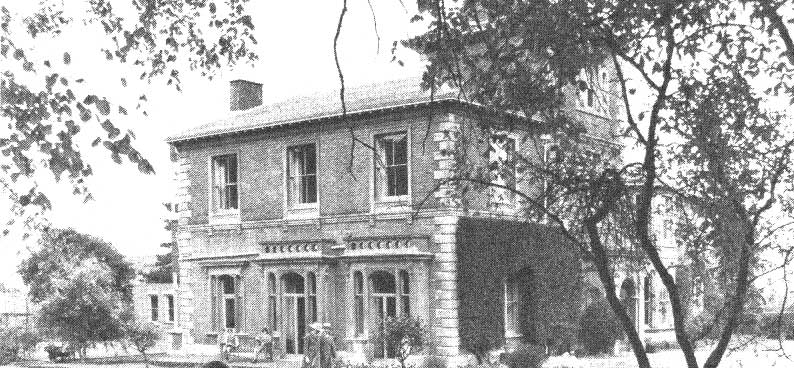
After 'The Abbey' prep department moved to Heathlands in
1978 the property became a hostel then a nursing home. It is now a
specialist psychiatric rehabilitation and recovery unit for men aged 18
years or older run by Priory Healthcare and named Abbey House.
Kelly's Trade Directories of 1936 and 1940 list the Queen
Anne preparatory school for girls (Miss Dorothy Burgess NFU LLA MRST
principal), Pickersleigh Road, Malvern.
The initials are quite interesting. In this case NFU does
not stand for National Farmers Union, but a member of the
National Froebel Union which espoused the ideas of the German
educator Friedrich Froebel who invented the concept of the Kindergarten. LLA stands for
Lady Literate in Arts. Such ladies were educated at more than one
academy and took an exam at an approved centre such as the University of St
Andrews; the scheme was discontinued in the 1930s. MRST stands for Member of
the Royal Society of Teachers, which was a national scheme for registering
teachers from 1914 to 1948.
Earlier her entry in the Kelly's Trade Directories of 1928 and
1930 read:
Dorothy M Burgess NFU LLA preparatory school,
Springville, Albert Park Road, Malvern Link.
St Richard's Roman Catholic preparatory school for boys
in Malvern was founded in 1921 by John Richard Keble, an Oxford MA and
published poet, and his wife Audrey Light, the daughter of a clergyman, whom
John married in 1920.
John Richard Keble was descended from a line of
clergymen, and his great grandfather was the brother of high churchman
John
Keble (1792 - 1866) who founded the
Oxford Movement and after whom
Keble College, Oxford is named.
St Richard's School opened at Aucott House, 54 Worcester
Road, Malvern (see photo below) with six boys, and moved after ten years to the
'Old Presbytery' next to St Wulstan's Roman Catholic church, Little Malvern.

Aucott House, where St Richard's started
John Boocock who was a pupil at St Richard's, Little
Malvern, between 1944 and 1950 sent us some photos and reminiscences which we will
pass on to Malvern Museum.
John relates:
The church was built in 1862 by the monks of Downside Abbey who also built a
large property next to it. This property was supposed to be a retirement
home for elderly and sick monks, but was never used for this purpose. Mr
Keble took it for his school. The next house along the road was the
Presbytery where a monk of Downside Abbey lived. He ran the parish of St
Wulstan and was chaplain to St Richard’s school.
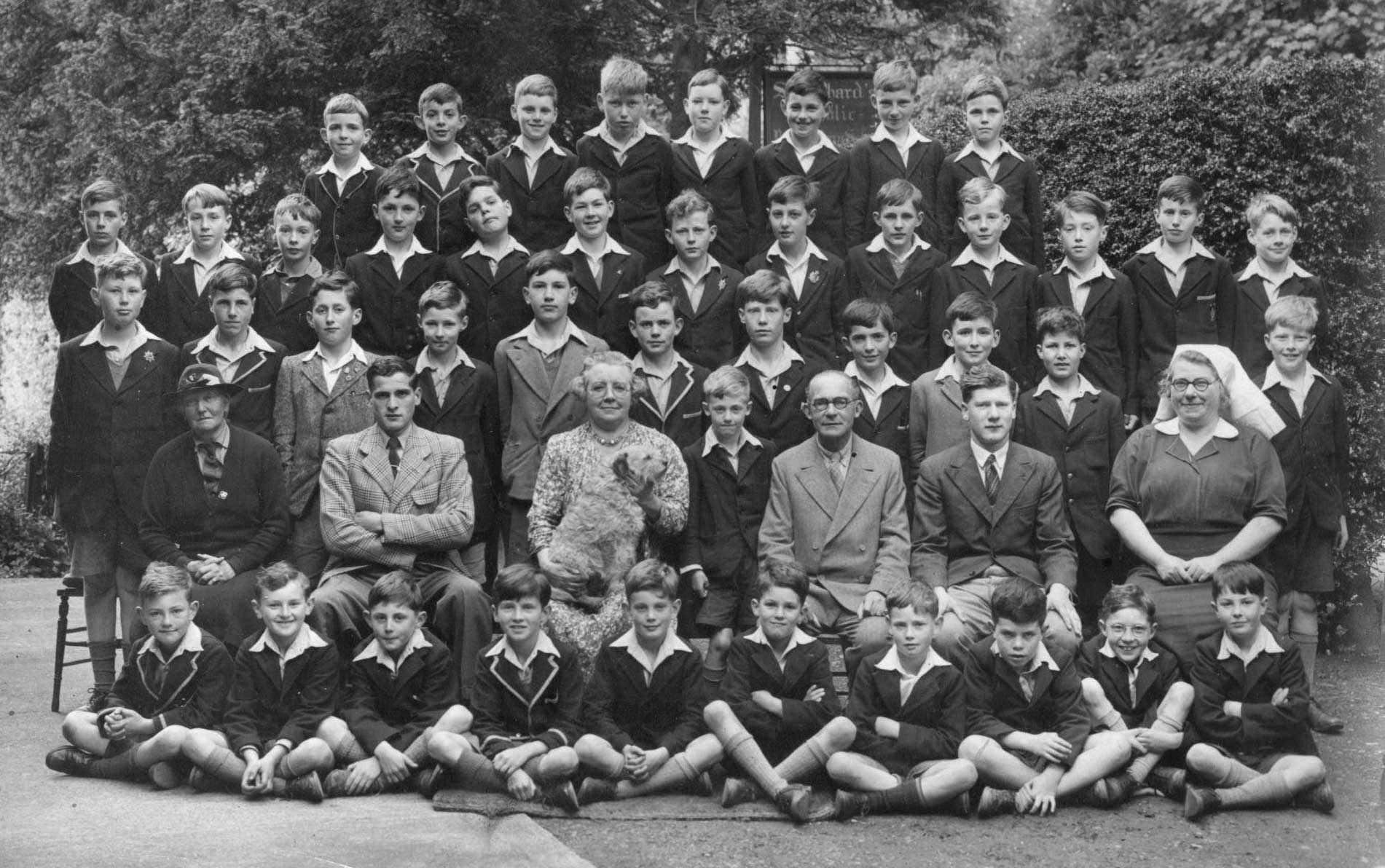
St Richard's Little Malvern July 1945
credit: John Boocock
In the 1945 photo the adults from left to
right are Miss Wylie (1st form); Mr Geoffrey Fairey (3rd form); Mrs Keble
plus dog; then young Michael de Bertodano, standing, a Spanish Marquis; then
Mr Keble (4th form); Mr Pocock (2nd form), and lastly Matron Dyed - a
surname that caused considerable amusement. She was the 'Mother' figure for
all of us. As you can see only 43 of us - so four forms with 10/11 boys to
each class. The picture was taken in July so no school ties.
John Boocock is sitting cross legged in front of Michael
de Bertodano and Mr Keble and to John's right is Noel Harrison the son of Rex
Harrison, the actor, and his second wife Fay Dunnaway.
John goes on to say the 1945 school photo is stamped on
the back Norman May, Malvern, the photographic company his Great Uncle, John William Beaufort,
worked for at the end of the 19th century.
Mr Keble retired in July 1949 and the next Head Master
was Mr Caspar Tremlett.
Mr Tremlett had been a pupil at St Richard’s in the
1930’s, went to the Catholic Public school Douai - a Benedictine Abbey
school at Woolhampton, between Reading and Newbury. Mr Tremlett went on to
Oxford, got a Masters' Degree and was a Major in the Army during WW II.
I well remember Mr Tremlett joining the staff at St
Richard's in September 1948, taking over in September 1949 as Head Master. I
left in July 1950.
The pupils all went on, after taking the Common Entrance
Examination, to various Catholic Public Schools. Most boys went to Douai.
But others to Ampleforth, and Downside (both monastic public schools). A
few of us went to Stonyhurst or Beaumont - Jesuit Public Schools. I went to
Beaumont.
Next to the school was St Wulstan's RC Church and on the
other side of it was the parish hall. This was used by the school for
boxing, shooting and gym.
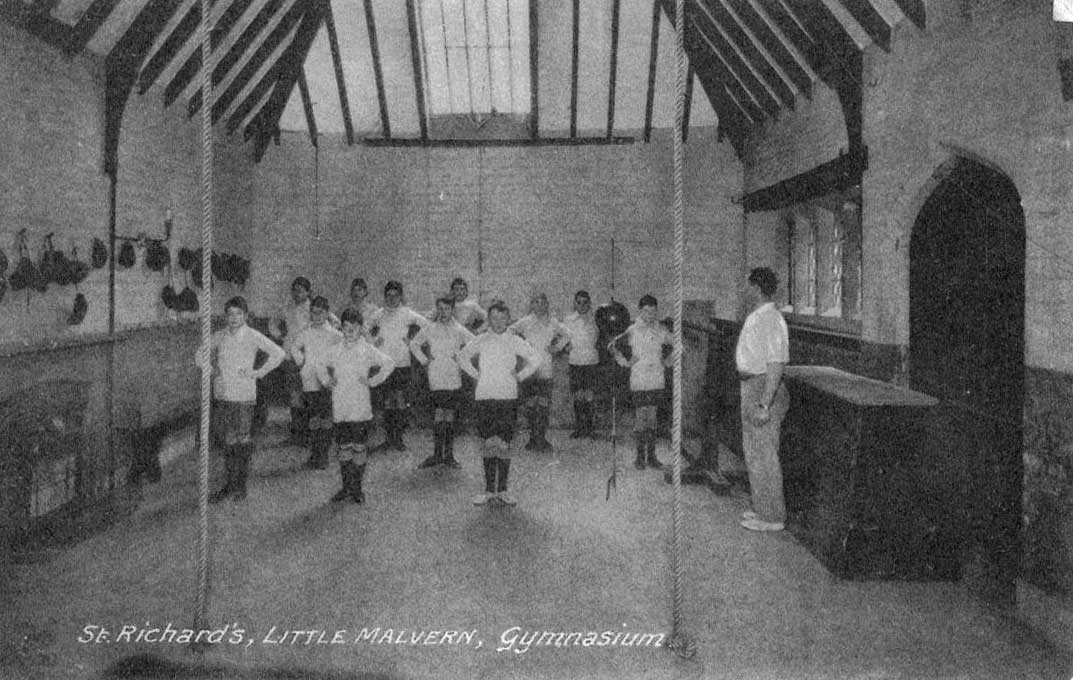
St Richard's Little Malvern, gym, credit: J Boocock
The photo shows boxing gloves on the wall on the left, a
class of 12 boys doing gym, and Mr Hirons to the right. M Hirons had been a
Sargent in WWI. He was by training a coffin maker. But he was a superb
carpenter and taught us carpentry, boxing, shooting and gym. He was an
excellent teacher and taught all those subjects in several of the boys' prep
schools on the Malvern Hills.
Parents' day in the summer term was for prize giving, a
speech by the Head of one of the Public Schools to which the boys aspired,
and gym performance; this involved most of the school using parallel bars, a
jumping horse and other equipment.
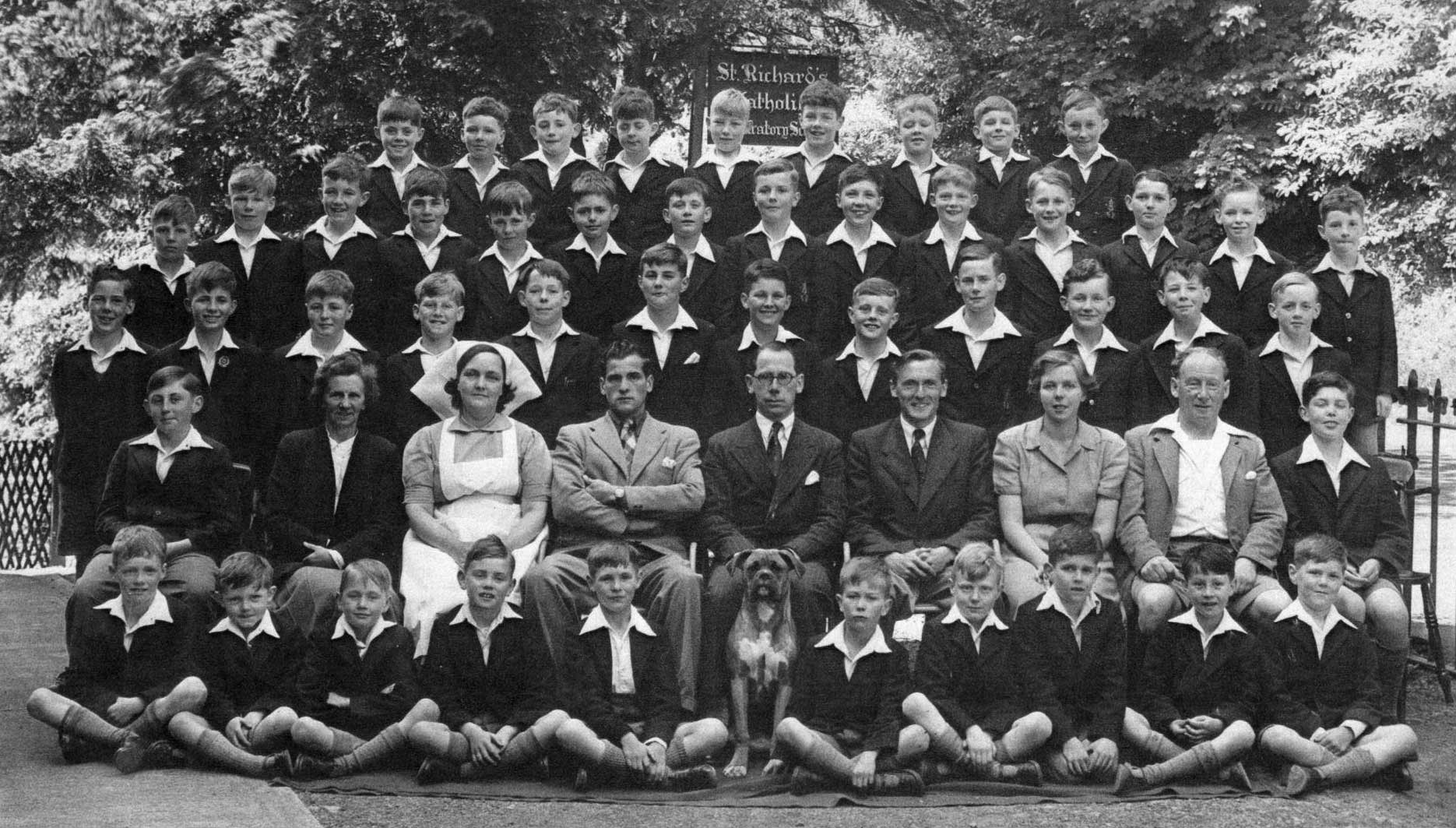
St Richard's Little Malvern July 1950
credit: John Boocock
The adult row in the school photo from 1950, from the
left shows Anthony Ely (went to Ampleforth College), Miss Hodges (1st form), Matron, then Mr Geoffrey Fairey (3rd form), Mr Caspar Tremlett (Head
Master and 4th form), Mr Philip Last (he came in September 1949, had been
training for the Catholic Priesthood in Rome. He retired to New Milton and
I renewed the friendship. Then Miss Eve.
Next Mr Hirons (see above). Lastly John Lloyd, who went to Douai Abbey
School. His family lived near me in Reading - he was killed in a car crash
in Bangkok many years ago. I am immediately behind Mr Tremlett in the 1950
photo.
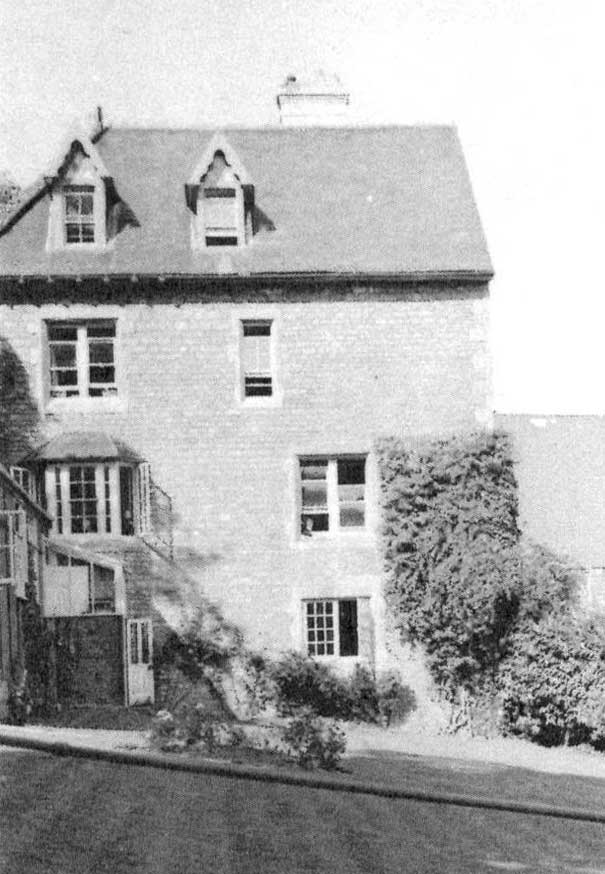 This 1950 photo is looking across the lawn to the west
side of the main school building This 1950 photo is looking across the lawn to the west
side of the main school building
Another view of the school can be found on the St Wulstan's website
In 1951 Caspar Tremlett married Ursula Mary Mortimer.
Other memories of St Richard's
During my time there, a few boys were from well
known families. In my year was Noel Harrison, son of Rex Harrison and Faye
Dunnaway. Fay was a Roman Catholic so Noel was at St Richard's, a Catholic
school. But he went on to Cheltenham College.
A year below me were the grandsons of the inventor of
Bird’s Custard, a wealthy family who often took other boys out for parents'
days.
Also in my class was Michael De Bertodano - a Spanish
Marquis - his God Father was the last king of Spain before the civil war -
Alphonso XIII.
Note: the Beaumont Union Review records that Michael
de Bertodano, Marquis de Moral, anglo spanish aristocrat, died in 2020, so
it would appear he went on from St Richard's to attend
Beaumont College which closed in 1967.
As boys we were fascinated by the number of people who used to visit
a grave in the graveyard of St Wulstan’s - none of us was very musical and
did not appreciate that the grave in question was that of Sir Edward Elgar. As a side note,
one of the boys in my class, Richard Bird (the grandson of the Bird’s
Custard man) and I, in the summer of 1950 built a tree house in a tree by
the wall round the cemetery. We needed a support for the floor of our tree
house and just below us was a convenient headstone. So cutting a V into the
end of a log we wedged it on top of the headstone and it excellently
propped up the floor of our tree house. We only learned later that it was
Elgar’s headstone. We had many people looking at our tree house - strangely.
We did not know why!
Apart from studies I remember the 1945 General Election,
one boy, Kernot, had all the posters for the Labour Party.
The winter of 1947 was awful. It started snowing on 18th
February and remained freezing throughout February and March and it all
melted in April. On the Malverns we had perhaps a couple of feet of snow. A
boy who attended daily from Colbury had food delivered by helicopter to his
village.
The snow in Wales was a lot more and it all thawed in 10
days flat. The distance from Little Malvern to Bredon Hill is about 16
miles. The River Severn was at one point 7 miles wide. The school was 500
feet up - you could see the floods of the Severn from the school window.
Move to Bredenbury Court
About 1969 Mr Tremlett moved the school to a
mansion known as Bredenbury Court near Bromyard -
not so far away to the north. There the school for 3 to 13 year olds flourished, became
co-educational, and prospered.
In 1944, during WWII, Bredenbury Court had become a prep
school for girls feeding Cheltenham Ladies' College.
Click for a history of Bredenbury Court
Caspar Tremlett retired, aged 65, in 1982 and Richard
Coughlan, a retired army officer took over as Headmaster; under his headship
the school became a charitable trust in 2004. In 2005 Nathan Cheesman became
Headmaster.
About 2013 the school got into financial difficulty and
eventually the school closed on 31st July 2016 after the then headmaster,
Frederick de Falbe, was
appointed headmaster at
Beeston Hall in
Norfolk. Many of the pupils transferred from St Richard's to
The Down's
School in Colwall.
Guy Fairey was a master at
the school for more than 30 years until it closed; his uncle, Mr Geoffrey Fairey
had been one of the masters when I was there in the
1940’s.
Bredenbury Court was a magnificent place and photos
can currently be found
here.
Trade directories record a ladies' private boarding
school, at a house named Lindfield in Avenue Road, between 1900 and 1912.
This was run by three sisters, Rosa Caroline, Clara Jane and Marian Lottie
Graham. The 1911 census records that the house had 22 rooms and about 30
pupils aged between 10 and 18 years. Their mother Caroline aged 80 years was
also in residence.
The 1891 census the records the sisters had earlier run a
smaller girls' school in Hornyold Road.
Clarendon girls' school in Cowleigh Road, North Malvern,
was founded by Miss Amy Flint about 1898 with help from her younger sisters Annie and
Mary.
Amy Flint retired in 1930 when the school had 46 pupils;
the school continued to grow in numbers under subsequent owners, occupying
more houses, until 1948 when the school left Malvern for larger premises in
North Wales (ref 29).
The census recorded at the school in 1901: Amy Flint,
aged 31, Principal, Annie Flint, aged 25, governess, Mary Flint, aged 24,
governess (music), Ruth Petter, aged 19, pupil governess, Ellen D Fletcher,
aged 16, pupil governess, Mary B Prosser, aged 16, pupil governess, plus 21
pupils aged between 10 and 16 years, a cook, housemaid and under housemaid.
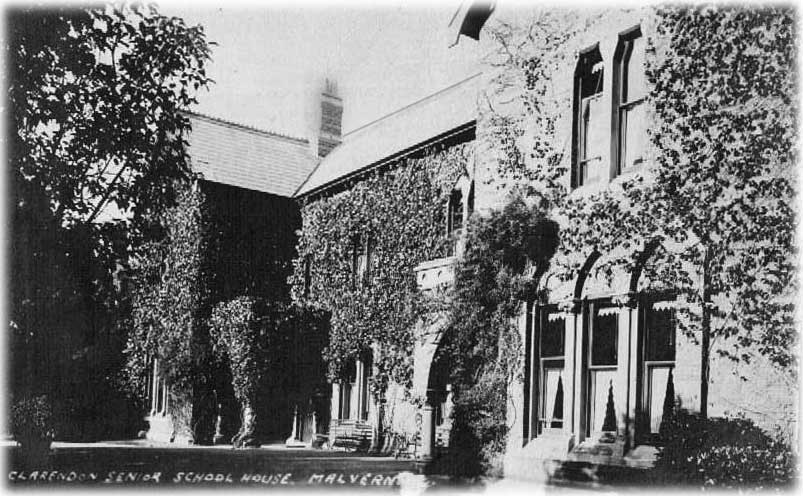
Clarendon Senior School House (photographer unknown)
By 1911, Amy's sister Annie Flint had become Assistant
Principal but Mary was still a music governess. In addition there was an
English governess, a German born German governess, plus 24 pupils, a cook
and two housemaids. At that time two of the pupils were born in Australia,
one in New Zealand, one in India and one in British Columbia. The school
must have been effectively advertised to attract pupils from home and
abroad.
The Canadian student was Evelyn Clara Henrietta Gibbs who
was born in Victoria, British Columbia in 1896. She was the daughter of
Samuel Henry Gibbs who had emigrated from England to Canada in 1886 to farm,
as did many others such as Horace Boddington Gibbs (no relation), sadly killed in WWI,
whose sister was married to the headmaster of
Southlea School.
Coincidentally in 1911 Evelyn's mother and younger sister were
lodging a short distance away at 'Southend', in Hornyold Road, which had 18
rooms.
Evelyn's mother Clara Maude Gibbs had been born in
Calcutta, India, and Evelyn's sister Miriam Maude Gibbs was born in Cowicham, a
region of Vancouver island, Canada.
The boarding house was jointly run by Amy Emily Arch the
wife of Austin Sanders Arch, a carpenter and joiner, and his parents.
Madame Giraudeau taught at Clarendon, whose son
Charles, a casualty of the Great War, is buried in Great
Malvern Cemetery.
Many years later Clarendon, a school founded on Christian
principles, merged with
Monkton Combe
School at Bath and on their website you will find a history of the
school which includes a section about
Clarendon written by a past headmaster (ref 29).
Click to read more about
Amy Flint and her family
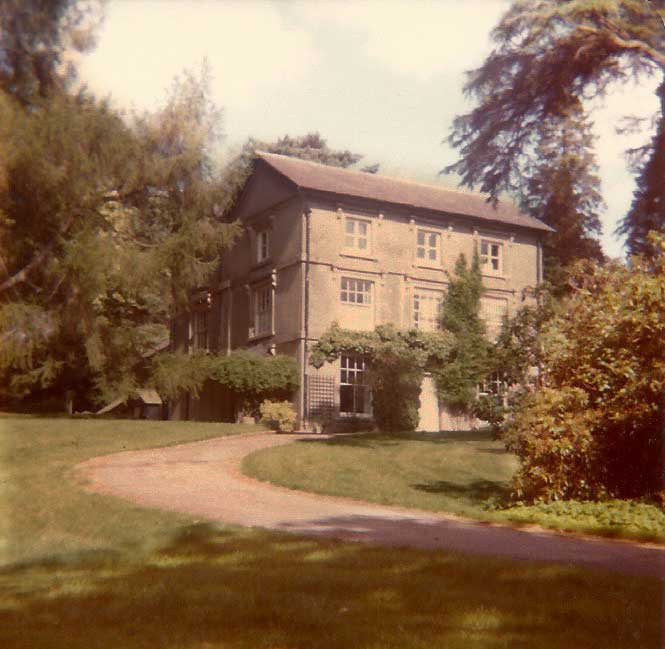 We
first found St Nicholas school in a Hereford Trade directory of 1941. The
school was then in Colwall and the proprietors were Dorothy H Seeley and
Janet Duthy. The school occupied Stephen Ballard's house, The
Winnings, and a descendant of the Ballard family thinks the school
had been evacuated there (ref 38). We
first found St Nicholas school in a Hereford Trade directory of 1941. The
school was then in Colwall and the proprietors were Dorothy H Seeley and
Janet Duthy. The school occupied Stephen Ballard's house, The
Winnings, and a descendant of the Ballard family thinks the school
had been evacuated there (ref 38).
An article in the Birmingham Post Friday 21st July 1939 explains the matter,
to quote:
St Nicholas' School (Girls' Boarding and Day),
Broadstairs is transferring
to Colwall, Malvern, Worcestershire, August 1939 and reopening September
22nd. Qualified staff, Froebel trained Mistress. For further particulars
apply Misses Seeley and Duthie, St Nicholas' School, Broadstairs.
With war imminent Broadstairs on the coast opposite Calais would probably
have lost pupils if the school had not moved and in any event the government
probably instructed people to leave the area. Not far inland from
Broadstairs was
RAF
Manston.
Photo above: The Winnings in 1979, source Jennean Hill. Her mother
Margaret Anne Rawlinson attended St Nicholas school in Colwall during WWII
(ref 37). Margaret's father Ronald had been a shipping agent who worked for
Butterfield and Swire in China before the war. The family
returned to England and purchased Rock House and the Holy Well in Malvern
Wells. After the war the family emigrated from England to Oregon in the USA, where
Margaret's mother had citizenship
Margaret's brother Ronald went to school at Linden Manor,
previously named The Lindens, one of a number of houses built on Stephen
Ballard's estate approached from a long drive near the Wyche cutting.
Click for
photo of Linden Manor. We have not found a school named Linden Manor so
wonder whether it had been a department of St Nicholas' school; another
possibility is that it was part of Wychcrest run by Margaret Yell on the
opposite side of the Wyche cutting (see below).
A Malvern resident remembers going to a sleazy nightclub at
Linden Manor in the 1960s; in the 1970s the property was occupied by Colony
Holidays.
St Nicholas moves from Colwall to North Malvern
After WWII, St Nicholas' School moved to Cowleigh Road, in North Malvern and occupied the
buildings released by Clarendon girls'
school which had moved
to Abergele in 1948.
Tom Hawthornwaite recalls that in 1952 the wife of the vicar of Holy Trinity, Mrs Bamber
used to teach there. It was on the Cowleigh Road, just north of the Hornyold
Road junction, on the right.
The Malvern Gazette reported that the school closed in 1957.
A former pupil relates her memories of attending St
Nicholas Girls' School (ref 32):
I went to St Nicholas School, Cowleigh Road,
Malvern, at the age of eight, leaving at age twelve in 1953 to go to Queen Anne's
School, Caversham.
St Nicholas was a prep school for girls; I vaguely
remember that they were willing take boys up to the age of 7 but only as day
pupils.
The Cowleigh Road building, that is now flats, was the whole of the
main school where we lived and studied, and where the headmistress Miss
Seeley lived at one end of the building.
The dormitories were all named after flowers, with
coloured decor to match; the dormitories Snowdrop and Bluebell were the
ones reserved for the 5 and 6-year-olds. The first dormitory I was in
when I went there aged 8 was Rose, and other flowers were Speedwell,
Iris, Crocus, Primrose, and Daffodil. There were other flowers too but
I'm not sure of the rest of the names now. I think Geranium and Poppy
may have figured but I'm not absolutely sure!
Miss Seeley's deputy was Miss Felton who
eventually became head. The school closed when Miss Felton got married and
no-one suitable could be found to take over the headship.
Applegarth was an
annexe to the school where we played netball in the winter and tennis in the
summer, and where we each had a little plot of garden in which to grow
seeds. We had the brownies and guide camps there in the summer. Staff who
needed local accommodation lived there during term-time.
In the
summer we also used to walk in a crocodile formation each Wednesday
afternoon to the swimming pool at The Winter Gardens, which was in the open
and often very cold. The temperature used to be displayed on a chalk board
outside each day and one day we went there I remember it was 57!
We went to
HolyTrinity church each Sunday, marching in crocodile formation, and the
vicar's wife Mrs Bamber did indeed teach at the school, but I can't now
remember what subject she taught. We did a Nativity play each year in the
Holy Trinity church hall.
When the Queen was crowned in 1953 we had a whole
day off lessons and the boarders watched it all on a hired TV in the
headmistress's sitting-room.
I remember when sweet rationing came to an end
and we were allowed to walk up to a sweet shop to buy sweets for the first
time without our ration books.
We used to celebrate St Nicholas' Day on 6
December with a fancy dress party.
I remember the names of quite a lot of the past
pupils and one or two staff too - Miss Ford taught music and maths, Miss
Thornton taught English, Miss Chater taught ballet. There were
various French teachers but I can't remember their names now. Mrs Teschmaker
taught Geography: she came from New Zealand. There was a Miss Coliver, too,
but I can't remember being taught by her, except that I'm pretty sure she
taught swimming. I certainly remember her taking sessions of rounders and
netball, along with Miss Felton. I was taught to swim at the Winter Gardens
pool and we could progress to do the bronze life saving certificate if we
were good enough.
Riding was offered as an extra, and a few of us were taken
to riding stables on a Saturday morning by taxi for riding lessons, but I
can't now remember where - it might have been Bromyard.
One further memory
that just came back to me! On Sunday evenings all the boarders were invited
to the headmistress's sitting-room to have a book read to us, chapter by
chapter, week by week. I remember a book about Florence Nightingale being
read to us, and also "BlackBeauty". However, Miss Felton had a brother who
wrote under the name Ronald Welch and he wrote a historical novel called
"Knight Crusader" which was read to us on a Sunday evening one term. When I
was to be given a prize at the summer prize-giving and was asked what book
I'd like, I asked if I could have a copy of "Knight Crusader" as when it had
been read to us we all thought it was terrific. They said it was a bit more
expensive that they usually budgeted for but that, as a special concession,
they would agree: I was duly presented it with it at the end-of-term
prize-giving. "Knight Crusader" has been re-printed a number of times so you
could easily get a copy if you're interested. It's a really good story.
Miss Chater, who was mentioned as teaching ballet, also
had a Ballet School down behind Warwick House. A former pupil recalls having
dancing lessons there, age about 6-8 years old, in the 1950s.
Marjorie Hilda Mary Chater, born in 1906, was the
daughter of Thomas Edward Chater, an agent for the Prudential Assurance
Company and Violet Hilda Mary Perry, a theatre pianist. Her brother Algernon
Sydney John Chater (1908 - 1989) had enjoyed various jobs as an artist,
milliner, aircraft designer in the second world war, architect and composer.
Kelly's Trade directory of 1936 records them in Broadstairs where she had a
dance studio and he was a musical director. The 1960 telephone directory
records the Marjorie Chater School of Dancing, 9 Graham Road, Malvern. It
seems that while she used her maiden name for professional purposes,
she had married twice, first to Ralph Francis Lester Palmer in 1933, and
second to Henry Harold Hughes in 1963. Her second husband died at Malvern in
1985, whilst Marjorie herself lived to be 100 and died at Worcester in 2006.
Miss Dorothy Hilda Seeley (1897 - 1970),
the headmistress of St Nicholas, was well qualified to run a faith based
school in so far as she was the eldest daughter of a clergyman. Her father
Rev George Henry Seeley (1865 - 1935) attended
St Bees Theological College in 1886; priest 1889; served mostly abroad in
the Far East; Chaplain to Bishop of Rangoon 1918 - 1821; Rector of
Broome, Worcester 1921 - 1924; he died in 1935 at Wouldham Rectory, near Rochester in Kent.
Dorothy, like her mother Hilda, was born in India. Hilda,
latterly a widow, of Rockland 68 Cowleigh Road, Malvern, died at the Rob Roy nursing home in Hornyold
Road in 1950.
As early as 1911, Dorothy, her mother, and her brothers
were living in Malvern when her brothers were pupils at Hillstone Prep
School in Como Road.
In 1917 Dorothy's eldest brother Roger George Seeley
(1900 - 1954) signed up as a midshipman in the Royal Navy; he survived both
world wars, married and had two children
Dorothy Seeley's brother
Gerald
Henry Seeley was sadly killed in WWII and his name has recently been added to the
War Memorial at Holy Trinity North Malvern.
 Pilot Officer, Air Gunner, 81416, Gerald Henry Seeley,
Royal Air Force Volunteer Reserve,
21 Squadron, died on 23rd July 1941 aged 38 years and is buried in
Belgium. He was born on 9th May 1903 at
Port Blair,
Andaman Islands.
He must also have attended the Link School,
because his name appears on the Link School Roll of Honour which, following
closure of the school, is on a wall in Malvern Museum. Pilot Officer, Air Gunner, 81416, Gerald Henry Seeley,
Royal Air Force Volunteer Reserve,
21 Squadron, died on 23rd July 1941 aged 38 years and is buried in
Belgium. He was born on 9th May 1903 at
Port Blair,
Andaman Islands.
He must also have attended the Link School,
because his name appears on the Link School Roll of Honour which, following
closure of the school, is on a wall in Malvern Museum.
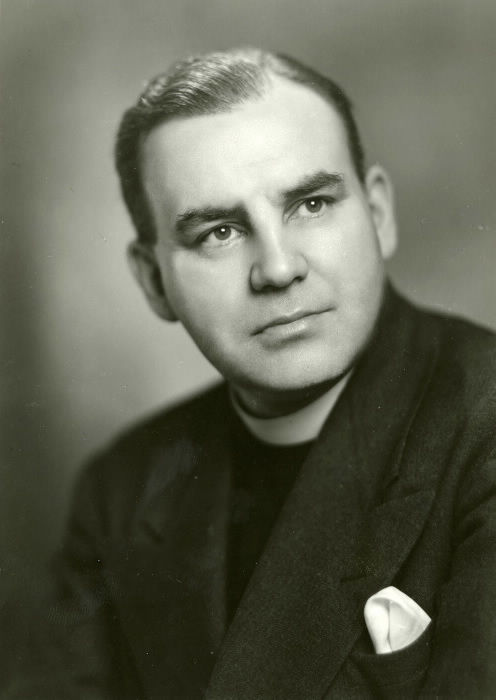 Dorothy's
youngest brother Reginald Sidney Kingsley Seeley (1909 - 1957) was born in
Herefordshire and became a clergyman like his father. He seems to have spent
most of his working life in Canada, where he became Provost of
Trinity
College Toronto 1945 - 1957. Dorothy's
youngest brother Reginald Sidney Kingsley Seeley (1909 - 1957) was born in
Herefordshire and became a clergyman like his father. He seems to have spent
most of his working life in Canada, where he became Provost of
Trinity
College Toronto 1945 - 1957.
See photo opposite, courtesy of the Toronto Public
Library.
Miss Margaret Mayzod Felton, the deputy
headmistress was born in South Wales in 1915, the youngest child of Oliver
and Alice. Her father Oliver was recorded in the 1911 census as an
accountant in the estate office, Margam Park, Port Talbot.
Her brother Ronald Oliver Felton (1909 - 1982) was a
popular author of children's books, such as 'Knight Crusader' published in
1954, under the pen name
Ronald
Welch; he was headmaster of Okehampton Grammar School in Devon from 1947
to 1964.
After attending Berkhamsted School (1922-28), he had
earned a place at Clare College, Cambridge, where he studied history. He
then went on to work as an assistant history master at Berkhamsted before
moving to Bedford Modern School as a senior teacher in 1933. That same year,
Ronald joined the Territorial Army and, during World War II, became a Major
and served in Normandy and Germany.
Their brother John Lewis Seeley became an engineer.
In April 1958, after St Nicholas closed and her father
died, Margaret married company director David Howard Wood, a widower with
three teenage children. Very sadly her husband died after a short illness at
Bromsgrove Cottage hospital a few months later. It is thought she later went
to live in Devon near her brother.
The Malvern Gazette reported on December 5th 1958:
St Nicholas' School, Cowleigh Road, is to be bought by
Malvern Council and turned into 16 flatlets for old people, with one flat
for a resident warden. This was decided after an hour-long debate on housing
at the UDC meeting on Tuesday.
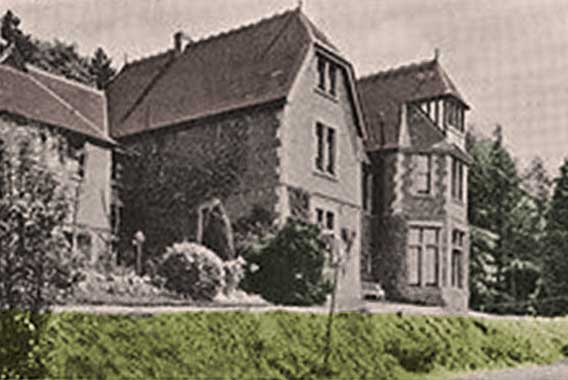 We
came across Wychcrest while researching St Nicholas school in Colwall; a
1941 Herefordshire Trade Directory records: We
came across Wychcrest while researching St Nicholas school in Colwall; a
1941 Herefordshire Trade Directory records:
Yell, Miss Margaret Alice, Wychcrest, Malvern (Worcs)
Margaret Yell was the daughter of Edward Yell who in the
1881 census was recorded as timber merchant employing 15 men.
In 1901 Margaret Yell was a governess in the family of
Rev Cecil Blyth, in Suffolk. By 1911, the year her father died, she had a
small school at Malvernhurst, in Priory Road, Great Malvern.
Kelly's Trade directory of Herefordshire records that by
1917 Margaret Yell had moved her business to Wychcrest:
Yell, Margaret Alice (Miss), preparatory school,
Wychcrest, Upper Colwall
Wychcrest lies on the east side of West Malvern Road near
the Wyche cutting. In 1881 it had been the home of solicitor John Samuel
Canning who died at Wychcrest in 1908.
An advertisement for the school records:
WYCHCREST
Malvern
Head Mistress - Miss Margaret Yell
Wychcrest, a boarding school for girls is situated on
high ground (916 feet above sea level) on the west slopes of the Malvern
Hills, and thus has full advantage of some of the finest air in England,
while at the same time it is sheltered from the north and east.
The aim of the school is to give a thoroughly sound
education in happy surroundings, to train and develop the thinking powers of
the children and to encourage them to take an intelligent interest and
pleasure in their work.
The school is kept small, the number limited to 30 - and
there is a large staff of resident Mistresses; consequently there is no
pressing or cramming, but each child receives individual attention, and in
work, games, health and general, morale is a high one.
Recent examinations success includes a £100 Scholarship
to Wycombe Abbey school, one of £50 to another school, and the Gold Medal
for the Intermediate Grade of the RAM and RCM. The Music and French of the
School are extremely good.
Games are adequately provided for, and the physical
development and health of each pupil are carefully supervised.
Entire charge of children undertaken during the holidays
if parents so desire. Fees: Apply to the Principal.
AA prospectus giving full details will be forwarded on
application to the Head Mistress.
Margaret Yell's retirement was reported in the Malvern
Gazette on Friday March 22nd 1957. Here is a transcript:
Over 50 years in Malvern
Miss Yell leaving Wychcrest
Throughout four reigns, two world wars, and conditions
which have brought profound changes in the field of education, Miss Margaret
Yell has been Principal of the preparatory school which since 1914 has been
established at Wychcrest, Upper Colwall. Pupils have come to it from all over
the country, and many people know it as a school not only where the
foundations of learning are soundly implanted but one at which the essential
elements of character and personality are encouraged to develop in the young
child.
And at the end of this term Miss Yell will be sailing to
Australia, where she will join her sister and her family living ten miles
outside Perth, and so bring to an end an association with teaching in
Malvern that began when she came in 1906 as governess to the boys of Mr HH
House, then a housemaster at Malvern College.
Wychcrest School is being taken over by Miss I Whitmore-Harris who is now teaching at the Alice Otley School Worcester and will go
into residence at Wychcrest next month.
Miss Yell, whose home was at Dulwich, taught at Ambleside
before she came to Malvern. In addition to the sons of Mr House, children of
other College masters came under her care, and presently she took a house
in The Lees; from there the school moved in 1910 to Malvernhurst in Priory
Road. Numbers increased and with arrivals from outside the district bigger
accommodation became imperative; hence the move to Wychcrest in May 1914. In
the 1920s the building was enlarged, and for some years during and after the
Second World War, a neighbouring house was also used.
Miss Whitmore-Harris will continue to take children aged from four to 11, both as boarders and by day. The premises are being
redecorated and she intends to do everything to foster the happy and
intimate atmosphere so long promoted by her predecessor.
The new headmistress is a Bachelor of Science of Bristol
University, and her main subjects are mathematics and science; she will
leave the Alice Otley School at the end of the summer term.
When the war broke out she was teaching in an
international school for girls in Shanghai, the headmistress of which had
gone on leave to Australia. She was unable to return to duty, and Miss
Whitmore-Harris was acting headmistress for 18 months. When the Japanese
overran the country the school was closed and the teachers interned for two
and a half years.
After the war there was no prospect of the school
reopening so Miss Whitmore-Harris returned to England and resumed teaching.
Before going to Worcester two years ago she was a member of the staff of St
Peters School, Surrey. Her present home is in Upper Colwall.
We have found no information about Miss Whitmore Harris,
but it is of note that she was interned by the Japanese during WWII. Can you
tell us more about her?
Wychcrest Preparatory school closed circa 1970 and became a
Childrens' Home
run by Margaret and Norman Parkins. Soon after Norman died the property was
acquired by their accountant who converted it to the Wellingtonia Centre
which was a 12 bedroom hotel, restaurant and bar. The property was renamed
Wellingtonia because of the superb Wellingtonia fir tree by the house (ref
39). The Wellingtonia Hotel was sold it to a restaurateur in 1988 but, after
a year or so, sadly he went bust.
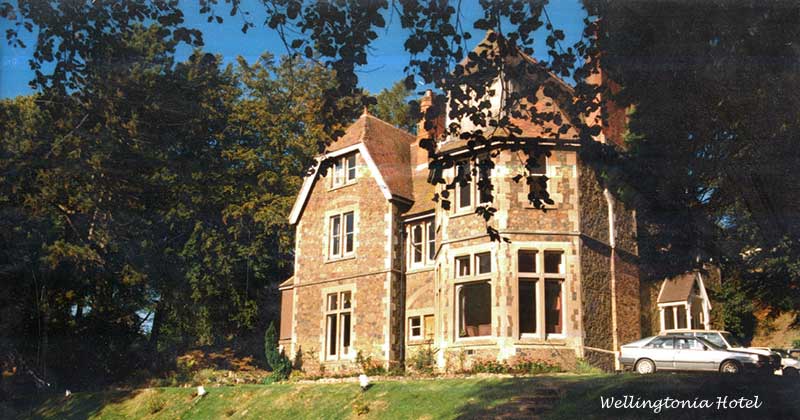
The Wellingtonia Hotel, courtesy of A. Leopard
In 1957, following her retirement, Margaret Yell sailed
to Perth to live with her widowed sister Florence and her family. Sadly
Florence died the next year.
Schoolteacher Margaret Alice Yell died in Australia in
1965.
Her sister, Florence Beatrice Yell had married Harold
Lindley Pilley, the son of an accountant at Dulwich in 1910 and the couple
had two daughters. The Great War intervened and sadly Rifleman 15640
Harold Lindley Pilley, 1/18th London Regiment (6th Royal Irish Fusilliers)
was killed in action in France on March 23rd 1918.
Click to read an account of the fighting about that time
Margaret Yell's
youngest brother Basil Aubrey Yell (1890 - 1936) emigrated from England to Australia
in 1914, just before the outbreak of war. On 17th December 1917 Basil Aubrey Yell, Private 3665
AIF, enlisted at Charters Tower in Queensland. His enlistment papers
indicate he was a Jackaroo and that his application 12 months previously had
been turned down due to poor eyesight. He achieved the rank of Acting
Lance Corporal and survived the war. He had given his sister Margaret Yell
at Wychcrest as next of kin.
The report of Margaret Yell's retirement relates that she
had taught the sons of Harry Hammond House, a housemaster at Malvern College.
Sadly Harry Hammond's youngest son Malcolm was killed in the Great War. De Ruvigny's
Roll of Honour records:
House, Malcolm Hutchinson, 2nd Lieut,
8th (Service) Bn,
The Rifle Brigade (The Prince Consorts Own); 3rd son of Harry Hammond
House, House Master at Malvern College, by his wife Kate Charlotte, daughter
of Carl Marius Sorenson: born Malvern, 12th July 1897; educated
Lockers Park
and Rugby School where he gained and Entrance Scholarship; was a member of
the OTC; head of his house; in the Cricket XI of 1913; Captain in 1915 and
was also in the XV of 1915-16. In Dec 1915 he was elected to a Classical
Scholarship at Corpus Christi College, Oxford; gazetted 2nd Lieut in October
1915; served with the Expeditionary Force in France from the following
December until his death. He was killed by a sniper while moving a Lewis gun
into position (at
Arras) 3rd May1917. Buried behind the trench he had been holding.
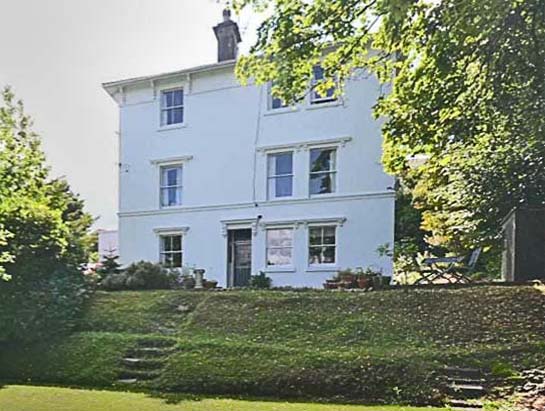 The
1911 census recorded Margaret Yell at Malvernhurst in Priory Road, before she moved to
Wychcrest in Colwall. The
1911 census recorded Margaret Yell at Malvernhurst in Priory Road, before she moved to
Wychcrest in Colwall.
Earlier, we think Malvern College may have used Malvernhurst as
a boarding house. In 1895 housemaster Mr Charles Theodore Salisbury is said to have
opened no 8 boarding house at Malvernhurst, moving to Malvernbury in 1903
and Radnor House in 1906.
Whitaker's Peerage, 1921, contained the following
advertisement for the prep school:
Malvernhurst, Priory Road
Principal M D R Rom
Receives a small number of boys for general
Education or to prepare for Public Schools, Army or Navy. Steady and regular
attention given to the individual needs of each pupil. Development of
character and manners specially attended to. Modern Languages
conversationally taught are a special feature. Backward and delicate boys
receive special attention. Entire charge taken of Colonial boys. Fees £90 to
£150 per annum.
We know nothing of MDR Rom, but he may have been the
Maurice DR Rom who married Marjorie Surman (1890 - 1980) at Worcester in
1918. She was the daughter of Worcester surgeon-dentist Robert John
Surman.The 1922 phone book confirms MDR Rom running a boys' school at
Malvernhurst - can you tell us who he was and what became of him?
Trade directories record Edward Stanley Roberts as the
next headmaster from 1924 to 1928, and the phone book records the telephone
number of the school as Malvern 344.
We think Edward Stanley Roberts was the son of a draper
and outfitter, born at Oswestry in 1890. In 1911 he had been a schoolmaster
at
St Saviours College, in Sussex - now
Ardingly College
which had been founded in 1858. Ardingly was one of three schools founded in that area of Sussex by the
Rev Nathaniel Woodard (1811-1891) who believed fervently in the
importance of religion in education. Rev Woodard seems to have had no money
of his own, but had a talent for getting the wealthy to subscribe to his
endeavours. Another famous school he founded was
Lancing
College.
After 1928 it seems Edward Stanley Roberts, went into
partnership with John Edward Healey and Christopher Watson who were running a Boys'
Preparatory School at St Cuthbert's on the
Worcester Road. The London Gazette
records that Edward left the partnership in November 1931. We don't know what
became of him after that, but just possibly he was the Edward Stanley Roberts who
died in Rhodesia in 1964.
By 1930 the school had closed, probably flats, because
Malvernhurst was then the residence of Captain and Mrs Lionel Erskine Hall. On 10th July 1930
the Times had reported the engagement of their son
Douglas Basil Hall, later Sir Douglas Basil Hall, 14th Baronet, KCMG
(1909 – 2004) a British colonial administrator. He served as the
last Governor of the British Somaliland Protectorate before its independence.
The Dundee City archives record that a Mrs M M Erskine of
Malvernhurst had registered a 12.8 HP Citreon car registration SR7888 on the
13th April 1931. Possibly she was related to the family but, if there were a
connection, we have not found it.
Connellan College was short-lived. It was opened in 1888
at Townshend House in College Road by
Rev William Walker (1838 - 1915) who
had earlier been headmaster at Hanley Castle Grammar School and then
Reading Grammar School. Perhaps this venture was enabled by his wife
receiving a sizeable inheritance in 1883 from her cousin Hugh Connellan a
shopkeeper of Sligo in Ireland.
It might be thought that this school had good
prospects as a potential feeder school for Malvern College next door, but in
1890 the family upped sticks when Rev William Walker became a schoolmaster
at a prep school known as Thorp Arch Grange in Yorkshire.
Thorpe Arch Grange school had been started by Richard
Hiley circa 1855 who passed the school to his son Rev Richard William Riley
in 1861. Rev Riley retired in 1891, and sold the property in 1895, so Rev
William Walker may have been the acting headmaster.
In 1891 Connellan College became a small Roman Catholic
(Benedictine) monastery until 1918 when the property was acquired by Malvern
College. During the period of occupation by the monastery, St Edmund's Romal
Catholic church, which opened in 1905, was built next door.
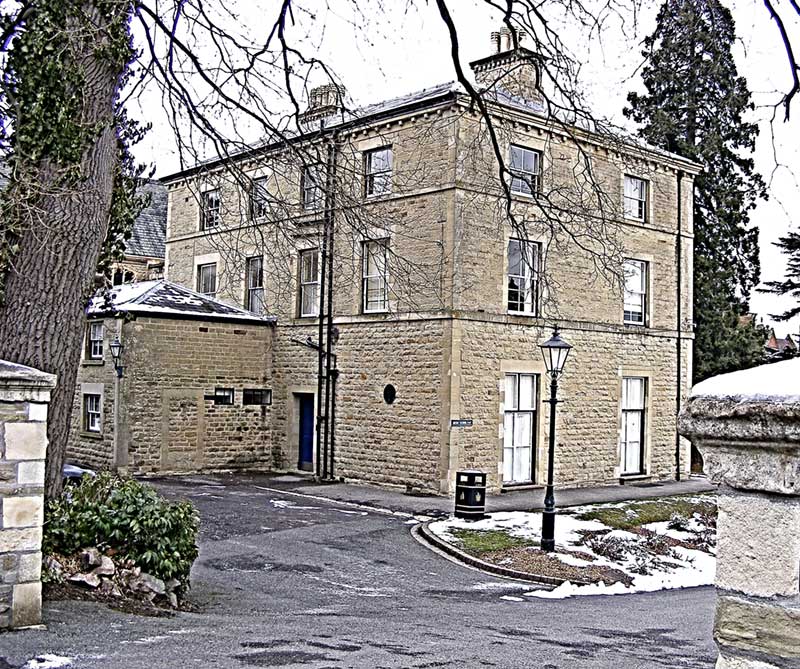
The former Connellan College, previously Townshend House
From 1850 to 1880 Townshend House had been the home of
Dr
Ralph Barnes Grindrod, one of Great Malvern's water cure doctors, who was also an
amateur geologist and a vigorous campaigner for the Temperance movement.
We keep coming across other schools that we have not written about.
In 1900 and 1904 Trade directories there is mention of:-
Government School of Art, Church Street, Cheyne MacKinlay
headmaster.
Duncan Cheyne MacKinlay was born in Scotland in 1844 and
died in 1932 leaving a widow, Lizzie. In 1901 he had been living in Malvern
at a house named Healey, in Barnards Green Road; the census recorded him as
an Artist (sea life).
By 1912 he had moved on to Hertfordshire, and by 1927 he
was in Yorkshire. He
is not listed in the Dictionary of Victorian Painters, and we have not found
any example of his work.
Back to top
The Lansdowne Wesleyan School, run in rooms below the Methodist
church in Lansdowne Crescent, (see photo left) opened in 1876
and closed in 1916, when pupils moved to the new Great Malvern School in
Pickersleigh Road.
Lord Beauchamp opened a boarding school at the Newland Community to provide a choir for St
Leonard's circa 1870 which was finally closed in 1945.
Lyttelton Grammar School was a Church School of about 60 places set up
about 1874 to educate the middle classes, such as the sons of tradesmen, and provide a choir for
Great Malvern Priory (ref 7). It
closed in 1946, because of difficulty meeting new government requirements;
Essentially the school had insufficient funding and was
too small.
The Lyttelton School used the old Sunday School rooms which had been
built by Lady Apphia Lyttelton in 1817 and were then rebuilt in 1886 (see photo
below). After closure, the nearest
grammar schools were then in Worcester and at Hanley Castle.
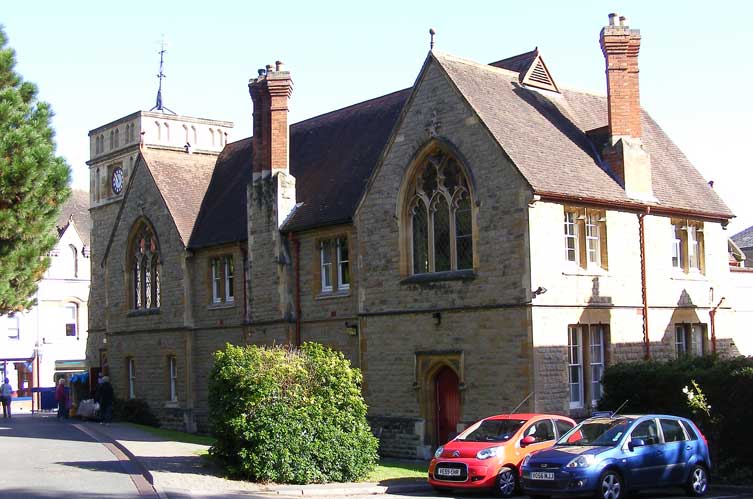
In view of the need to provide more Secondary School places
the Church
of England had
begun fund raising about 1936 to build a larger school in Yates Hayes Road.
Building of the school was delayed by lack of funds and WWII. It was at
first to
be named the Lyttelton School. However, the new school did not open until
1958 when it was called Dyson Perrins after another generous benefactor.
You can read more about philanthropist Charles William
Dyson Perrins on our page about Davenham.
According to Littlebury's Directory, the first Guarlford
National (church) School opened about 1848 and was expanded in 1867. The school stood
next door to the church which had opened in 1844.
The photo below, from the book 'The Guarlford Story',
which has a chapter about the village school (ref 8) shows the School and
School House.
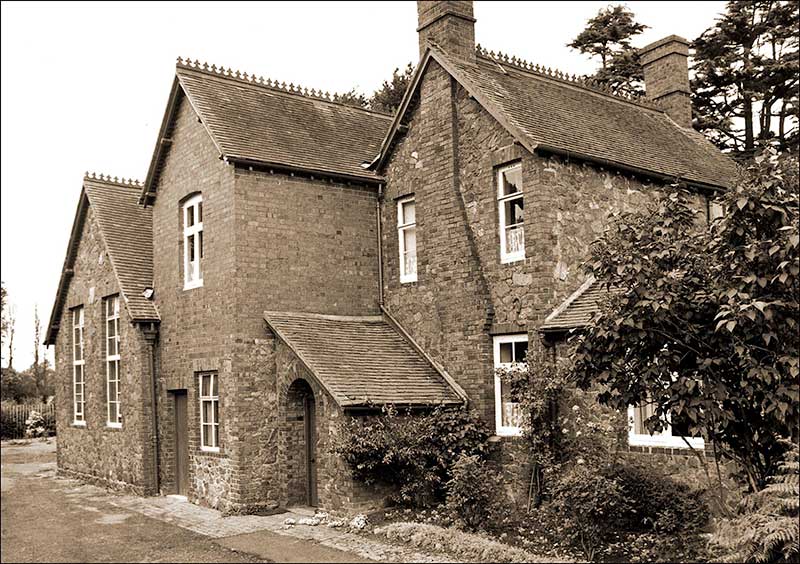
Many of the children were the sons and daughters of
agricultural workers, and attendance dipped during harvest time!
The school closed in 1946 when the last infants
transferred to Madresfield. Closure was due to both a drop in numbers and deterioration of
the classrooms.
In modern times the school was demolished and replaced by
two houses built on the site of the master's house, school and playground. All that
apparently remains is the boundary wall of the playground between two
properties on the south side of the churchyard.
North Malvern C of E Primary School was the first National School to open
in Malvern. It was opened in 1836 and rebuilt in 1838 with the help of a
local benefactor called Charles
Morris. It had been in need of modernisation for many years
when Cowleigh School, built 1885, was burnt down in 1989. Both schools were
then replaced by the new Northleigh School in 1991.
Poolbrook state primary school was built in 1977 as an infants school and
became a primary school in 1987. There were problems and it closed December 31st 2008.
Back to top
Schools jointly funded by either the Church of England or RC Church and the state.
In some cases benefactors contributed to the cost of new buildings. You will
find out more about them if you click on the links to their websites
(below).
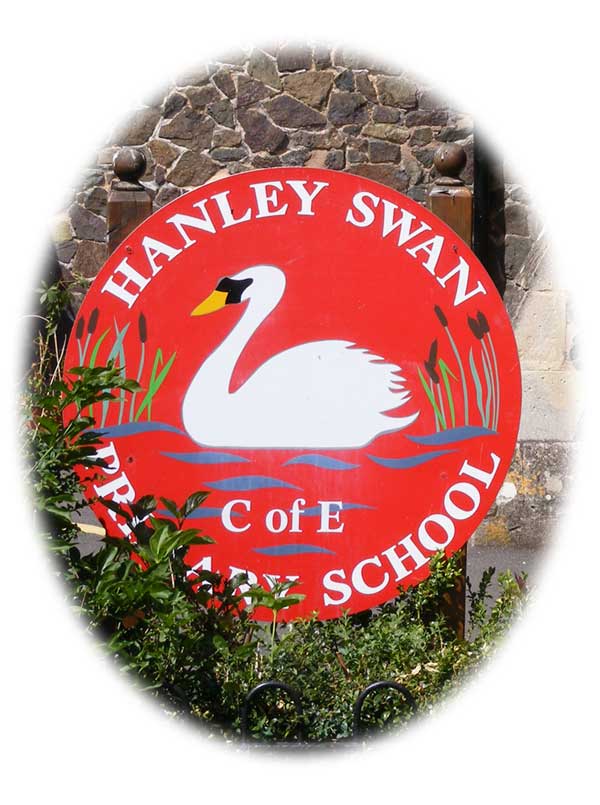
Malvern Parish, formerly known as Mill Lane
National School
St Matthias
Northleigh
Wyche
St
James West Malvern
Hanley
Swan C E Primary school
Madresfield C
E Primary school
St Joseph's
Catholic Primary school
Dyson
Perrins C of E Academy
Malvern
Wells C of E School
Malvern Wells C of E school was once named Warrington C
of E school after benefactor, Eliza Warrington; here is a
little more about her.
Eliza Warrington
Kelly's directory of 1940 listed Warrington C of E School, Malvern Wells,
and we wondered how the name Warrington arose.
About 1885
philanthropist Eliza Warrington who lived nearby, at 'The Belvedere' on the
eastern slope of the Malvern Hills, funded a new building for the Malvern
Wells Church of England School. Previously school had been held in the village
hall.
The inscription
above the door of the building reads:
1885
National School
Erected and Presented
by
Eliza Warrington
of The Belvedere
Malvern Wells
Eliza Warrington also generously gave to the 'Worcester School for the Blind',
including land for the present building at Whittington. Nowadays the
establishment is named
New College
Worcester; the main part of the school building is said to be still
known as the Warrington wing.
Eliza Warrington is buried at St Mary, Hanley Castle. You
can read more about her in a 'A
short biography of Eliza Warrington by BW Ferris'; this interesting
biography includes pictures of her home.
Great
Malvern, Lydes Road, off Pickersleigh Road, opened in 1916.
It took the children from the Wesleyan school in Lansdowne Crescent.
The Grove,
Pickersleigh Road
This school opened in 1960 in Pickersleigh Grove, Malvern Link, initially
for 5 to 8 year olds. Due to increasing numbers a new school was built in
1966 for 120 infants and 215 juniors.
Somers Park Primary School, Somers Park Avenue in Malvern
Link, opened
about 1909. It was the first secular primary school in Malvern.
The Chase School
The Chase was the first state secondary school in Malvern
and opened in 1953. It became a comprehensive in the 1970s; in 2010 the
Chase, with three specialist designations in Technology, Languages and
Science, was a co-educational comprehensive day school administered by the
Worcestershire Directorate of Children's Services, serving Malvern and the surrounding villages, admitting
students aged 11 to 18 (source: The old Chase Technology Centre website).
Under the auspice of the Conservative Government
Academy Trust scheme, on 4th October 2011 'The Chase School' became a
Company Limited by Guarantee (company number 07800306) receiving its funding
direct from central government, rather than through the Local Authority.
Malvern College
Malvern College located in College Road is one of Great Britain's
foremost coeducational private schools.
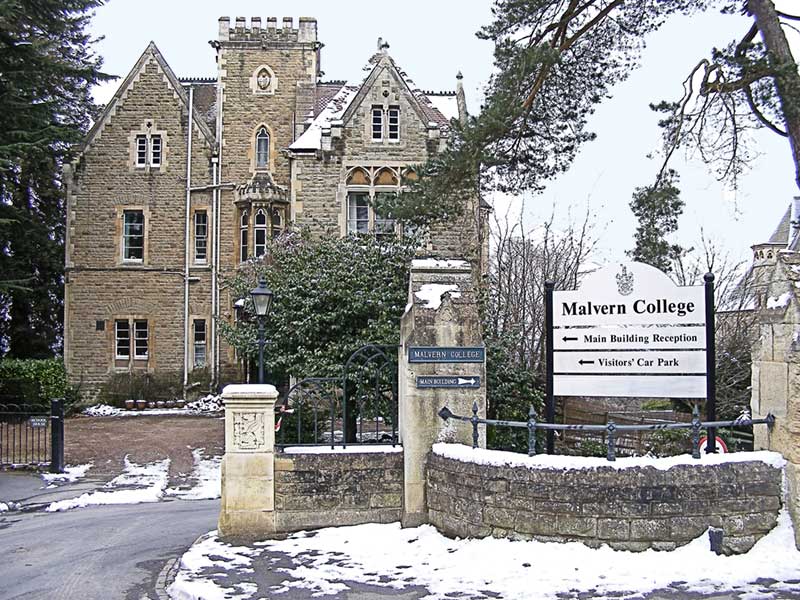
Entrance at School House
The first boys arrived at Malvern College in Radnor Road,
now named College Road, Great Malvern, in January 1865.
The school buildings were designed by architect
Charles
Francis Hansom brother of Joseph Hansom who invented the horse-drawn
Hansom cab.
Proposals for the school had been discussed at a meeting
on 22nd August 1862 in Dr Gully's dining room at the Imperial Hotel, with
the Bishop of Worcester in the chair. At a further meeting The Malvern
Proprietary College Company Ltd had been formed with 500 shares of £40 each.
Frederick Lygon MP (later sixth Earl Beauchamp) was elected chairman, and
the German water cure doctor Leopold Stummes honorary secretary (ref 15).
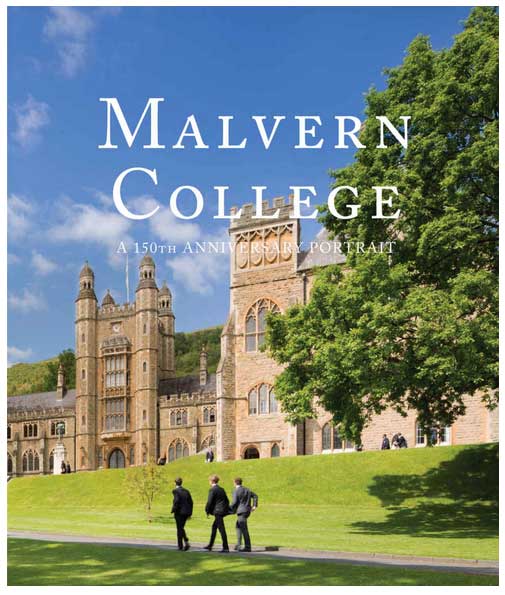 To mark the 150th anniversary of the school, a
new book has been published: To mark the 150th anniversary of the school, a
new book has been published:
'A 150th Anniversary Portrait'
By former head of History Roy Allen
ISBN 13 0978-0747813057
This contains an illustrated history of the school which will be of
interest to past pupils, teachers and historians alike.
Please click link for more information about the school:
Go to Malvern College
website
On the
Malvernian Society website you will find a
150th Anniversary DVD about the school.
The Downs
Many pupils now enter the school from The Downs prep school located on the other side
of the Malvern Hills at Colwall.
Go to the
Downs, Malvern, website
The Elms
Besides the Downs prep school in Colwall, there is
another, perhaps lesser known school, named The Elms, which was founded many
years ago. We don't know much about it so please click the link below to
contact the school and
find out more:
Click to go to The Elms
website
Malvern St James Girls' School
Malvern St James, located in Avenue Road, is one of the foremost private
Girls' Schools in the country, taking both boarders and day pupils.
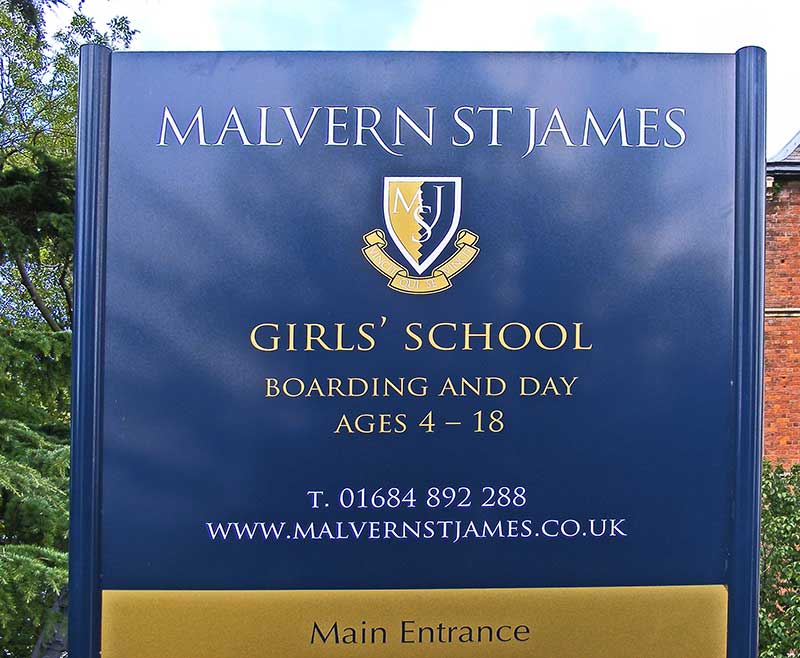 The
school has gradually grown from small beginnings in 1893, taking over the
Imperial Hotel in 1919, and combining with other schools to
become one of the best known girls' schools in the country. The
school has gradually grown from small beginnings in 1893, taking over the
Imperial Hotel in 1919, and combining with other schools to
become one of the best known girls' schools in the country.
For more information about the school click the link below:
Go to the
Malvern St James website
If you are interested in how the school has evolved, click to go to our page
about Elizabeth Greenslade and other founders:
Read about the founders of Malvern St James
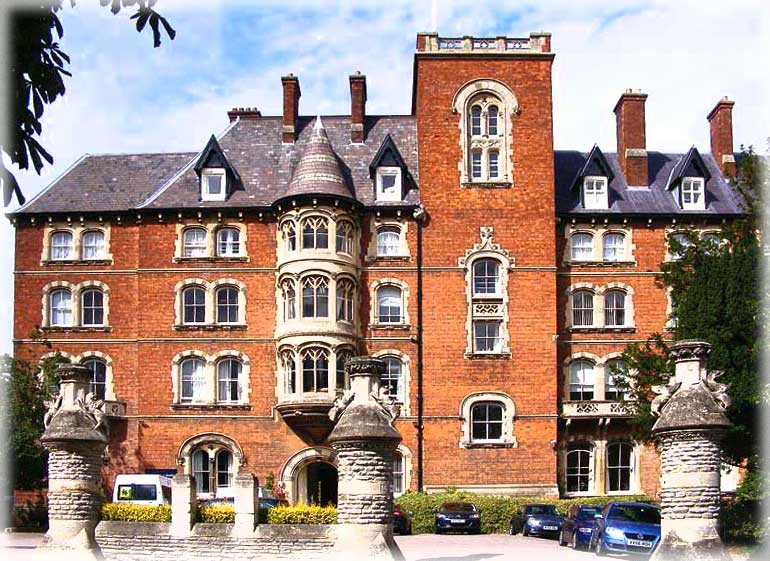
A glimpse of the former Imperial Hotel
Madresfield Early Years Centre
Madresfield Early Years Centre is a first class
childrens' nursery school located on a working dairy farm in the village of
Madresfield near Malvern.
Click to go to the Madresfield Early Years
Centre website
There is now a sister establishment on the edge of
Worcester which opened in 2015.
Click to go to
the Worcester Early Years Centre website
You will find black and white photographs of some of the
old school buildings in Keith Smith's book 'Around Malvern' (ref 30)
including, Mowbray Collegiate School for girls in Victoria Road, started
about 1908 by Mrs Garner; the rear of Wellington House in Abbey Road;
Malvernbury in Abbey Road, which originally had 5 storeys; Ellerslie in
Abbey Road and its swimming pool; the Imperial Hotel, now Malvern St James;
Malvern College and its shop; St Cuthbert's boys' school started by John
Healey about 1904; The Link School, built as the Railway Hotel in 1861; The
Convent of the Cross, Cowleigh Road circa 1916 now split into flats known as
Cowleigh Court; St Edwards Orphanage in West Malvern opened in 1881 and
closed in 1944; The Girls' Friendly Society Home in Malvern Wells, now
flats; rear of The Abbey School, Malvern Wells; The Manse, Malvern Wells,
circa 1916; and the interior of St Richard's School, Little Malvern.
-
Gill Holt, Malvern Voices, Schools, an oral history, published by Malvern
Museum 2002.
-
Christine Bannister, Apphia Lady Lyttelton, From the
Cotswolds to Malvern by way of India 1743 - 1840, published by Aspect Design
2011.
-
Pamela Hurle, Malvern Girls' College, A Centenary
History, published by Phillimore and Co Ltd, 1993.
-
Reminiscences of friends who went to school in
Malvern.
-
Daphne Drake, The History of Malvern Link, papers
deposited in Worcester Records Office 15 Sep 1982.
-
Lawnside, The History of a Malvern School (1852
- 1994) compiled by Mary Dixey and Duseline Stuart. Printed by Severnside
Printers, 1996.
-
Grierson Janet, Dr Wilson and his Malvern Hydro,
distributed by Malvern Museum and printed 1998 by Aldine Press ISBN 1
873809 32 8
-
Cooper David, The Lyttelton, The School and the
Malvern Priory Choir, printed by First Paige, 1991.
-
Hill Don et al, The Guarlford Story, printed by Print
Plus, Hereford, 2005, ISBN 0-9550498-0-6
-
Private communication, G Taylor
-
Young D J, The Story of the Malvern Council House,
printed by First Paige, Malvern, 1991.
-
Brazier A, Douglas House, Malvern Museum
-
Private communication, David Green
-
Trade Directories
-
Malvern College 125 years, The Malvernian Society
1990
-
England and Wales Census
-
National Probate Register
-
Brooks Alan and Pevsner Nikolaus, The Buildings of
England, Worcestershire, Yale University Press, 2007.
-
Communication from Prof Dr G Myers, July 2015
-
Communication from William Shelford, October 2015
-
Communication from G Vose, December 2015
-
Communication from Peter Gibbs, January 2016
-
Communication from John Webb, February 2016
-
Weaver Cora, Bruce Osborne, Aqua Malvernensis, the
springs and fountains of the Malvern Hills, Aldine Press 1994
-
Evans David, Appointments with the Dream Fairy, a
memoir, Tusitala Press, 2014, available as either a paperback or Kindle
download.
-
Smith, Keith, The Archive Photograph Series, Around
Malvern, 1995
-
Communication from Jeremy Palmer, March 2016
-
Littlebury's Trade Directory of Malvern 1873
-
Cuthbertson, Michael J, the history of Clarendon,
Monkton Combe School website
-
Smith, Keith, The Archive Photograph Series, Around
Malvern, published by Chalford, 1995, ISBN 0 7524 0029 0
-
Communication from S Duncan, May 2016
-
Communication from P Riley, July 2016
-
The Times Digital Archive
-
Hillstone and Hampton, Malvern College co-educational
boaring and day school, 2004, DVD
-
Communication from G Williams, November 2016
-
Stevens' Directory and Gazetteer 1901
-
Communication from Jennean Hill, January 2017
-
Communication from Susan Bond, Colwall Archivist,
February 2017
-
Communication from Adrian Leopard, April 2017
-
Communication from Robert Kerrs, April 2017
-
Retirement of Margaret Yell, Malvern Gazette, March
22nd 1957
-
Communication from David Green, August 2017
-
Communication from Carleton Tarr, October 2017
-
Communication from Ian Simpson, February 2018
-
Communication from Pamela Towill, November 2019
-
Communication from John Boocock, December 2019
-
Communication from Diana Moores, October 2020
-
Communication from Everett Jones, November 2020
-
Communication from Nick Symes, January 2021
-
Communication from Peter Tootill, April 2021
-
Communication from Jim Appleton, May 2021
-
Communication from Paul Ferris, May 2021
-
Communication from Gerald Brisch, May 2021
-
Leinster-Mackay, Donald P. (1971) The English private
school 1830-1914, with special reference to the private proprietary
school, Durham theses, Durham University.
Click to view online
-
Communication from R Clarke, September 2021
-
Arno Rose, Not the Front Stairs! A history of Douglas
House School, Malvern, from 1948 - 1970, published by Aspect Design
2021, ISBN 978-1-912078-06-6.
 Back to top Back to top
Please email the webmaster either to suggest
corrections or tell us more about past Malvern schools and recollections of
schooldays.
|

 Contents
Contents



 Alan Blumlein was the lead engineer on the wartime H2S
Radar Project and was sadly killed when his Halifax trials aircraft crashed near Goodrich
Castle.
Alan Blumlein was the lead engineer on the wartime H2S
Radar Project and was sadly killed when his Halifax trials aircraft crashed near Goodrich
Castle.

 The
photo opposite shows Mildred, the wife of the headmaster, with two pupils.
The
photo opposite shows Mildred, the wife of the headmaster, with two pupils.










 The
postcard dated 16th September 1911 was written by Wilfrid Ord to his sister
Evelyn in Bristol and reads:
The
postcard dated 16th September 1911 was written by Wilfrid Ord to his sister
Evelyn in Bristol and reads:



 Surviving
in Malvern Museum can be found the Link School's 2nd World War Roll of
Honour (see photo opposite, courtesy of Malvern Museum).
Surviving
in Malvern Museum can be found the Link School's 2nd World War Roll of
Honour (see photo opposite, courtesy of Malvern Museum).









 By
1911 the expanded establishment was called 'The College for Girls' and the
joint Principals were Isabel Greenslade, Lily Poulton and Blanche Eleanor
Mitchell.
By
1911 the expanded establishment was called 'The College for Girls' and the
joint Principals were Isabel Greenslade, Lily Poulton and Blanche Eleanor
Mitchell.










 Fonthill College
located in Abbey Road was a small boarding school for young ladies aged
between about 11 and 17 years; it was in existence from about 1880 to 1912. The
property, now named Salisbury, is shown in the photo opposite.
Fonthill College
located in Abbey Road was a small boarding school for young ladies aged
between about 11 and 17 years; it was in existence from about 1880 to 1912. The
property, now named Salisbury, is shown in the photo opposite. Chadsmore
(shown) appears the twin of St Chads, next door
Chadsmore
(shown) appears the twin of St Chads, next door


 On
the wall of the lodge was a green plaque placed by Malvern
Civic Society in 1992.
On
the wall of the lodge was a green plaque placed by Malvern
Civic Society in 1992.







 A modern advertisement for
A modern advertisement for

 In February 2016 a former pupil kindly sent us
information about The Hill School, which was a preparatory boarding school
for boys. The school was situated above the Worcester Road in Great Malvern,
just north of the present TV mast and not far from Brays department store.
It was
approached by a narrow drive off the Worcester Road.
In February 2016 a former pupil kindly sent us
information about The Hill School, which was a preparatory boarding school
for boys. The school was situated above the Worcester Road in Great Malvern,
just north of the present TV mast and not far from Brays department store.
It was
approached by a narrow drive off the Worcester Road. Next in residence was Mary Hind, the daughter of a
Liverpool merchant, with a sister and two nieces Mary Emma and Eliza Fenton;
their father Captain Lewis Fenton, 55th Regiment of Foot, briefly Whig MP
for Huddersfield, had died in Huddersfield in 1833 and their mother in 1837.
Mary Hind and her nieces moved across the road to Aucott House (see
opposite) where she
died in 1878. Eliza, the youngest niece, married Major David Mortimer Murray,
the son of a clergyman, in 1861, but died childless in 1869. He is buried
Next in residence was Mary Hind, the daughter of a
Liverpool merchant, with a sister and two nieces Mary Emma and Eliza Fenton;
their father Captain Lewis Fenton, 55th Regiment of Foot, briefly Whig MP
for Huddersfield, had died in Huddersfield in 1833 and their mother in 1837.
Mary Hind and her nieces moved across the road to Aucott House (see
opposite) where she
died in 1878. Eliza, the youngest niece, married Major David Mortimer Murray,
the son of a clergyman, in 1861, but died childless in 1869. He is buried













 Douglas House School opened in 1948 in the Old Vicarage,
which later became the Osborne Hotel. The Principal was Mrs Owen-Williams; there were
then 12 pupils.
Douglas House School opened in 1948 in the Old Vicarage,
which later became the Osborne Hotel. The Principal was Mrs Owen-Williams; there were
then 12 pupils.











 This 1950 photo is looking across the lawn to the west
side of the main school building
This 1950 photo is looking across the lawn to the west
side of the main school building
 We
first found St Nicholas school in a Hereford Trade directory of 1941. The
school was then in Colwall and the proprietors were Dorothy H Seeley and
Janet Duthy. The school occupied Stephen Ballard's house, The
Winnings, and a descendant of the Ballard family thinks the school
had been evacuated there (ref 38).
We
first found St Nicholas school in a Hereford Trade directory of 1941. The
school was then in Colwall and the proprietors were Dorothy H Seeley and
Janet Duthy. The school occupied Stephen Ballard's house, The
Winnings, and a descendant of the Ballard family thinks the school
had been evacuated there (ref 38). Dorothy's
youngest brother Reginald Sidney Kingsley Seeley (1909 - 1957) was born in
Herefordshire and became a clergyman like his father. He seems to have spent
most of his working life in Canada, where he became Provost of
Dorothy's
youngest brother Reginald Sidney Kingsley Seeley (1909 - 1957) was born in
Herefordshire and became a clergyman like his father. He seems to have spent
most of his working life in Canada, where he became Provost of
 We
came across Wychcrest while researching St Nicholas school in Colwall; a
1941 Herefordshire Trade Directory records:
We
came across Wychcrest while researching St Nicholas school in Colwall; a
1941 Herefordshire Trade Directory records:
 The
1911 census recorded Margaret Yell at Malvernhurst in Priory Road, before she moved to
Wychcrest in Colwall.
The
1911 census recorded Margaret Yell at Malvernhurst in Priory Road, before she moved to
Wychcrest in Colwall.
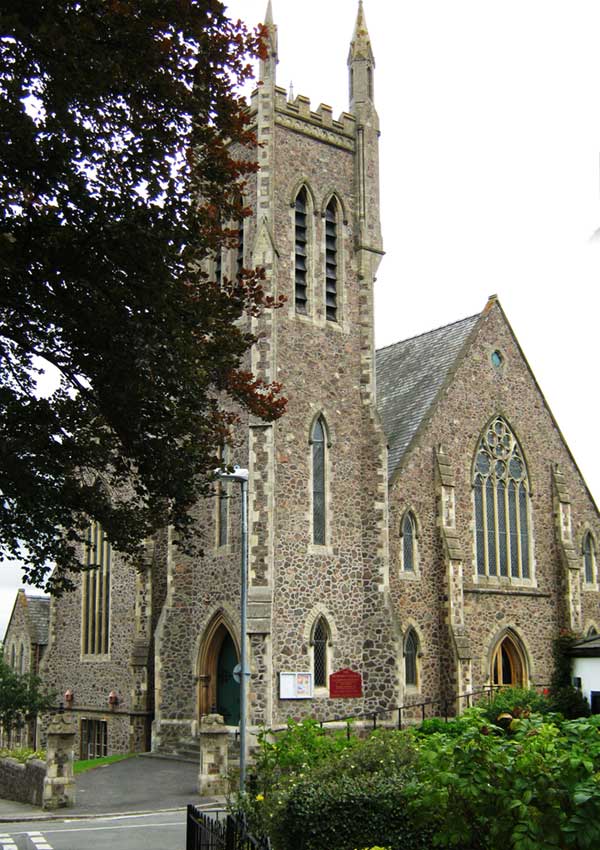 Lansdowne
Lansdowne



 To mark the 150th anniversary of the school, a
new book has been published:
To mark the 150th anniversary of the school, a
new book has been published: The
school has gradually grown from small beginnings in 1893, taking over the
Imperial Hotel in 1919, and combining with other schools to
become one of the best known girls' schools in the country.
The
school has gradually grown from small beginnings in 1893, taking over the
Imperial Hotel in 1919, and combining with other schools to
become one of the best known girls' schools in the country.
